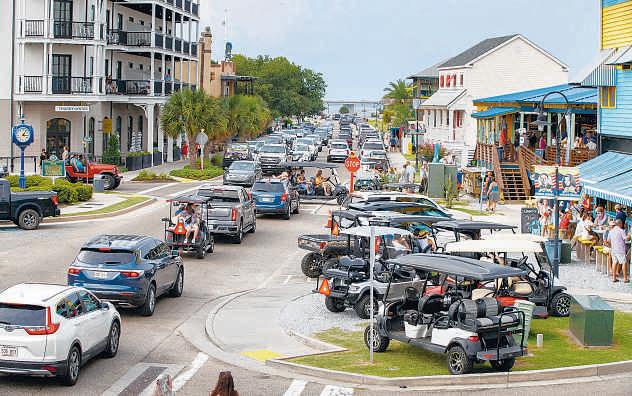

GROWTH ON THE COAST
Tourism along the Gulf gets a boost after pandemic with new vacation condos, airports
BY POET WOLFE and STEPHANIE RIEGEL Staff writers
Jeff and Kristina Russell and their three kids skipped their annual trip to the South Carolina shore this summer and packed their bags for Pass Christian, Mississippi, instead
Over several days in late June, the Illinois family soaked up the waterfront, boated to barrier islands and wandered through the oak-shaded streets of nearby Ocean Springs.
It wasn’t their typical vacation destination, but that was the point.
“We wanted to see something different,” said Jeff Russell, pausing during a stroll down Government Street in Ocean Springs on a recent Friday afternoon. “It’s laid back It’s not overrun like Myrtle Beach.”
The Russells are among a growing number of visitors flocking to the Mississippi and Alabama Gulf Coast from afar Long a popular drive-in destination for regional travelers, in recent years, the area has become increasingly popular among tourists from other parts of the country as well.

People order at Pop Brothers in Ocean Springs, Miss., on Wednesday.
Flash flooding kills at least 37 in Texas
Search continues for missing as storm continues to pound the state
BY JIM VERTUNO, JULIO CORTEZ and JOHN SEEWER Associated Press
KERRVILLE, Texas Rescuers scoured flooded riverbanks littered with mangled trees Saturday and turned over rocks in the search for more than two dozen children from a girls’ camp and many others missing after a wall of water blasted down a river in the Texas Hill Country The storm killed at least 37 people across the state, including 14 children.
Some 36 hours after the floods, authorities still have not said how many people were missing beyond 27 children from Camp Mystic, a Christian summer camp along a river in Kerr County where most of the dead were recovered.
The destructive fast-moving water rose 26 feet on the Guadalupe River in just 45 minutes before daybreak Friday washing away homes and vehicles. The danger was not over as torrential rains continued pounding communities outside San Antonio on Saturday and flash flood warnings and watches remained in effect.
Searchers used helicopters, boats and drones to look for victims and to rescue people stranded in trees and from camps isolated by washed-out roads.
ä See FLOODING, page 5A
‘Little Cajun
Saint’ a step closer to official sainthood
Vatican approves investigation into life of Charlene Richard
Staff report
The Vatican has officially accepted and approved the investigation into the life of Charlene Richard, “the Little Cajun Saint,” according to the Charlene Richard Foundation.
Charlene, a Richard native, died from acute lymphatic leukemia when she was 12 years old. She is known for offering her suffering up for others.
While the latest step brings Charlene one step closer to officially being declared a saint in the Catholic Church, the Rev Korey LaVergne, of St. Edward Roman Catholic Church, where Charlene is buried, told KLFY it’s a step that cements her story in church history

ä See COAST, page 4A
Driven in part by pandemic-era demand for beach vacations and supported by an increase in new hotel rooms and condos and more direct air service — Gulf Shores has its own international airport now — accessing the coast has gotten easier. And beachgoers can find lodging at price points that range from budget motels to luxury whole-house rentals. As coastal communities from Bay St. Louis to Perdido Key geared up for the peak of the season this holiday weekend, tourism officials and local business owners said summer 2025 is shaping up to be a strong year, after a record 2024 that saw nearly 6.5 million visitors in Baldwin County, Alabama — Fort Morgan, Gulf Shores and Orange Beach — alone. “Our drive-in market, Louisiana, Mississippi and Alabama, is still our bread and butter,” said Brandy Davis, marketing director with Beachball Properties, which manages 350 rental units along the Alabama coast. “But we are getting a new crop of people from as far away as Virginia, Missouri and Ohio.”
ä See RICHARD, page 4A


STAFF PHOTOS By DAVID GRUNFELD
Downtown Bay St. Louis bustles with residents, visitors and vehicles on Saturday. Coastal cities like Bay St. Louis, Ocean Springs, Gulf Shores and Orange Beach are fueled by tourists who come for the beaches, restaurants and nightlife.
Holiday marked by shootings in many cities
INDIANAPOLIS Ind This year’s Fourth of July holiday was marked by multiple shootings across the U.S., including one in Indianapolis that left at least two dead and a police chief voicing public frustration over the latest acts of violence in his city.
Indianapolis Metropolitan Police Chief Chris Bailey told reporters early Saturday morning that the mayhem was “completely unacceptable and unnecessary” and that parents and guardians needed to better control their children.
“Hundreds of unsupervised kids down here,” he said, while speaking in the city’s downtown.
“I don’t know how many times I had to say it: We are not your children’s keepers. You are! And parents and guardians have got to step up. A kid is dead tonight.”
Mass shootings were reported in other cities, including Philadelphia and Chicago and Brockton, Massachusetts, where six people were hospitalized following an early morning fight on Saturday
The shooting in Chicago, which left seven people in serious or critical condition, came on the heels of another mass shooting that happened late Wednesday in a busy neighborhood known for its restaurants and nightlife. Four people were killed and 14 others injured.
In New York City, police said one person was dead and three injured following a post-fireworks triple stabbing.
A Wareham, Massachusetts, man is dead after being hit by a firework. Police said they found 70-year-old Robert Spagnuolo with a “facial injury.” He was pronounced dead at the scene.
Officials in Georgia reported two boat explosions on lakes on Friday
Seven people ranging in age from 5 to 45 suffered secondand third-degree burns when a boat exploded on Lake Lanier, according to the Georgia Department of Natural Resources.
Seven more people suffered burns when a boat exploded and then sank on Lake Nottely, the department said.
Chantal forecast to bring heavy rain to Carolinas
MIAMI Tropical Storm Chantal formed off the southeast U.S. coast and was forecast to bring heavy rains to parts of the Carolinas on Saturday. Tropical storm warnings were issued for portions of the two states, the National Hurricane Center in Miami said.
At 4 p.m. CDT, the storm’s center was located about 95 miles southeast of Charleston, South Carolina. Its maximum sustained winds were clocked at 45 mph, and it was moving north at 7 mph
The storm’s center was expected to move across the coast of South Carolina late Saturday or early Sunday, with some some additional strengthening forecast before landfall
Heavy rain was forecast for the coastal plain of the Carolinas through Monday — total rainfall of 2 to 4 inches, with local amounts up to 6 inches — threatening flash flooding.
Passenger misinterprets text; flight diverted
DALLAS An American Airlines flight headed to Dallas was diverted after a passenger misinterpreted a neighbor’s text message.
A passenger saw their seat neighbor receive a text message that read “R.I.P.” and thought it was a threat to the flight, which departed Thursday from San Juan, Puerto Rico, local news outlet Primera Ahora reported In a statement to The Dallas Morning News, American Airlines said Flight 1847 returned to San Juan “shortly after departure due to a possible security concern.” Flight staff determined the issue did not pose a threat but returned to San Juan “out of an abundance of caution.” The flight landed in San Juan, and law enforcement inspected and cleared the aircraft. It redeparted shortly afterward
According to Primera Ahora, the passenger who received the message told investigators that a relative died the day before and they were on the flight after leaving vacation early
Israeli airstrikes kill 14 in Gaza
BY WAFAA SHURAFA and SAMYA KULLAB Associated Press
DEIR AL-BALAH, Gaza Strip Israeli
airstrikes killed 14 Palestinians in Gaza and another 10 were killed while seeking food aid, hospital officials in the embattled enclave told The Associated Press on Saturday, as U.S.-led ceasefire efforts appeared to gain momentum after nearly 21 months of war
Two American aid workers with the Israel-backed Gaza Humanitarian Foundation were injured in southern Gaza in an attack at a food distribution site.
Weary Palestinians expressed cautious hope after Hamas gave a “positive” response late Friday to the latest U.S. proposal for a 60-day truce but said further talks were needed on implementation.
“We are tired. Enough starvation, enough closure of crossing points. We want to sleep in calm where we don’t hear warplanes or drones or shelling,” said Jamalat Wadi, one of Gaza’s hundreds of thousands of displaced people,
speaking in Deir al-Balah.
Hamas has sought guarantees that the initial truce would lead to a total end to the war and withdrawal of Israeli troops from Gaza. President Donald Trump has pushed for an agreement and will host Israeli Prime Minister Benjamin Netanyahu at the White House on Monday to discuss a deal.
Previous negotiations have stalled over Hamas demands of guarantees that further negotiations would lead to the war’s end, while Netanyahu has insisted Israel would resume fighting to ensure the militant group’s destruction.
“Send a delegation with a full mandate to bring a comprehensive agreement to end the war and bring everyone back. No one must be left behind,” Einav Zangauker, mother of hostage Matan Zangauker, told the weekly rally by relatives and supporters in Tel Aviv Palestinian doctor reported killed Israeli airstrikes struck tents in the crowded Muwasi area on Gaza’s Mediterranean coast killing seven people including a Palestin-
ian doctor and his three children, according to Nasser Hospital in the southern city of Khan Younis. Four others were killed in the town of Bani Suheila in southern Gaza. Three people were killed in three strikes in Khan Younis. Israel’s army did not immediately comment.
Separately, eight Palestinians were killed near a GHF aid distribution site in the southern city of Rafah, the hospital said. One Palestinian was killed near another GHF point in Rafah. It was not clear how far the Palestinians were from the sites.
GHF denied the killings happened near their sites. The organization has said no one has been shot at its sites, which are guarded by private contractors and can be accessed only by passing Israeli military positions hundreds of yards away The army had no immediate comment but has said it fires warning shots as a crowd-control measure and only aims at people when its troops are threatened. Crowds of Palestinians often

Iran’s supreme leader makes public appearance
Ayatollah attends a mourning ceremony
The Associated Press
Iran’s Supreme Leader Ayatollah Ali Khamenei on Saturday made his first public appearance since the 12-day war between Israel and Iran began, attending a mourning ceremony on the eve of Ashoura.

Khamenei’s absence during the war suggested heavy security for the Iranian leader, who has final say on all state matters. State TV in Iran showed him waving and nodding to the chanting crowd, which rose to its feet as he entered and sat at a mosque next to his office and residence in the capital, Tehran. There was no report on any public statement made Iranian officials such as the Parliament speaker were present Khamenei, 86, had spent the war in a bunker as threats to his life escalated.
After the U.S. inserted itself into the war by bombing three key nuclear sites in Iran, U.S. President Donald Trump sent warnings via social media to Khamenei that the U.S knew where he was but had no plans to kill him, “at least for now.”
On June 26, shortly after a ceasefire began, Khamenei made his first public
By The Associated Press
WASHINGTON Eight men deported from the United States in May and held under guard for weeks at an American military base in the African nation of Djibouti while their legal challenges played out in court have now reached the Trump administration’s intended destination, wartorn South Sudan, a country the State Department advises against travel to due to “crime, kidnapping, and armed conflict.”
The immigrants from Cuba, Laos, Mexico, Myanmar, Vietnam and South Sudan arrived in South Sudan on Friday after a federal judge cleared the way for the Trump administration to relocate them in a case that had gone to the Supreme Court, which had permitted their removal from the U.S. Administration officials said the men had been convicted of violent crimes in the U.S
statement in days, saying in a prerecorded statement that Tehran had delivered a “slap to America’s face” by striking a U.S. air base in Qatar, and warning against further attacks by the U.S. or Israel on Iran.
Iran has acknowledged the deaths of more than 900 people in the war, as well as thousands of injured. It also has confirmed serious damage to its nuclear facilities.
Iran’s president on Wednesday ordered the country to suspend its cooperation with the International Atomic Energy Agency, further limiting inspectors’ ability to track a program that had been enriching uranium to near weapons-grade levels.
It remains unclear just how badly damaged the nuclear facilities are, whether any enriched uranium or centrifuges had been moved before the attacks, and whether Tehran still would be willing to continue negotiations with the United States over its nuclear program.
The ceremony that Khamenei hosted Saturday was a remembrance of the 7th century martyrdom of the Prophet Muhammad’s grandson, Hussein.
Shiites represent over 10% of the world’s 1.8 billion Muslims, and they view Hussein as the rightful successor to the Prophet Muhammad. Hussein’s death in battle at the hands of Sunnis at Karbala, south of Baghdad, created a rift in Islam and continues to play a key role in shaping Shiite identity
“This was a win for the rule of law, safety and security of the American people,” said Homeland Security spokeswoman Tricia McLaughlin in a statement Saturday announcing the men’s arrival in South Sudan, a chaotic country in danger once more of collapsing into civil war
The Supreme Court on Thursday cleared the way for the transfer of the men who had been put on a flight in May bound for South Sudan. That meant that the South Sudan transfer could be completed after the flight was detoured to a base in Djibouti, where they men were held in a converted shipping container
The flight was detoured after a federal judge found the administration had violated his order by failing to allow the men a chance to challenge the removal.
The court’s majority had ruled in June that immigration officials could quickly deport people to third countries.
wait for trucks and unload or loot their contents before they reach their destinations. The trucks must pass through areas under Israeli military control. Israel’s military did not immediately comment. American aid workers injured
The GHF said the two American aid workers were injured on Saturday morning when assailants threw grenades at a distribution site in Khan Younis. The foundation said the injuries were not lifethreatening. Israel’s military said it evacuated the workers for medical treatment.
The GHF — a U.S.- and Israelibacked initiative meant to bypass the U.N. distributes aid from four sites that are surrounded by Israeli troops. Three sites are in Gaza’s far south.
The U.N. and other humanitarian groups have rejected the GHF system, saying it allows Israel to use food as a weapon, violates humanitarian principles and is not effective. Israel says Hamas has siphoned off aid delivered by the U.N., a claim the U.N. denies.
BY MARY CAROLE McCAULEY The Baltimore Sun (TNS)
BALTIMORE A significant letter written by founding father Thomas Jefferson sold Friday for the asking price of $90,000 and will return to Maryland, the state where it was penned 242 years ago. The letter featuring Jefferson’s large and even right-handed slant “went to a private collector in the greater Annapolis area,” according to a text message from Nathan Raab, president of the Raab Collection, a dealer of historical documents based in Pennsylvania. “It went on sale today and sold promptly,” he wrote, but declined to provide further details.
Jefferson’s letter is dated Dec. 31, 1783 and was sent to Benjamin Harrison V, who at the time was the governor of Virginia and a signer of the Declaration of Independence. Jefferson, who wrote the Declaration,
later became the third president of the new nation. The letter advocated for the right to bear arms in a revolutionary cause (though in this case, it referred to citizens of the Netherlands, not the U.S.). It also conveyed Jefferson’s anxiety about whether a sufficient number of delegates would arrive at the Maryland State House in time to ratify the Treaty of Paris, which contained two critical provisions: British recognition of U.S. independence, and the delineation of boundaries allowing the new nation to expand westward.
“We have yet but seven states, and no more certain prospects of nine than at any time heretofore,” Jefferson writes. “We hope that the letters sent to the absent states will bring them forward.”
Spoiler alert the eighth and ninth delegates arrived in the nick of time, and the treaty was ratified.
Customer Service: HELP@THEADVOCATE.COMor337-234-0800 News Tips /Stories: NEWSTIPS@THEADVOCATE.COM
Obituaries: 225-388-0289• Mon-Fri9-5; Sat10-5;ClosedSun
Advertising Sales: 337-234-0174•Mon-Fri 8-5
Classified Advertising: 225-383-0111• Mon-Fri8-5
Subscribe: theadvocate.com/subscribe E-Edition: theadvocate.com/eedition Archives: theadvocate.newsbank.com

ASSOCIATED PRESS PHOTO By VAHID SALEMI Iranian Shiite Muslims pray in a mourning ceremony in Tehran, Iran, Friday ahead of Ashoura, a remembrance of the 7th-century martyrdom of the Prophet Muhammad’s grandson, Hussein, who was killed in a battle in Karbala in present-day Iraq.
Khamenei
Trumpbranded,browbeat forbig
He hasmadetax cuts centraltohis politicallegacy
BY SEUNG MIN KIM Associated Press
WASHINGTON Barack Obama had the Affordable Care Act. Joe Biden had the Inflation Reduction Act.
President DonaldTrump will have the tax cuts. All were hailed in the moment and became ripe political targets in campaigns that followed. In Trump’s case,the tax cuts may almost become lost in the debates over other parts of the multitrillion-dollar bill that Democrats say will force poor Americans off their health care and overturn a decadeormore of energy policy Through persuasion and browbeating, Trump forced nearly all congressional Republicans to line up behind his marquee legislation despite some of its unpalatable pieces He followed the playbook that hadmarked hislifein business before politics. He focused on branding labelingthe legislation the “One Big, Beautiful Bill” then relentlesslypushed to strong-arm it throughCongress, solely on thevotesof Republicans.
But Trump’svictory will soon be tested during the 2026 midtermelections where Democrats plan to run on adurable theme: that theRepublican president favors therich on taxcuts over poorer people who will lose their health care.
Trump and Republicans argue that those who deserve coverage will retain it. Non
think that’sgoing to be the bigimpact.”
Hard to reap therewards
Presidents have seentheir signature legislativeaccomplishmentsunraveled by their successors or become asignificant political liability for their partyinsubsequent elections.
Acentral case for Biden’s reelectionwas that the public would reward the Democrat for hislegislativeaccomplishments. Thatnever bore fruit as he struggled to improvehis poll numbers driven down by concerns about his ageand stubborn inflation.
Sincetaking office in January, Trump has acted to gut tax breaks meant to boost clean energyinitiatives that were part of Biden’s landmark healthcare-andclimate bill.
Obama’shealthoverhaul, whichthe Democrat signed into law in March 2010, led to apolitical bloodbath in the midtermsthat fall.Its popularity only becamepotent whenRepublicans tried to repeal it in 2017.
Whateverpolitical boost Trump mayhave gotten from hisfirst-termtax cuts in 2017 did nothelphim in the 2018 midterms, when Democratsregained control of the House, or in 2020 when helost to Biden.
“I don’tthink there’smuch if anyevidence from recent or even not-so-recent history of thepresident’s party passing abig one-party bill and getting rewarded for it,” saidKyleKondik, an elections analyst with the nonpartisan UniversityofVirginia’sCenter for Politics.
Social netsetbacks Democratshope they can
UnhappyRepublicans
Sen. Thom Tillis,R-N.C., repeatedly arguedthe legislation would lead to drastic coverage lossesinhis home state and others, leaving them vulnerable to politicalattacks similartowhat Democrats faced after they enacted “Obamacare.” With hiswarningsunheeded, Tillis announced he would notrun for reelection, after he opposed advancing the bill and enduring Trump’scriticism
“Ifthere is apolitical dimensiontothis, it is the extraordinary impact that you’re going to have in states like California,blue states withred districts,” Tillis said. “The narrative is going to be overwhelmingly negative in stateslike California, New York, Illinois, and New Jersey.”
Even Sen. Lisa Murkowski, R-Alaska, who eventually became the decisive voteinthe Senate thatensured thebill’s passage,saidthe legislation needed morework and she urgedthe House to revise it
Lawmakersthere did not
Early polling suggests that Trump’sbillisdeeply unpopular, including among independentsand ahealthy share of Republicans. White House officials said their own researchdoes not reflect that.
So far,it’sonly Republicans celebrating the victory.That seemsOKwith the president
In aspeech in Iowa after thebill passed, he said Democrats only opposed it because they “hated Trump.” Thatdidn’tbother him, he said, “because Ihate them, too.”











PresidentDonald Trumpand members of Congress pose for aphoto Fridayafter Trump signed his signature bill of tax breaksand spendingcuts at the White House in Washington.
More rooms, bookings
Tourism along the Gulf Coast is nothing new.Before Hurricane Camille wiped out the Mississippi Gulf Coast in 1969, many New Orleanians fled the heat and decamped to the quiet coastal communities every summer When Mississippi legalized gambling in the early 1990s, anew wave of visitors flocked to the areato try their hand at the shiny, floating casinos with their Vegas-style shows and highrise hotels.
In Alabama, meanwhile, developers saw opportunity along the sugar-sand beaches of Baldwin County, once home to humble fishing communities, and invested throughout the second half of the 1900s and early 2000s in an ever-growing tourism industry infrastructure.
The investments are paying off, according to local tourism officials. Last year’s visitor counttoBaldwin Countywas up nearly25% overthe 5.3millionvisitors in 2019. During the same period, spending on everything from hotel stays to beach chair rentals to steaming trays of Royal Reds and frothycoldBushwackers was up more than 50% to nearly $6.7 billion, according to Alabama’sBeaches, the area’stourism promotion agency Overall lodging rates have also climbed. Occupancyin Baldwin County averaged about 70% in 2024, with the summer season —roughly mid-MaytoLaborDay topping out at 85%.
“And we’re adding 1,000 new rooms ayear to our inventory,said Kay Maghan, public relations manager with Alabama’sBeaches.
“So, even slight gains in occupancy are greater than they appear on paper because there’smore supply.” Mississippi’scoastal communities have seen similar growth. Occupancyrates in 2024were up 11% over the year before, according to Coastal Mississippi, the area’stourism agency Business ownersand officialsinbothstatessay the coronavirus pandemic, which weighed on air travel, cruises and tourism to some big cities for much of 2020
RICHARD
Continued from page1A
“It’skind of afeather in the cap of the Acadian peoplebecauseeven though she’snot declared formally asaintyet, this is abig step,” LaVergne said. “When you think about the Vatican, all the libraries and the archives, her storyis now in that library with the story of Mother Teresa,with the story of St. Augustine, withthe story of St. Thomas Aquinas, all these saints of the church.
“Now,there is alittle 12-year-old Cajun girl. Her story is in that library now,” LaVergne said. “And so as


and 2021, made outdoor vacationdestinations particularly popular.Statesthat had less restrictive public safety measures and allowed establishmentstoremainopen, includingAlabama and Mississippi, capitalized on the demand
“This area and alot of theGulf Coast enjoyedadditional visitors becauseit was aviable option,” said Billy Widner,chief marketing officerofBrett/Robinson vacation rentals in coastal Alabama.
Beachfront airports
In response to the growth have come more infrastructure andrental inventory. In August, anew 260-room Embassy Suites is scheduled to openinGulf Shores. The beachfront midrise will have more than 20,000
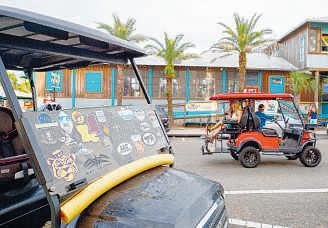
square feet of meeting rooms and event space that will target anew group of business andmeeting travelers.
In May,Allegiant Air begandirect flights between fourMidwesterncities and Gulf ShoresInternational Airport at Jack Edwards Field,which, until then, was mostly used by crop dusters and private prop planes.
To thewest, Gulfport-Biloxi and Mobile have seen increases in service to their nearby airports, as have Pensacola and Destin to the east.
“WhenAllegiantcame to Destin in 2018, they had four routes. Now, they have 40 routes outofDestin,”said Davis at Beachball. “That is what we are hoping to do here in Gulf Shores. It opens awhole new market for us.”

long as the CatholicChurch is here, her story will be preserved, and the story of the
faithofthe Acadian people.”
Now, the Vatican formally begins itsinvestigation into
Growingpains
With growth has comechallenges —higher prices in some cases,congested roads and strainedinfrastructure.
WhenThomas Genin walks into hisdowntown BaySt. Louis restaurant, The Blind Tiger, he doesn’t recognize most of the customers because most are touristsornew residents.
“Coronavirus put the Mississippi Gulf Coastinto overdrive,” he said.
Whilethe activity is good for business, some longtime locals arestaying away from therestaurants andother establishments on thebusy strip because they don’tfeel like dealingwithcrowdsor can’t findparking. Genin said he has repeatedly raised these concerns to city leaders, asking themtoadd
the life andthe heroicvirtue of Charlene
If the Churchprovesher virtue, amiraclethrough her intercession will also needto be proventomove forward “A miracle is astandard used by thechurch to say that something that hasno explanation was done by the power of God,” LaVergne said.
During that next step, anthropologists, doctorsand other specialists are asked to give areasonable explanation for the unexplainable happenings thatthe faithful have attributedtoCharlene’s intercession
Thousands of people visit Charlene’s grave each year.
“Wehave so many stories



loading zonesalong Beach Boulevard andmore parking spaces. So far, though, nothing has happened.
At Tatonut Donut Shopin Ocean Springs,alongtime local bakery known for its potato-flourdoughnuts managerTheresa Mohler has seen abig shift in her clientele. The difference is especially noticeable on Saturdays,whenthe average customer count is between 550 and 600.
“Our sales are up, and our customers have shifted more to what Ibelieve are tourists,” Mohler said.
She’s notcomplaining though,she admits, “we’ve fallen alittle bit on our local business.”
Newfaces
Amid the growth, local tourism officials aretryingtomakesense of recent changes that could signal long-term shifts in the overall market.
Forinstance,travelers are waiting later to book their trips andshortening their staysfrom aweek to three or four days.
“Back in the day,guests
of people writing in, sharing to us that say,‘Iprayed for this healing, and it happened’,” LaVergne said.
Once amiracle is verified, she will be named“beatified.”
The Holy Spirit would then confirm through another miracle. That miraclehas to occur after she is beatified. Then, she would be recognized churchwide as asaint
In Acadiana,however,she hasbeen calledher the“Little Cajun Saint” fordecades.
would rent Saturday to Saturday,” said Jeny Stokes, general manager of Bender Vacation Rentals in Gulf Shores. “Young families and couples are now looking for weekend getaways, andpotentialguests arelooking for great, last-minute deals.” Snowbirds are also changing theirhabits. BabyBoomers are aging out and aren’t coming everywinter, as they once did, or at least, notfor as long.
“But we’re seeing new, youngersnowbirds in their place,” said Davis. “They can work remotely,so they’re coming andstaying longerthanwewouldhave expected.”
Attractions, like the Sand In My Boots music festival and the NCAA Beach Volleyball Championship, both of which wereheld in May,are bringing national attention to the area andattracting a new group of visitors.
“People are still discovering us andwekeep growing,” said Maghan.“It’s shaping up to be areally strong summer.”
Email Poet Wolfe at poet. wolfe@theadvocate.com.
Charlene died in 1959 aftera short battle with acute lymphaticleukemia.She was described as atypical rural child of herera —the second of 10 children, she was a good student and enthusiastic athlete, loved Elvis Presley’s music and “sock hops”ather home, did farm chores and was steeped in her Catholic faith. It was the two weeks before her death that proved extraordinary to many witnesses to her life and last days: Like St. Thérèse of Lisieux, the 19th century French nun about whom she had read, she dedicated her illness and suffering in prayerfor the salvation of thesouls of others. Her heroism in her last days were noted by the priest andchaplain who attended her spiritually and by the nun and nurse who oversaw hercare. For generations, family,friends and followers believedthather death held great meaning.




























































































STAFF FILE PHOTO By LESLIE WESTBROOK
An imageofCharlene Richard is seen on her graveJan. 18, 2022, at the St. Edward Catholic Church Cemeteryinthe community ofRichard.
Peoplesit on abench in downtown Ocean Springs, Miss., Wednesday.
People fish as aBiloxi schooner passes in Biloxi, Miss., on Thursday.
Cartsare apopular mode of transportation in downtown BaySt. Louis, Miss.,onWednesday.
STAFF PHOTOSByDAVID GRUNFELD
People spend time on the BaySt. Louis, Miss.,beach feeding birds on Saturday
Brad Orrison, awell-known figure in the worldofbarbecue, particularlyasthe founder of The Shed BBQ &Blues Joint, holds arackofribsathis joint in Ocean Springs, Miss.,on Wednesday.

People
FLOODING
Continued from page 1A
Texas Gov Greg Abbott vowed that authorities will be relentless in rescuing and recovering victims.
“We will find every one of them,” he said.
The number of victims climbed as more rain continued around Austin and a massive search continued in the nearby Hill Country At least three people died and 10 others were missing in Travis County home to the state’s capital.
Two people died in Burnet County, where a firefighter was among the missing after he was swept away by floodwater while responding to a rescue, the county Emergency Management Coordinator Derek Marchio said. Kerr County Sheriff Larry Leitha said the bodies of 32 people had been recovered so far in the devastated Hill Country: 18 adults and 14 children. Authorities were coming under growing scrutiny over whether the camps and residents in places long vulnerable to flooding received proper warning and whether enough preparations were made.
The hills along the Guadalupe River in central Texas are dotted with century-old youth camps and campgrounds where generations of families have come to swim and enjoy the outdoors. The area is especially popular around the July Fourth holiday, making it more difficult to know how many are missing.
“We don’t even want to begin to estimate at this time,” City Manager Dalton Rice said Saturday morning.
Storm hit camp at night
“The camp was completely destroyed,” said Elinor Lester, 13, one of hundreds of campers. “A helicopter landed and started taking people away It was really scary.”
A raging storm fueled by incredible amounts of moisture woke up her cabin just after midnight Friday, and when rescuers arrived, they tied a rope for the girls to hold as they walked across a
bridge with water whipping around their legs, she said.
Frantic parents and families posted photos of missing loved ones and pleas for information.
On Saturday, the camp was mostly deserted. Helicopters roared above as a few people looked at the damage, including a pickup truck tossed onto its side and a building missing its entire front wall.
Among those confirmed dead were an 8-year-old girl from Mountain Brook, Alabama, who was staying at Camp Mystic, and the director of another camp just up the road.
The flooding in the middle of the night caught many residents, campers and officials by surprise in the Hill Country, which sits northwest of San Antonio.
AccuWeather said the private forecasting company and the National Weather Service sent warnings about potential flash flooding hours before the devastation.
“These warnings should have provided officials with ample time to evacuate camps such as Camp Mystic and get people to safety,” AccuWeather said in a statement that called the Hill Country one of the most flash-flood-prone areas of the U.S. because of its terrain and many water crossings.
The National Weather Service sent out a series of flash flood warnings in the early hours Friday before issuing flash flood emergencies — a rare alert notifying of imminent danger
Officials defended their actions while saying they had not expected such an intense downpour that was the equivalent of months’ worth of rain for the area.
One National Weather Service forecast earlier in the week “did not predict the amount of rain that we saw,” said Nim Kidd, chief of the Texas Division of Emergency Management. Helicopters, drones used Search crews were facing harsh conditions while “looking in every possible location,” Rice said Authorities said about 850 people had been rescued U.S. Coast Guard helicop-
ters were flying in to assist.
One reunification center at an elementary school was mostly quiet Saturday after taking in hundreds of evacuees the day before.
“We still have people coming here looking for their loved ones. We’ve had a little success, but not much,” said Bobby Templeton, superintendent of Ingram Independent School District.
Homeland Security Secretary Kristi Noem arrived and pledged that the Trump administration would use all available resources.
Residents clung to trees
In Ingram, Erin Burgess woke to thunder and rain in the middle of the night Friday Just 20 minutes later, water was pouring into her home, she said. She described an agonizing hour clinging to a tree with her teenage son.
“My son and I floated to a tree where we hung onto it, and my boyfriend and my dog floated away He was lost for a while, but we found them,” she said.
Barry Adelman said water pushed everyone in his three-story house into the attic, including his 94-yearold grandmother and 9-year-old grandson.
“I was having to look at my grandson in the face and tell him everything was going to be OK, but inside I was scared to death,” he said.
Local resident know it as “flash flood alley ”
“When it rains, water doesn’t soak into the soil,” said Austin Dickson, CEO of the Community Foundation of the Texas Hill Country, which was collecting donations. “It rushes down the hill.”
No warning system
The forecast for the weekend had called for rain, with a flood watch upgraded to a warning overnight Friday for at least 30,000 people.
Texas Lt. Gov Dan Patrick said the potential for heavy rain and flooding covered a large area.
“Everything was done to give them a heads up that you could have heavy rain, and we’re not exactly sure where it’s going to land,” Patrick said. “Obviously as it got dark last night, we got
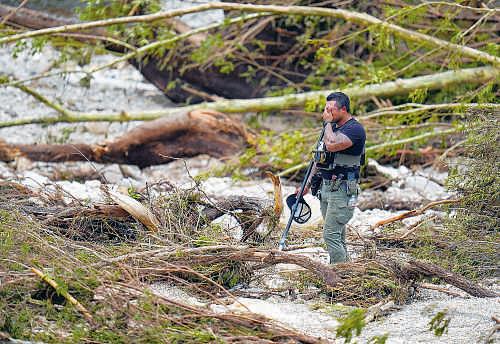





A sheriff’s deputy pauses Saturday while combing through the banks of the Guadalupe River near Camp Mystic after a flash flood swept through Hunt, Texas.
ASSOCIATED PRESS PHOTOS By JULIO CORTEZ
look at debris on the banks of the Guadalupe River after a flash flood swept through the area in Hunt, Texas, on Saturday.
into the wee morning of the hours, that’s when the storm started to zero in.” Kerr County Judge Rob
Kelly the county’s chief elected official, said: “We do not have a warning system.” When pushed on why
more precautions weren’t taken, Kelly said no one knew this kind of flood was coming.






































EDUCATION
POLITICS IN SCHOOLS
Rural schools feel the pinch from Trump cuts
BY ANNIE MA
AP education writer
WASHINGTON In parts of rural upstate New York, schools have more than 1,100 students for every mental health provider In a far-flung region with little public transportation, those few school counselors often are the only mental health professionals available to students.
Hennessey Lustica has been overseeing grant-funded efforts to train and hire more school psychologists, counselors and social workers in the Finger Lakes region, but those efforts may soon come to end — a casualty of the Trump administration’s decision to cancel school mental health grants around the country
“Cutting this funding is just going to devastate kids,” said Lustica, project director of the Wellness Workforce Collaborative in the Seneca Falls Central School District.
“The workforce that we’re developing, just in my 21 school districts it’s over 20,000 kids that are going to be impacted by this and not have the mental health support that they need.”
The $1 billion in grants for school-based mental health programs were part of a sweeping gun violence bill signed by President Joe Biden in 2022 in response to the school shooting in Uvalde, Texas. The grants were meant to help schools hire more psychologists, counselors and other mental health workers, especially in rural areas. Under the Biden administration, the department prioritized applicants who showed how they would
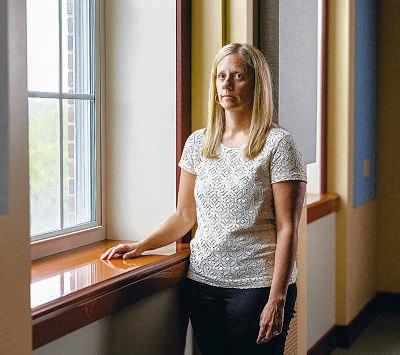
increase the number of providers from diverse backgrounds, or from communities directly served by the school district But President Donald Trump’s administration took issue with aspects of the grant programs that touched on race, saying they were harmful to students.
“We owe it to American families to ensure that taxpayer dollars are supporting evidence-based practices that are truly focused on improving students’ mental health,” Education Department spokesperson Madi Biedermann said. Lustica learned of her grant’s cancellation in April in a two-page letter from the Education Depart-
ment, which said the government found that her work violated civil rights law It did not specify how Lustica is planning to appeal the decision. She rejected the letter’s characterization of her work, saying she and her colleagues abide by a code of ethics that honors each person’s individuality, regardless of race, gender or identity
“The rhetoric is just false,” Lustica said. “I don’t know how else to say it. I think if you looked at these programs and looked at the impact that these programs have in our rural school districts, and the stories that kids will tell you about the mental health professionals that are in their schools, it has helped
them because of this program.”
The grants supported programs in districts across the country In California, West Contra Costa Unified School District will lose nearly $4 million in funding. In Alabama, Birmingham City Schools was notified it would not receive the rest of a $15 million grant it was using to train, hire and retain mental health staff.
In Wisconsin, the state’s Department of Public Instruction will lose $8 million allocated for the next four years. The state had used the money to boost retention and expand programs to encourage high schoolers to pursue careers in school-based mental health.
“At a time when communities are urgently asking for help serving mental health needs, this decision is indefensible,” state superintendent Jill Underly said in a statement.
In recent House and Senate hearings, Democrats pressed Education Secretary Linda McMahon on the end of the grants and the impact on students. McMahon told them mental health is a priority and the grants would be rebid and reissued.
“Anyone who works or spends time with kids knows these grants were funding desperately needed access to mental health care services,” American Federation of Teachers president Randi Weingarten said in a statement. “Canceling the funding now is a cruel, reckless act that puts millions of children at risk.”
The strains on youth mental health are acute in many rural school districts.
In one upstate New York district, half the students have had to move due to economic hardship in the last five years, creating instability that can affect their mental
WE’RE ASKING EXPERTS ACROSS THE STATE HOW TO TACKLE THE BIGGEST CHALLENGES FACING LOUISIANA SCHOOLS.

health, Lustica said. In a survey of students from sixth through 12th grade in one county, nearly half reported feeling sad or depressed most of the time; one in three said their lives lacked clear purpose or meaning.
“We’ve got huge amounts of depression, huge amounts of anxiety lots of trauma and not enough providers,” Lustica said. “School is the place where kids are getting a lot of the services they need.”
Some families in the region are unable to afford private counseling or are unable to get their children to appointments given transportation challenges, said Danielle Legg, a graduate student who did an internship as a school social worker with funding from the grant program.
“Their access to mental health care truly is limited to when they’re in school and there’s a provider there that can see them, and it’s vital,” Legg said.
In the past three years, 176 students completed their mental health training through the program Lustica oversees, and 85% of them were hired into shortage areas, she said.
The program that offered training to graduate students at schools helped address staffing needs and inspired many to pursue careers in educational settings, said Susan McGowan, a school social worker who supervised graduate students in Geneva City School District.
“It just feels, to me, really catastrophic,” McGowan said of the grant cancellation. “These positions are difficult to fill, so when you get grad students who are willing to work hand in hand with other professionals in their building, you’re actually building your capacity as far as staffing goes and you’re supporting teachers.”










ASSOCIATED PRESS PHOTO By LAUREN PETRACCA
Descendants of last known slave ship hold ceremony
BY JAYLEN GREEN and DAN ANDERSON Associated Press
MOBILE,Ala.—
The remaining descendants of the last ship carrying enslaved Africans to land in the U.S. in 1860 met Saturday in Mobile, Alabama, for a memorial ceremony Attendees, many of them dressed in white, gathered near Africatown Bridge on the banks of the river, where the ship remains submerged because it is too decayed to be extracted.
Descendants say they are intent on ensuring the public never forgets what human beings endured during their two-month voyage across the Atlantic Ocean.
“The Clotilda history and the community that they built in Africatown is very much something that we honor, talk about, discuss, celebrate,” said Chanelle Blackwell, a ceremony organizer
The ship, known as the Clotilda, was discovered in 2019 in the murky waters of the Alabama Gulf Coast. But, more than 40 years ago, descendants of the 110 Africans who were ferried to American shores collectively
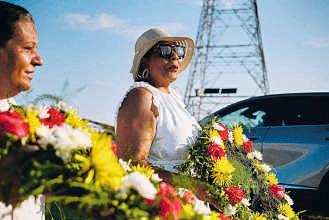

founded a historical society to preserve the culture and heritage of the last Africans brought to America, and to ensure that future generations are aware of their ancestors and African history Walter Jermaine Bell traveled to Mobile from Atlanta and laid down a ceremonial wreath at the event. He said he was honored and humbled to participate.
“Such a gratifying feeling, a redeeming feeling, to be able to do something to
bridge the gap, not just for this group, but also for my kids who are present,” he said. “I really wanted them to see and participate in this.”
Historical records show that Africatown, formally known as Plateau, was bought by 32 of the freed survivors of the Clotilda after the Civil War, about 3 miles north of Mobile.
The Clotilda had been under a $1 million state-funded investigation to excavate
and preserve the ship, to be brought on land, with the goal of turning it into a museum that could generate a much-needed amount of revenue for the Africatown community
A task force of archaeologists, engineers and historians, headed by the Alabama
Historical Commission, recommended in a report that pillars be installed around the ship underwater to protect it from passing ships — an event they suspect caused the ship to break in half before it sank.
BY ALANNA DURKIN RICHER Associated Press
WASHINGTON The Justice Department is ramping up its plans to revoke the citizenship of immigrants who’ve committed crimes or pose a national security risk, according to a recent memo underscoring the Trump administration’s hardline immigration agenda.
Efforts to identity and go after those suspected of cheating to get their citizenship are not new to this administration.
But the public push is raising concerns from advocates, who have accused the administration of trying to use immigration enforcement for political purposes. It’s receiving increased scrutiny after a Republican member of Congress suggested that Zohran Mamdani, the New York City Democratic mayoral candidate should be subject to denaturalization proceedings.
Here’s a look at the denaturalization process and what the Justice Department’s memo means:
Denaturalization cases rare
The U.S. government can strip a naturalized immigrant of their citizenship if they are criminally convicted of naturalization fraud or if the government proves through civil proceedings that they illegally obtained their citizenship through fraud or misrepresented or concealed facts on their application.
For years, the government’s denaturalization efforts focused largely on suspected war criminals who lied on their immigration paperwork, most notably former Nazis The Justice
Department filed just more than 300 total cases between 1990 and 2017.
An initiative that began under the Obama administration called Operation Janus expanded those efforts by seeking to identify people who had used different identities to get green cards and citizenship after they were previously issued deportation orders.
In 2016, an internal watchdog reported that 315,000 old fingerprint records for immigrants who had been deported or had criminal convictions had not been uploaded to a Department of Homeland Security database that is used to check immigrants’ identities The same report found more than 800 immigrants had been ordered deported under one identity but became U S citizens under another The first Trump administration made such investigations a bigger priority, creating a Justice Department section focused on denaturalization cases.
But even then, the number of denaturalization cases remained small, as the administration didn’t have the resources to bring many amid an onslaught of legal challenges to immigration policies it had to defend against, said Matthew Hoppock, an attorney in Kansas who represents people in denaturalization cases.
Prioritizing certain cases
The push was announced in a memo from the recently confirmed head of the Justice Department’s Civil Division, Assistant Attorney General Brett Shumate. Shumate said the cases the department will prioritize include people
who “pose a potential danger to national security,” people who commit violent crimes, members of gangs and drug cartels and people who commit Medicaid fraud and other types of fraud.
Hoppock said the memo sort of “blows the doors open” for the administration to file as many as many denaturalization cases as it has the resources to file.
Lawyers raise alarm
The broad language in the memo raises the prospect “that any offense, at any time, may be used to justify denaturalization,” said Christopher Wellborn, president of the National Association of Criminal Defense Lawyers.
“It is not difficult to imagine a scenario where the government invokes unsubstantiated claims of gang affiliation or uses an individual’s criminal record to claim that citizenship was illegally procured,” Wellborn said in a statement.
Others worry the administration’s public push will stoke fear among naturalized immigrants.
“The more you talk about it, the more you frame it as ‘we’re coming after your naturalization, we’re coming after you,’ the more of a chilling effect we see on people applying for naturalization,” said Elizabeth Taufa, senior policy attorney and strategist at the Immigrant Legal Resource Center
Critics have accused the Trump administration using immigration enforcement to go after people because of their speech — most notably in the case of Columbia University activist Mahmoud Khalil, whom it has sought to deport over his role in pro-
Palestinian protests.
“One of our ongoing concerns is will they target these politically will they start combing through people’s immigration files if they don’t like you or if they think you don’t agree with the government,” Hoppock said.
“I think most Americans would support the idea of stripping someone of citizenship if they got it through fraud and they are also a dangerous person,” he said, but the concern is if they start going through “regular folks’ immigration files to find a T that is not crossed
Cherrelle Jefferson Smith attended the annual event for the first time. A resident of Africatown who moved to Mobile in 2014, she said “it seems like I was meant to be here.”
or an I that is not dotted so they can use it as a weapon.”
La. denaturalization case
The department last month announced that it had successfully secured the denaturalization of a man who was convicted of possessing child sexual abuse material.
The British man had become a U.S. citizen after enlisting in the U.S. Army under a provision that provides a pathway to citizenship for U.S. service members, officials said. He only listed a speeding ticket when asked on his naturalization appli-
“It was very sacred and personal, no matter if you’re a descendant or not,” she said, adding that she was brought to tears by the event.
cation if he had “ever committed a crime or offense for which you were not arrested,” and he became a U.S. citizen in 2013. Months later, he was arrested in Louisiana on child sexual abuse material charges and convicted, according to the department.
“The laws intended to facilitate citizenship for brave men and women who join our nation’s armed forces will not shield individuals who have fraudulently obtained U.S citizenship by concealing their crimes,” Shumate said in a statement.



Ester Deaguiar, left, head of the Mobile International Festival, carries wreaths she made for the landing ceremony of descendants of the last ship carrying enslaved Africans to land in the U.S in 1860, known as the Clotilda, with Alabama state Rep. Barbara Drummond on Saturday in Mobile, Ala.
ASSOCIATED PRESS PHOTOS By DAN ANDERSON
Walter Jermaine Bell, of Atlanta, left, a descendant of African slaves transported aboard the Clotilda, leads a memorial procession with a wreath to the banks of the Mobile River in Mobile, Ala., Saturday.
LA.POLITICS
Studentart selected to hang in hallsofCongress
BY MARK BALLARD Staff writer
WASHINGTON –Topromote art in schools, every year, eachofthe 435 members of the House chooses from submissions from their constituents to decorate the busy tunnel that connects representatives’ offices with the U.S. Capitol.
Thesix membersofLouisiana’sHouse delegation recently selectedtheir pieces for the honor Momin Mahmood, asophomore at Destrehan High School, was the winner for Louisiana’s1st Congressional District.
“This piece highlights the jewel of the historicFrench Quarter,our iconicSt. Louis Cathedral, with incredible detail and will showcaseour state’srich heritage for the many Capitol visitors from Louisiana and across the nation for the next year,” said Majority Leader,U.S. Rep. Steve Scalise, R-Jefferson Rep. Troy Carter said he chose apiece by Lindsay Kane, of the Academy of the Sacred Heart, Rosary Campus in New Orleans, because her “No Human is Illegal” is timely,“reminding us that we are all equal and must fight to protect the rule of law.” Cole Ritter,ofSouthside High School in Youngsville, won in the 3rd Congressional District for his colored pencil drawing titled “La Dame Blanche Du Bayou.” Grace Rougeau, of Leesville,tookfirst placein House Speaker Mike Johnson’s4th Congressional District forher painting called “Craw-Fever.”
“Viking,” apencil-drawn

The winners ofthe congressional artcontest are, beginning at top left, clockwise,‘No Human is Illegal’ by LindsayKane; ‘Echoes of theCrescent City’ by Momin Mahmood; ‘Craw Fever’ by Grace Rougeau; ‘Viking’ by Gabrielle Sibley; ‘La Dame BlancheduBayou’ by Cole Ritter;and ‘Crown’by KearraGrisby
sketch by Gabrielle Sibley, of French SettlementHigh School,was chosen by Rep Julia Letlow, R-Start,for Louisiana’s 5thDistrictbecauseher gaze shows “the same resilience we see in Louisiana’sresidentsafter everystorm andnatural disaster.”
Kearra Grisby,ofSt. Joseph’s Academy in Baton Rouge, won in Rep. Cleo


Fields’ 6th District for her photography piece entitled “Crown.
“Weneed to be creating more avenues and opportunitiesfor ouryoung people to express themselvesand display their talents,” Fields said.
Email Mark Ballard at mballard@theadvocate. com.





BY LINLEY SANDERSand AMELIA THOMSON-DEVEAUX Associated Press
WASHINGTON Only 36% of Democrats say they’re “extremely” or “very” proud to be American, according to anew Gallup poll, reflecting adramatic decline in national pride that’salso clear among young people.
Thefindings are astark illustration of how many —but notall —Americans have felt less of asenseof pride in their country over thepast decade. The split between Democrats and Republicans, at 56 percentage points, is at itswidest since 2001. That includes all fouryears of Republican President Donald Trump’s first term.
Only about4in10U.S. adults who are part of Generation Z, which is defined as those born from 1997 to 2012,expresseda high level of pride in being American in Gallupsurveys conducted in the past five years, on average. That’scompared with about6in10Millennials —those born between 1980 and 1996 —and at least 7in10U.S. adults in older generations.
“Each generation is less patriotic than the prior generation, and Gen Zis definitelymuch lowerthan anybody else,” said Jeffrey Jones,a senior editor at Gallup. “Buteven among theolder generations, we see that they’re less patriotic than the ones before them, and they’ve become less patriotic over time That’sprimarily driven by Democratswithinthose generations.
America’sdeclinein national pride has been a
slowerosion, witha steady downtick in Gallup’sdata sinceJanuary 2001, when the question wasfirst asked.
Even during the tumultuous earlyyears of theIraq War, the vast majority of U.S. adults, whether Republican or Democrat, said theywere“extremely” or “very” proud to be American. At that point, about 9 in 10 were“extremely” or “very” proud to be American. That remained high in the aftermath of the Sept. 11, 2001, attacks, but the consensus around American pride slipped in the years that followed, dropping to about 8in10in 2006 and continuing agradual decline.
Now, 58% of U.S. adults say that, in adownward shift that’s been driven almostentirelybyDemocrats andindependents. The vast majority of Republicans continue to saythey’re proud to be American.
Independents’ pridein their national identityhit a new low in the mostrecent survey, at 53%,largely following that pattern of gradual decline.
Democrats’ diminished pride in being American is more clearly linked to Trump’stime in office.
When Trumpfirst entered theWhiteHouse,in2017, abouttwo-thirds of Democrats saidtheywere proud to be American.Thathad fallen to 42%by2020, just
before Trump lost reelection to Democrat Joe Biden. But whileDemocrats’ sense of national pride rebounded when Biden took office, it didn’tgoback to its pre-Trumplevels.
“It’s notjust aTrump story,” Jones said. “Something else is going on, and I think it’sjust younger generations coming in and not being as patrioticasolder people.”
Other recent polling showsthat Democrats and independents are less likely thanRepublicans to say that expressing patriotism is important or to feela sense of pride in their national leaders.
Nearly 9in10Republicansina 2024 SSRS poll said they believed patriotism hasapositiveimpact on the United States, with Democrats moredivided: 45% said patriotism had apositive impact on the country,while 37% saidit wasnegative. But amore general sense of discontentwas clearon both sidesofthe aisle earlier this year,when aCNN/ SSRS poll found that fewer than 1in10Democrats and Republicanssaid“proud described the way they felt about politics in America. In that survey,most Americans across the political spectrum said they were “disappointed” or “frustrated” with the country’spolitics.







STAFF PHOTO By MARK BALLARD
THE GULF COAST
SeeBiloxifromland, andbyAerobar
BY CHELSEA SHANNON Staff writer
Inever thought atrip to Margaritaville in Biloxi would be what changed my mind about Mississippi and the Gulf Coast. But here we are.
Growing up, Ivisited Mississippia few times because my grandmother livedin Meridian, about athree-hour drivefrom the Gulf Coast. On those trips, we usually stayed put and didn’toften drive south. Ithought Mississippi was alovely place, but it wasn’t muchto it, although there was Dillard’s, whichwe didn’thave in California. But Idigress. Now that I’m an adult livinginNew Orleans, my boss told me about aflying bar that goes up high into the air,and he was wondering if Iwanted to check it out. There was very littleconvincingthat needed to happen despite my preconceptions of what aday trip in Mississippi would be like.
In 2023, the Biloxi Margaritaville added Paradise Pier Fun Park, an amusement park featuring multiple carnival-style rides, to its list of amenities. The park is open daily,starting at 11 a.m., and closes an hour later on Fridays and Saturdays at 10 p.m. Arriving on aTuesday, there was very little traffic, making it the perfect daytrip
We stopped at Shaggy’s, because several people had recommended it,and my friendand Iwanted to eat on apatiooverlooking the beach to soak in the Mississippi Coast vibes.
It ended up being aheavier meal thanI’d like before hitting an amusement park,but Iclearly wasn’tthinking aboutthat and just living in the moment. We split some queso and salsa, and thenI had theslowroasted pulled pork sandwich When we saw some of thecocktails, I said, “This would be great on thebeach Toobad we’re not in New Orleans.” Luckily,though, our waitress informed us that in Biloxi, to-go cups are allowedin certain ”leisure” districts.
So, best believe,Itook my cocktail to go and hang out on the beach before we headed off to Margaritaville. Immediately,wegot our $40 day pass,

which allowed us to ride all the rides as oftenaswewanted. Previously,anadditional $20 was required to ride theAerobar,but that rideisnow included in the day pass. We decided to get thelay of the land before checkingout our primary mission, andIimmediately wanted to go on the ride that flips you upside down while riding aroundthe roller coaster.There were momentswhen Istopped screaming and was able to hear Jimmy Buffett crooning in the background. Iwas in paradise, minus the cheeseburger Fora second, it felt like Sunday at Jazz Fest in 2022 when Igot to see thelate Buffett perform at what was to be his last Jazz Fest set. I’m not abig Parrot Head, the nicknamefor fansofBuffett. Still, I appreciate the vibes themusician brings into this world, and Ifelt so at peace being aroundthem at Jazz Fest.
Ihad asimilar feeling at theMargaritaville amusement park, and it wasn’tlong before Iwas spinning and singing, “wastin’ away in Margaritaville.”
We wentontoexplore theother rides, giving asmanyaspossible atry before it felt like Iwas going to hurl up lunch, usheringinaperfect time to get an ice-cold daiquiri and check outthis flying bar
There are only 13 of these Aerobar attractions in the world, according to the company that makes them. There are someincountries such as France, Dubai, Mexico and China. Biloxiand Las Vegas are the only ones in the U.S.
The bar is acircular contraption, with seatsand seat belts, and rises just over 100 feet into the air.You get to sit up there for about 15-20 minutes, chat with your friends, meet some of your fellow travel companions and enjoy adrink with aview Biloxinever looked so good.
As Ilooked out at the other spots around Margaritaville, Inoted other places I wanted to check out, including museums and restaurants.
Unexpectedly,the world feltfull of possibilities up there. Ihad one of those moments whereeverything felt right in the world, and it was alittle break from the chaos. When thecontraption lowered us down to theground, and mytravel companion and Idecided to call it aday.But as the sun passed thehorizon, Istill wished we could have stayed in Biloxialittle bit longer Email Chelsea Shannon at cshannon@ theadvocate.com.
Take the scenic route to avoid I-10 traffic
BY JUSTIN MITCHELL Staff writer
Summer is here, and formany in Louisiana that means sunshine, beach trips and boat rides along the Gulf Coast.
And there’sanew stop on the way to the beach: Buc-ee’s. The massive travel center opened to major fanfare earlier this monthjust offInterstate 10 in Pass Christian, Mississippi. It’sone of the largest Buc-ee’stravel centers in the U.S. and has morethan 100 fuel pumps, pounds of brisket and dozens of bags of crunchy beaver nuggets forguests to enjoy The Pass Christianlocation is closer to Louisiana than the Buc-ee’sinFoley,Alabama, near Gulf Shores and Orange Beach, andissure to be on the itinerary list for manytraveling along the Gulf Coast this summer
But drivers beware: I-10 traffic from Diamondhead to Long Beach can at times be snarled as road work persists in the area. That meansyou could get stuck waiting while trying to gettothe Menge Avenue exit to get your beaver fix.
There’sanother route to Buc-ee’s off the beaten path that will let you enjoy the beach and won’t add much time to your commute, especially if traffic is badon the interstate.
Coming from Louisiana on Interstate 10, take this route:
n Take the Waveland/John C. Stennis Space Center,exit 2, just over the Mississippi state line.
n Stay along U.S. 90 and drive through Waveland and Bay St. Louis.
n Whenyou gettothe bridgethatconnects Bay St. Louis and Pass Christian, keep going. Stay on the highway and your view will change to the beach.
n Once you get to Menge Avenue, turn left and go north until you see the Interstate10overpass.Drive over it andtake the circle, and you’vearrivedatBuc-ee’s heaven.







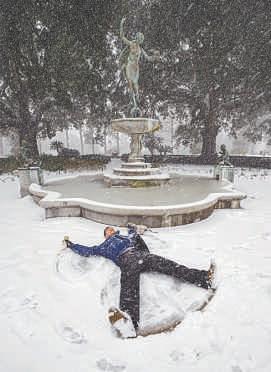



PROVIDED PHOTO By HANNAH RUHOFF
Park guestsare lifted about 100feet into the air when riding the Aerobar at Paradise Pier amusement park, located at Margaritaville in Biloxi.
























Lafayette coffee shop listed for sale
Coffeeweed Cottage still welcoming guests
BY JOANNA BROWN Staff writer
For over two years, Coffeeweed Cottage has gathered a unique community of people at a former auto-repair shop in Lafayette’s La Place, or “Fightinville,” neighborhood, just north of downtown.
Owner Denise Champagne-McClure filled the space with plants, textiles, decor and a great little coffee and lunch counter, while making the most of the light streaming through the shop’s
Funeral services set for Lafayette Realtor
BY KRISTIN ASKELSON Staff writer

massive windows. The effect is both welcoming and inspiring which probably has something to do with Coffeeweed Cottage’s special clientele.
During busy periods, the shop’s tables are filled with people reading, working, meeting and socializing with each other. Yes, this is typical of coffee shops, but here there is an atmosphere of positive activity that creates a remarkably delightful third place, defined as a social environment outside of one’s home or work.
Champagne-McClure said, “It’s been very intentional, and its purpose was exactly what it became — which is more than I could have imagined.”
Coffeeweed Cottage, named for the chicory plant, has hosted holiday events, La Place coterie meetings, Silent Book Clubs and other events that have established the business as a vibrant part of one of Lafayette’s oldest neighborhoods. But in May, just days after its two-year anniversary Champagne-McClure an-
nounced that the property and business is for sale.
The listing is on the market for $540,000, which includes the building, outdoor area and 22 parking spaces on 0.36 acres.
While she doesn’t have a buyer yet, Champagne-McClure said the business is no longer sustainable for her to operate as a single mother with no backers — just her dream, with a boost from her life savings.
“Hopefully we’re just selling and not closing,” she said, while talking about the vision she had to create an environment where “no one looks the same and no one
has the same views.”
Champagne-McClure said she worked a second job to support herself and her daughter while opening Coffeeweed Cottage, and the business likely would not have been able to pay her until three to five years in, which she said is typical for small businesses. Life and job changes led her to change her plan, but she is not necessarily closing the door on Coffeeweed Cottage for good. She said she is open to staying onboard if a buyer wants her to
Funeral services for Nancy Van Eaton Broussard Prince will be at 10 a.m. Monday at the Cathedral of St. John the Evangelist in Lafayette. Entombment will be in the St. John Cemetery mausoleum. The Rev Monsignor W. Curtis Mallet will be the celebrant of the funeral Mass and officiate the services, concelebrated by the Rev. Cedric Sonnier, pastor of St. Mary, Mother of the Church, and by the Rev Chester C. Arceneaux, rector of the Cathedral of St. John the Evangelist.
The funeral will be livestreamed online and can be accessed through the website of the Cathedral of St John the Evangelist.
Prince died at home June 26 at the age of 86. She is survived by her
ä See PRINCE, page 2B
Fatal cyclist crashes hit record high
Between 2019 and 2023, 170 died in La.
BY MARGARET DELANEY Staff writer
In 2022, the number of cyclist deaths nationwide reached a record high of 1,105, according to the National Highway Traffic Safety Administration. Between 2019 and 2023, 170 cyclists died from fatal motor vehicle crashes
ä See CYCLIST, page 2B

‘A complete lifestyle change’
Lafayette woman offers treats from her driveway at Pink Porch Bakery
BY JA’KORI MADISON Staff writer
Despite battling cancer and living with seizures that made it difficult to carry out daily tasks, Monica Henry says she has always found light and positivity through her family her friends and her love of baking.
Her love for sweets inspired her to reinvent recipes to make them healthier, which eventually blossomed into a homegrown bakery right in her driveway.
“I wasn’t sure what caused my seizures, so I wanted to do a complete lifestyle change,” she said.
So she started baking to find healthy alternatives to store-bought treats she loved but could no longer enjoy because of the processed ingredients.
This led Henry to reinvent recipes such as protein bars
and cookies. Sharing these creations on social media, along with her weight-loss journey, caused Henry’s social media presence to grow That eventually led to a cottage bakery right in her driveway at 853 Ridge Road in Lafayette. The Pink Porch Bakery takes its name and vibrant pink color from Henry’s journey as a breast cancer survivor It offers a variety of handcrafted treats. Henry bakes five different sweets each week Her best-selling gourmet stuffed cookies include the stuffed strawberry Swiss roll and jumbo Biscoff cookies, alongside pistachio cinnamon loaf cakes and stuffed cups In addition to her sweet treats, Henry offers herb and Asiago cheese focaccia bread as well as keto-friendly
ä See CHANGE, page 2B


STAFF PHOTO By JA’KORI MADISON
The Pink Porch Bakery in Lafayette is a cottage stand where owner Monica Henry sells options like brownies, cakes, cookies and savory bread
PHOTO PROVIDED By MONICA HENRy
The Pink Porch Bakery in Lafayette is a cottage stand where owner Monica Henry sells options like brownies, cakes, cookies and savory bread.
ä See COFFEE, page 2B
CYCLIST
Continued from page1B
in Louisiana, according to data from the U.S. Department of Transportation
These Louisiana parishes had the highest numberof fatal motor crashes involving acyclist:
n OrleansParish with 28 deaths,
n East Baton Rouge Parish with 26 deaths,
n LafayetteParishwith 16 deaths, n Ascension Parish with 11 deaths, n Jefferson and Ouachita parishes with eightdeaths each,
n Rapides Parish with seven deaths, n CalcasieuParishwith six deaths, n and Lafourche, St. Landryand Iberia parishes with five deaths each.
Bossier,Natchitoches, St. John the Baptist, Evangeline,St. Charles, Allen, Plaquemines and Jackson parishes had one cyclist death due to amotor vehicle crash.
Just under 50% of Louisiana parishes had zero fatal motor vehicle crashesinvolving acyclist between 2019 and2023including Assumption, Avoyelles,
COFFEE
Continued from page1B
remain involved —but she is leaving the details “up to God.”
“God placed avision for me to build this on purpose,” according to Champagne-McClure. “Just seeing people for who they are, and loving them exactly how they come through the door.”
“I always hear people say, ‘Man, this doesn’tlook like it belongsinLafayette,’ ” she said. “My goal was to encourage change,and thinking outside the box.” Change has started to ar-
Fatalcyclist crashes
Thenumberoffatal motorvehicle crashesinvolvingacyclist in each Louisianaparish.

Continued from page1B


















working. In January,she made the decisiontoleave her job and focus on her health.

































Source:UnitedStatesDepartmentofTransportation
Beauregard, Bienville, Caldwell,Cameron,Catahoula,Claiborne,DeSoto, East Carroll, East Feliciana,Franklin, Grant, LaSalle, Lincoln, Madison,
rive to thesurroundings buildings and neighborhood. She said abusinessman recentlyboughtthe building next to hers, and otherdevelopments in the area —like anew park at Monroe and Olivier streets, and new residences under construction on WashingtonStreet continue to build energy in La Place anddowntown Lafayette.


























“I have always loved baking but never took it serious, so Ithought now was thetime.I callitmysixth love language. My sister tells me that my hands areanointed between baking andcooking,”Henry said. Now ayear seizure-free anda survivorofbreast cancer and two battles with braincancer,Henry says she has found renewed purpose through the Pink Porch Bakerybyspreadingjoy one handcrafted treat at a time.













Morehouse, Pointe Coupee, Red River,Richland, Sabine, St. Helena, St. James, St. Martin,Tensas, Union, Vernon,West Baton Rouge,West Carroll, West
Feliciana and Webster parishes.
Email Margaret DeLaney at margaret.delaney@ theadvocate.com.

The Pink PorchBakery is open every Saturday, unless stated otherwiseon Facebook.
“I only do Saturday for nowbecause it’sjust me, but Iwill be open more as I get the hang of things,” she said. For more information, visit the Pink Porch Bakery on Facebook.
Email Ja’kori Madison at jakori.madison@ theadvocate.com.
PRINCE
Continued from page1B
husband,James “Jim”
“Someone once told me that Coffeeweed is to Fightinville what Tsunami was to downtown,” said Champagne-McClure, speaking of thesushi restaurantthat spurred anew waveofinvestment in downtown Lafayette 25 yearsago.“Iwas really proud to hear that. When you start investing in aplace,the perception changes.”

At the grand opening of Coffeeweed Cottageat410 Poydras St.onMay 18, 2023, in Lafayette, coffee wasavailable, along withcrafts, books, plants andhome decor
Prince, andher children and their spouses: David VanEaton (Karen) of Fort Worth,Texas;Diane Dorsa of Brentwood, Tennessee;CherylMooney (Rob) of Princeton, New Jersey; CraigVan Eaton (Kerri) of Wellington, Florida; and MarkVan Eaton (Christi) of Lafayette. She also leaves behind 14 grandchildren and seven great-grandchildren, whose lives span seven states. Prince was predeceased by her parents,Erwinand Ursula Iselt; her husband, Arthur Broussard, alocal banking executive; and a grandson, Adam VanEaton.
The family will receive visitors at Martin &Castille Funeral Home on St.Landry Street from 4p.m.to8 p.m. Sunday and8 a.m.to9:45 a.m Monday ARosarywill be prayed at 7:30 p.m. Sunday at the funeral home. In lieu of flowers, the family asks that donations be made to the Carmelite Monastery,1250 CarmelDrive, Lafayette, LA 70501 or St. MaryChurch forPro Life,419 Doucet Road, Lafayette,LA70503 in Prince’smemory. Email Kristin Askelsonat kaskelson@theadvocate. com.
MEGA BALL: 24 Unofficial notification, keep your tickets






















STAFF PHOTO By BRAD KEMP
PHOTO PROVIDED By MONICA HENRy Monica Henry, owner of the Pink Porch Bakery, shows a stuffed Biscoff cookie.
Prince, Nancy VanEaton Broussard
Obituaries Fort Worth, TX;Diane Dorsa of Brentwood, TN; Cheryl Mooney(Rob) of Princeton, NJ; CraigVan Eaton (Kerri) of Wellington, FL; and Mark VanEaton (Christi)ofLafayette, LA Shealsoleavesbehind fourteen grandchildren and seven great-grandchildren, whoselives span across seven states.

Funeral services willbe held on Monday, July7, 2025 at a10:00 AM Mass of Christian BurialinThe Cathedral of St. John the Evangelist in Lafayette for Nancy Van Eaton Broussard Prince, age 86, who passed away on June 26, 2025 surrounded by her loving family at her residence in Lafayette. Entombment will be in the St. John Cemetery Mausoleum. The Very Reverend Monsignor W. Curtis Mallet, JCL,VG, willbethe Celebrant of the Funeral Mass and officiate the services, Concelebrated by the Rev. Cedric Sonnier, Pastor of St. Mary, Mother of the Church, and by the Very Rev. Chester C. Arceneaux, VF, Rector of the Cathedral of St. John the Evangelist. The funeral willbe livestreamed online and can be accessed through the website of the Cathedral of St. John the Evangelist: https://www.y outube.com/live/QePh4CR hi5A?si=C3gM7reDk2R _dR Nancy is survived by her devoted husband, James "Jim" Prince, and her children and their spouses: David Van Eaton (Karen)of
Shewas predeceased by herparents,Erwin and Ursula Iselt, herhusband, Arthur Broussard, alocal banking executive, and one grandson, Adam Van Eaton.
Nancy was born in Houston, TX on November 4, 1938,and becamea trailblazer in Lafayette's real estate industryand a beloved presence in its philanthropic community fordecades.She movedto Lafayette in the 1960s, and her remarkable professional journeybegan whenher father offered to pay for herreal estate license.
Shequickly rose through the ranks, becoming abrokerand launching her own firm.Early on, she hired her best friend, Gail Romero, as one of her first agents. Encouraging Gail to pursue her own broker's license, the two single mothers soonjoined forces to create VanEaton & RomeroRealtors. Their leadership and visiontransformedthe Acadiana real estate market. In the mid-1990s, Nancy and Gailwerenationally recognizedastwo of the most powerful women in real estate by Real Estate Marketing & Relocation Magazine Nancy was among the first women to found herown real estate firm and serve on the localBoard of Realtors, helping pave the way forwomen in what had beena male-dominated industry.
Foundedin1977, Van Eaton &Romero quickly gainedmomentum. With a focus on marketing, public relations, technology,and training,the firm grew into thetop real estate company in theregion. By thelate 1990s, it was consistently ranked among thetop 500 real estate companies in theU.S.byRealTrends Magazine, with over300 agentsand staff across five offices.In2012, the firm merged withLatter & Blum Inc.,and in 2017, it acquiredColdwellBankerPelican.
Philanthropy was central to Nancy and her givingreflected adeepcommitment to education,the arts,the world around us, and thewell-being of children.She supported and volunteered forthe United Way and Scenic America. At theUniversity of Louisiana at Lafayette, she supported numerous initiatives, including the Alumni Association, Friends of theHumanities, Friends of Music, Athletics, theCollege of theArts, and theB.I.Moody IIICollege of Business Sales Training Lab.One of herproudest achievements was thecreationofa professorship chair in real estatethrough theULFoundation.
Nancy's generosity also reacheddozens of community organizations, including the Lafayette Ballet Theater, Acadiana Symphony Orchestra, Children's Museum of Acadiana, Lafayette Science Museum, Acadiana Center forthe Arts,
Performing Arts Societyof Acadiana, Paul &Lulu HilliardUniversity Art Museum,Downtown LafayetteUnlimited, LafayetteEducation Foundation, and the Community Foundationof Acadiana, among many others.
In recognition of hervisionary generosity,Nancy, Gail,and their business partner William"Bill" Bacqué received the Community Foundationof Acadiana's Corporate Philanthropy Award in 2015, and in 2016, Nancy and Gail were honored at theULAlumni Association Spring Gala.
Nancy was deeply rooted in her Catholic faith and was adevoted friend and supporter of Fr. Joseph Brennan, now deceased. Nancy was along-term parishionerofSt. Mary Motherofthe Church of Lafayette. She found great comfort in her faith, and it remaineda guiding force throughout her life Later in life,Nancy and Jim married whileboth
were preparingfor retirement. They foundshared joyintraveland alifeenriched by time spentnear thebeachand lake.Inretirement,Nancycherished nothingmorethan being with herchildren, grandchildren, andgreat-grandchildren. Atradition close to herheart wastaking eachgrandchildona special trip of theirchoice after their high school graduation -a gift of love and adventuretheywillalways treasure.
Nancy'slifewas marked by determination, grace, andgenerosity. Shewas a beloved mother,mentor, rolemodel, leader and friend. Herlegacywill continuetoinspireand uplift thecommunityshe helped shape.
The familywill receive visitors at Martin& Castille Funeral Home on St LandrySt. on Sunday, July 6th from 4:00 PM to 8:00 PM andagain on Monday, July 7th from 8:00 AM to 9:45 AM
ARosarywill be prayed Sunday at 7:30 PM in the
funeral home Thefamilywould like to extendheartfelt thanks to Rosa Cormier andHazel Gobert, andtoall other caregivers whose loving presence broughtNancy peace andcomfort. In lieu of flowers, the familyasks that donations be made to TheCarmelite Monastery, 1250 Carmel Dr Lafayette, LA 70501 or St.Mary Church for Pro Life,419 Doucet Road Lafayette, LA 70503 in Nancy'smemory View theobituaryand guestbook online at www.mourning.com. Martin& Castille Funeral HomeDOWNTOWN,







PUBLIC NOTICE NOTICE TO CONTRACTORS Notice is hereby given that sealed bids will be received either electroni‐callyatwww.centralbidd ing.comorinthe office of thePurchasingDivi‐sion at theLafayette Consolidated Govern‐ment Building,located at 705 West University Av‐enue,Lafayette Louisiana, until 10:00 AM CentralTimeonthe 31st dayJuly, 2025 forthe fol‐lowing: RASIED PAVEMENT MARKINGS andwill, shortlythere‐after, be opened and read aloudinthe Council Briefing Room locatedat 705 West University Av‐enue,Lafayette,LA. Bids received afterthe above specified time foropen‐ingshall notbeconsid‐ered andshall be re‐turned unopened to the sender.Bidders areen‐couraged to call into the bidopeningsatthe fol‐lowing phonenumber 337-291-5100.
ScopeofServices: The scopeofthe projectcon‐sistsoflabor andmater‐ialtoinstall raised pave‐ment markings on 64 dif‐ferent streetswithin Lafayette city andParish. Allworktobecompleted within 120 workingdays from issuance of Notice to Proceed In accordance with LouisianaRS38:2212. vendorsmay submit theirbid electronically at thewebsite listed above. BiddingDocuments are availabletoviewonlyat www.centralbidding. com. Biddersmay re‐questthe electronic bid packagefromHeather Kestlerathkestler@ lafayettela.gov Bidderssubmittingbids electronically arere‐quired to providethe same documentsasbid‐ders submitting through themailassoon as avail‐able.Onlya bidbond, certified checkor cashier’scheck shallbe submittedasthe bidse‐curity.Electroniccopies




perset non-refundable.NOTE: NO CASH WILL BE AC‐CEPTED -ONLYCHECKS OR MONEYORDERS MADE PAYABLETO LAFAYETTE CONSOLI‐DATEDGOVERNMENT. Copies of Section“C” Standard Specifications forRoads,Drainage, Bridgesand OtherInfra‐structure” 2023 Edition areavailable from the Public WorksDepartment at 1515 EUniversityAv‐enue,BuildingA Lafayette LA 70501. Bid Documentsshall be availableuntil twentyfour hoursbeforethe bid openingdate. Questions relative to thebidding documentsshall be ad‐dressedtoHeather Kestlerathkestler@ lafayettela.gov Contractorsare re‐questedtoattend aprebidmeeting, whichwill be held on July 10,





laborand material pay‐ment bondsinthe full amount of thecontract as more fullydefinedin thebid documents. Bids will be evaluatedby thePurchaser basedon thelowestresponsible andresponsivebid sub‐mitted whichisalsoin compliance with thebid documents. The Lafayette Consolidated Government reserves the righttorejectany andall bids forjustcause in ac‐cordance with LA R.S. 38§2214.B. Contractorsorcontract‐ing firmssubmittingbids in theamount of $50,000.00 or more shall certifythattheyare li‐censed contractors under Chapter24ofTitle 37 of theLouisiana Re‐visedStatutesof1950 andshowtheir license numberonthe frontof thesealedenvelopein whichtheir bidisen‐closed.Contractors shall be licensed forthe clas‐sification of “HIGHWAY, STREET,AND BRIDGE CONSTRUCTION”. Bids in theamountsspecified abovewhich have notbid in accordance with the requirements,shall be rejected andshall notbe read.Additional informa‐tion relative to licensing maybeobtainedfrom theLouisiana StateLi‐censingBoard forCon‐tractors,Baton Rouge, Louisiana. TheLafayette Consoli‐datedGovernment strongly encourages the participationofDBEs (Disadvantaged Business Enterprises) in allcon‐tracts or procurements letbythe Lafayette
andmaterialin whichdisadvantaged businessesare available. Assistance in identifying said businessesmay be obtained by calling2918410. PURCHASING DIVISION Lafayette Consolidated Government PUBLISHDATES:7/2,7/6 7/13 DPR977926 146642-JUL2-6-13-3T
Govern‐ment Building,located at 705 West University Av‐enue,Lafayette Louisiana, until 3:00 p.m. CentralTimeonthe 1st dayofAugust, 2025 for thefollowing: ASLSERVICESFOR LCG andwill, shortlythere‐after, be opened andthe NAMESONLYreadaloud in theOffice of Purchas‐inglocated at 705 West University Avenue Lafayette,LA. Proposals received afterthe above specified time foropen‐ingshall notbeconsid‐ered andshall be re‐turned unopened to the sender.Sealedproposals maybehandcarried or mailed to theaddress listed above. Proposalsshall be either hand deliveredormailed in asealedenvelopeto theaddress listed below. Proposalsreceivedafter theappointedtimewill be determined non-re‐sponsive andwillnot be opened.Sealedpropos‐alsmustbesubmitted in one(1) hard copy origi‐naland five (5)copies. Proposersshall submit alongwiththe hard copy proposals, one(1) elec‐tronic version(e.g.,USB drive).Proposalpricing shallbesubmitted in a separate envelope marked Pricing. Propos‐alsshouldbesentto705 West University Avenue Lafayette,LA70506 at‐tentionHeather Kestler. Copies of theRFP specifi‐cationsare availableat thePurchasingOffice lo‐catedat705 West Univer‐sity Avenue,Lafayette LA 70506. Telephone number(337) 2918071(Attn:Heather Kestler).RFP specifica‐tionsshallbeavailable until twenty-four (24) hoursbeforethe pro‐posalopening date No Vendor maywithdraw hisproposalfor at least forty-five (45) days after thetimescheduled for theopening of proposals. Each proposal shallfol‐lowthe instructions listed in theRFP regard‐ingsubmittal of their proposal Proposalswillbeevalu‐ated by thePurchaser basedonthe evaluation criteriaoutlinedinthe Requestfor Proposals. TheLafayette Consoli‐datedGovernmentre‐serves theright to

OPINION
New passenger trainservice awelcome addition
For the first time in almost 20 years, Gulf Coast residents will be able to take atrain back and forth from New Orleansand Mobile, with stopsinbetween.
We are glad to see the service back on track Increasing connectivity alongthe GulfCoast, which already has close cultural, economic and environmental ties, is agood thing The new line, dubbed, as one might expect, the“Mardi Gras Service,” will begin running on Aug. 18. It marks areturn of the GulfCoast Limited route that last ran in 1996.There will be two departures each day from both cities,one in the morning and another in theafternoon Intermediate stops will be made in BaySt. Louis,Gulfport, Biloxi and Pascagoula.Per Amtrak’sschedule,the entire tripshouldtakethree hours and 43 minutes. That’s slowerthanbycar, of course, but one also doesn’t havetodeal with traffic on Interstate 10.
Trains also offer coach andbusiness class, Wi-Fi, plenty of legroom anda menu of locally inspired food and drink, includingmuffulettas, MoonPies and Hurricanes, thelatterofwhich is forthose who want to get their beach on as quickly as possible.
Fares will start at just $15 for aone-way ticket andare less expensive for theintermediate stops
The new rail line is also asign of the region’s evolution. For decades,it’sbeen mostly tourists whohaveflowed back and forthalong the Gulf Coast. Visitors from Mississippiand Alabama have paid plenty of money into New Orleans’ hospitality businesses,and placeslike Fairhope andBay St. Louishave grown withthe help of travelers from Louisiana.
But in recent years, there has been an uptick in business traffic. Noticeably,manysouth Louisiana restaurants andbars haveestablished beachheads on the Mississippi andAlabama gulf coasts, and vice versa.
Adding regular rail service will enhanceand improve those relationships. For tourists, the new train opens the possibility of arelaxing beach weekend without fightingtraffic on I-10. Or it could make New Orleans amorealluring destination if folks know theydon’t need to worry about driving or parking. And for business, the Mardi Gras Service is already spurring new developmentnearthe depots in the citiesalong theroute, according to Knox Ross, of the Southern RailCommission.
“Every city benefits from this,” Ross said We agree. Passenger rail infrastructure doesn’toften get the same attentionthatroads and bridges do, for obviousreasons, butitcan be akey engine of economic development.
There could be more down theroad,too. During this week’sannouncements, officials floated the idea of future expansion to Baton Rouge and even Shreveport.
If, however,wecould make one small suggestion:Officialsshouldfind away to getthe train to stop at Buc-ees.
LETTERSTOTHE EDITOR ARE WELCOME. HERE AREOUR GUIDELINES: Letters are published identifying name, occupation and/or title and the writer’scity of residence
TheAdvocate |The Times-Picayune require astreet address andphone number for verification purposes, but that information is not published. Letters are not to exceed 300 words. Letters to the Editor,The Advocate, P.O. Box 588, Baton Rouge, LA 70821-0588, or email letters@ theadvocate.com.


“A verywidespread ailment of our time is thefatigue of living: reality seems to us to be too complex, burdensome, difficult to face.”
Maybe it’s becausewehave a pope now who was borninthe United States, but near-every time Ihear Pope Leo XIV speak, Iassume he is talking to his fellow Americans. He so getsus— and not just because he’sabaseball fan. During a recentaudience in St.Peter’s Square, he perfectly diagnosed us “Andsoweswitch off, we fall asleep, in the delusion that, upon waking, things will be different,” he said. Sound familiar?Coping with the “fatigue of living” may not mean literally falling asleep —though it might.It could be any kind of numbing device/ outlet/addiction, including doomscrolling, which getsour hearts going until all we can do is be wiped out by theoverwhelm.
gether withJesus, we can do it well.”



“Butreality has to be faced,” Leo said. Andthen he makes the Christian offering you would expect from the leader of theCatholic Church: “To-
He madeuse of the reading in Markwherethe womanwho had been bleeding for adozen yearsapproached Jesus for healing (5:21-43). He cautions that we, unlike that woman, can be inclined to merely reach out to Jesus in superficialways, when it is our hearts God wants, becausehewants to heal us more completely than we can even think to ask. “Wewalk the surfaces of ourchurches, but maybe our heartiselsewhere,” Leo said. Now is the time of year we Americans think of freedom in apolitical/ historic/day-off-work context. But what about our hearts? What about our minds? We imprisonourselves when we drown ourselvesbydoomscrolling, when we letDonaldTrump or MSNBC or whatever it is live rent-free in our heads. We’re really theones paying theprice— along with everyone else in ourlives— that comes in feeling constantly spent and beleaguered for all the injustices of theworld we windupfeeling respon-
sible for,yet arepowerless in the face of it all. To this Leosays: “Look around. And letusread in each other’sfaces a word thatnever betrays: ‘together.’” That’salmost countercultural. For as many social media connections we might have,inperson, we tend to be apart. Howmanyrestaurant scenes have people gathered and yet divided by their ownindividual screens? Drop the screens. “Weconquerevil together,” Leosaid. And how’sthis? “Joy is found together.” And enough with the impotency: “Injustice is fought together.”
So as youmakebarbecue plans, or whatever it is thatmight have you with people, considerdoing it without screensorexcesslibations. Consider howlives—yours and mine —might be different with God and man, together, in freedom. It’sacultural declarationofthe sort no fireworks displayormilitary parade (!) can rival. Be free. In allits iterations and connotations. We can do it together
Email Kathryn Jean Lopez at klopez@ nationalreview.com.
Summer is upon us, but there’sno shortage of news to comment on.
There used to be alull during this season, when schools are out and most people takeavacation. Butnowadays, the news cycle continues 24/7 without abreak.
So it’s good sometimes to step away from our screens and reengage with the life around us. The news will be here when you return.


More and more, we arerealizing how much ourdevices are robbing us of qualitytime spent with friends and family.Some people are even deciding to do a“digital detox” for a day or aweek where they live without constantly checking their smartphones or social media. The benefits touted include less stress, clearer thinking and improved relationships. Ihaven’ttried it yet, but I’m tempted Ourcommunities also benefit when
people takethe time to meet face-toface and discuss issues that concern them. Irecently attended acity council meeting in Lafayette, and it was really inspiring to see thenumber of people in the audience and hear about those doing good worktomaketheir community better.Weforget sometimes,amidall the hyperpartisanship at thenational level, that often real change comes at the local level.
If you haven’tbeen to ameeting of your local governmental body in a while, Iurge you to attend one. Our democracy works best when we all participate. Going to our letters inbox forthe week of June 12-19, we received 74 letters. Many of you were intently watching the wrangling over the budget bill in Washington. It was themostpopular
topic during that week, with six letters weighing in. Most letter writers opposed the bill, citing cuts to Medicaid and level of debt it would create as top concerns. The next four topics were each the subject of four letters: immigration, the Armyparade, the No Kings protests and Pride month. We see the ebb and flow of letters as political debates heat up, and it’scertainly been aparticularly eventful first half of the year forboth statewide and national politics. Perhaps we’re due foraperiod of relative quiet in the second half.But it’snever safetotry to predict the future. If you can, though, take some timeawaytoreset. We’ll keep following the news, and we’ll see you when you get back.
Arnessa Garrett is Deputy Editor | OpinionPage Editor.Emailher at arnessa.garrett@theadvocate.com.


Arnessa Garrett
Kathryn Jean Lopez
COMMENTARY
Landry vetoes hurt some of hisown voters
Parents worried about their children’s safety as theygoto Parkway High School in Bossier City should be furious rightnow with Gov.Jeff Landry.So should parents who want tutoring in Crowley,and parents who expected a new athletic field at Fontainebleau High School in Mandeville, or new tennis and pickleball courts in Watson, near Denham Springs. Families who want better parks in Coushatta, Martin, Hall Summit, Lacombe, Shreveport,Arabi, Benton and Metairie should be seething against Landry Residents with sewer problems in Minden should blame their drainage problems on Landry Ditto for motorists who want a better bridge in PlainDealing and betterroads and economic development in Breaux Bridge. In what can only be described as acombination of pettiness, bullying and an ego-driven power trip, Landry vetoed all these projects that were passed unanimously by both the state House and state Senate.These were not vetoes justifiable by budgetary concerns. These were not vetoes basedonphilosophical principles. These vetoes wereentirely due to politics —politics of amost unsavory kind.

with them butwith local legislators. Theordinary citizens are the political equivalentofinnocent bystanders of an attempted driveby shooting that misses its intended targets. Because of Landry,and only because of Landry, their quality of living will be diminished from what it otherwise would have been.

Residents of all these communities should hold Landry responsible for making them thevictims when his selfish dispute is not
What happened was this:
Of Landry’s 17 line-item vetoesofrelatively inexpensive but much-needed construction projects, 16 just so happened to kill items sponsored by Republicanswho dared oppose thegovernor on acompletely unrelated bill. And even on that bill, Landry’s biggestobvious interest wasn’t goodgovernment, but political gamesmanship. In other words, thevetoes were acrass political power play rootedinanearlier crass political power play Landry, you see, seems to have apolitical animusagainst Insurance Commissioner TimTemple. Landry was pushing abill to give thecommissioner —whoever it maybeinthe future—the arbitrary power to reject rate requests from insurance companies, withoutrequiring that the commissioner base his decision on actuarial data.
There’snodefensible reason, vialogic or philosophy, to push that arbitrary power onto the commissioner.Landry gave his
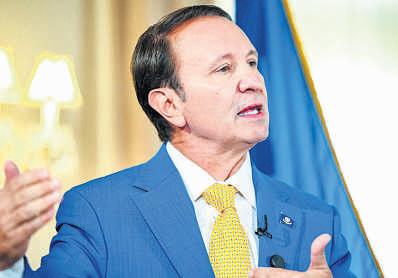
true objective away when he told radio host Moon Griffon that once thebill becomes law,“if rates don’tgodown, then it’son[Temple.]”Inother words, Landry isn’t doing anything about rates;he’s just settingupthe blamegame so it falls on the commissioner All of which is background, making Landry’spower play look even more petty.Yet even if the underlying bill at the real heart of this matter were one of an honorable philosophical stance rather than apetty blame game, Landry’svetoes still would be unseemly Granted, it is standard, old-style political hardball to grant or with-
hold support depending on how cooperative afellow politician is. Even political hardball, though, usually pays at least somehomage to context and proportionality.Landry’sline-item vetoes lack both. Unless asingle bill is really do or die for agovernor’ssubstantiveagenda, opposition to that bill from those otherwise the governor’sallies hardly qualifies as amajor political affront especially if the bill passes anyway, which the “blamethe insurance commissioner” bill did. Andeven then, political retribution is morelegitimately aimed toward insider-baseball
status, such as the granting or withholding of plum committee assignments. Instead, Landry’sfit of pique results in blocking objectively reasonable projects whose primebeneficiaries would not have been the politicians themselves but the Louisiana constituents they serve.
As in: “Hah: If you won’thelp me pass abill that lets me blame the insurance commissioner for high rates, your constituents will still have unsaferoad access to their children’sschool in Bossier City.” Or: “You wantasafer bridge in Plain Dealing? Sorry dude, if your people have accidents, but you voted against me, so your people can stuff it.” Unfortunately,Landry has madeahabit of this sort of bullying power play,tothe detriment of ordinary Louisianans. Witness the Southeast Louisiana Flood Protection Authority-East which, as Iwrite, still literally lacks a quorum of appointed members even in the midst of hurricane season, and which is riven by discord nearly to the point of fisticuffs, all because of Landry’s anti-reformist, power-grabbing schemes there.
Landry should learn that the days of Huey Long are long past. Louisianans these days are less likely to reward petty tyrants than (figuratively speaking) to throw them out on their ears. Quin Hillyer canbereached at quin.hillyer@theadvocate.com.
ICE’scrackdown is hittingway tooclose to home
It was the part about Habitatfor Humanity that got me, that detail in reporter James Finn’sstory that showed Mandonna “Donna” Kashanian, alongtime NewOrleans resident originally from Iran,isso embedded in our community —and so committed to it —that she volunteered to build homes for those in need after Hurricane Katrina Kashanian wasn’tvolunteering two weeks ago, but she was minding her own business, living herlife, literally tending her own garden, when federal agents in unmarked vehicles pulled up to her Lakeview home, handcuffed her and took heraway, leaving herU.S.citizen husband and adult daughter frantic.
remotely resemble the criminals Trump keeps talking about are getting snatched from workplaces, streets,even courthouses where they’re attempting to workwithin the system.
which she’s apparently been doing all these years.


Her possible offense —I’m notgoing to say “alleged” because there are no formal allegationsofwrongdoing—isthatshe was in this country with the full knowledge of ourgovernment for years,complying with the rules it had put in place for hertostay, until those rules suddenlychanged. That’sthe brutish new reality that President Donald Trump’smasscrackdown on immigrants has created, here and across the country In fact, Kashanian could be the poster child for just how misguided and destructive the policy is, as people who don’t
Except thatthere aresomany other stories like hers.
One involves aBaton Rouge family andanother mother,this one with a one-year-old and ababy who was just 9weeks old when PaolaClouatrewas seized, literally as she was checking in with authorities under theterms ourgovernment had set Now Clouatre’shusband Adrian, who served ourcountryasaMarine, is figuring outlife as asingle dad of two tiny U.S. citizens —one still nursing, at leastonthe days when hemakes the long drive to the ICE detention facility in Monroe wheretheir mom is lockedup.
Neither of these Louisiana women have anythingintheir biographies thatwould suggest they’re athreat to anyone, or even that they intended to evade any rules.
Kashanian arrivedinthe U.S. in 1978 on a student visa. Her father was an associate of the U.S.-backed shah who was overthrown a yearlater,but she was denied asylum. She was, however,told she could stay as long as she obeyed the law and showed up for allher immigration appointments,
Clouatre arrived from Mexico when she was 14 withher mother,who failed to appear at atrial on her asylumclaim two years later,something Clouatre says she didn’teven know until recently. She’sbeen going through theprocess of seeking legal status, which is why she was at thecourthouse theday she was detained.
Even if there’s morewedon’tknow about either case, authorities have made no claim to justifythis treatment. And the punishment is so out of proportion to any risk they could conceivably pose thatitmakes the head spin.
These policies here and around the country arehurting the economy —somuch so thatTrumphas toyed with the ideaof leaving the folks who work on farms andin hospitalityalone, even as he got Congress to cough up billions in new funding to expand his crackdown
As bad as that is, what it’sdoing to our very national psyche is worse. And nobody should knowthat better thanpeople around here
If Kashanian’sgenerositytoher neighbors after Hurricane Katrinamakes her aparticularly sympathetic figure in this whole mess, there’s alsothe well-known story that immigrants —documentedand
not —did muchofthe backbreaking work to rebuild NewOrleans and other areas destroyed by the monster storm, even as they were often subject to abuse and wage theft by those who knewthey’d be afraid to complain or contact authorities. We thanked them back then. Even celebrated them on the occasional Carnival float.
Now masked agents are stalking and chasing migrants looking for work outside of Home Depots. It’s almost like the Trumpadministration is issuing somesort of dare, to see if the public will tolerate this treatment of people whodowork that needs doing without making trouble. All to intimidate those whomight try to come here or to pumpup the deportation numbers or,I don’tknow, to just show it can. All because it’seasier to act like thugs than to do the hard work of legislating immigration policies that work forour country and forthe those drawnto it. If the American people accept this level of senseless, gratuitous, self-defeating cruelty,what else will they swallow? It’sgetting so that I’m almost afraid to find out.
Email Stephanie Graceatsgrace@ theadvocate.com.
The U.S. Supreme Courtkept millions of Louisianans —and millions more across the nation —waiting for one of the most consequential decisionsinrecent election history
Then they punted.
Ifind myself in the strange position of agreeing with Justice Clarence Thomas, at least in part.
In an 8-1 decision, the high court decided not to decide Louisiana v. Callais and Robinson v. Callais, acouple of cases on appeal to the Supreme Court based on challenges to the state’s sixth congressionaldistrictmap. It’saseat that was won byU.S. Rep. Cleo Fields with 50.8% in fall 2024. Some self-identified “nonBlack” challengers to the district’s map argue that it was done with racial gerrymandering and is therefore unconstitutional. With asingle-paragraph, twosentence decision, the court said: “Thesecases arerestoredtothe calendar for reargument.Indue course, the Court will issue an order scheduling argument and

specifyingany additionalquestions to be addressed in supplementalbriefing.” If you’ve used the phrase “in due course,”you know what you mean is “You’ll get it whenyou get it.” Thomas disagreedwith thatapproach. In adissent much longer than the opinion, the justice said thecourt was wrong to delaya decisionbecauseit has“an obligation to resolve such challenges promptly.”

He’s gota point With no ruling from SCOTUS, all Louisiana congressional districts stay as theyare, including Fields’ district, which runs through Lafayette,Baton Rouge and Shreveport. That bodes well for incumbent Fields getting another term. It sure would’ve been nice to knowinadvance of next month’s 60th anniversary of the1965 Voting Rights Act that this consequentialact —powered to fruitionbythe civil rights movement —will be protected, not damaged, pushedsideorthrown away Alas, we must wait, at least until
the fall. Or maybe spring. There are so many things going againstthe voting rightsprogress made sincethe 1960s that Iworry about what our state and our nationmight look like if therearen’t safeguards guaranteeing everyone’s right to vote. Instead of issuing aruling to stand by amap agreed to by our Republican governor and our Republican State Legislature, the high court said it needs moretime and moreinformation. The court’s“supplemental briefing order” is alegal maneuver that keeps thingsasthey areafter a Supreme Court case has already been argued. It’s not clear what information the courtwantstomake adecision. But it likely means the courtwants to hear more, generally or specifically.The justices might be seeking clarity, or they may want to hear more about a specific point. Though it doesn’tmean eight justices agree on what should be done, it does mean the majority decided thatthey don’thave enough information to make a decision.
Here’sthe thing: Even if the courtprovides details this summer while they’re on vacation, they’re not likely to receive anything officially until they return the first Monday in October.Even if theyhear arguments in October, it’snot likely that they’ll decide the caseinamatter of days. They’re morelikely to review whatthey get and not issue aruling until sometime in 2026.
That’sdangerously close to Louisiana’s spring primary and the fall midterm and general election. Next year, our state’sprimary systemkicks in. Qualifying for the primary is in mid-January The election is April 18. If there’s no clear winner,the top two votegetters will compete in asecondparty primary on May 30.
That means party candidates will be primedand ready to roll sometime this year,qualifying in Januaryand going into full campaign mode shortly after What is acongressional candidate to do if the court rules in the middle of acampaign that our state congressional maps must be redone?
Doesthe governor call aspecial session and quickly find agreement on the already-challenging matter of putting population mixes into districts that satisfy the ruling but upsetting all of the politics and public policy work that would have gone into well-underway campaigns?
The fall congressional general election is scheduled for Nov.3, the day all 435 congressional seats are up for election. So are 33 of the nation’s100 U.S. Senate seats. If there wasasurprise ruling within weeks of the court returning, the Louisiana Legislature might have to convene for aspecial session to get something done before qualifying. With Thanksgiving and Christmas coming? I don’tthink so. Iagree with Thomasthat aruling would’ve been better.But I fear what might’ve been if they had issued aruling in sync with Justice Thomas’sthinking that the Constitution should prevail over the Voting Rights Act.
Email Will Sutton at wsutton@ theadvocate.com.

STAFF FILE PHOTOByJAVIER GALLEGOS
Gov. Jeff Landry
Stephanie Grace Quin Hillyer
Will Sutton
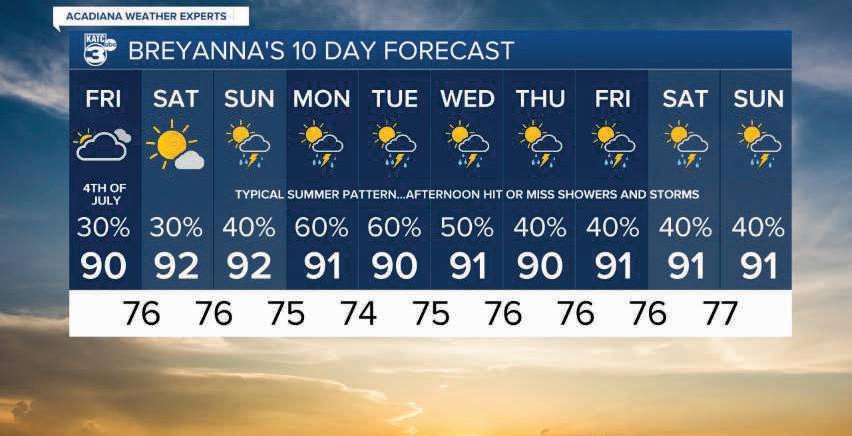










Shown















































Drivefor LIVGolf in N.O. a wayward attempt
Youmight have heard that LIVGolf is coming to New Orleans.
If you haven’t, you will soon In the weeks ahead, state officials areexpected to announce that NewOrleans will be one of five U.S. stops on the 2026 LIV schedule.
PREVIEW RUNNIN GBACKS
KA A? WHO’S AFTER SAINTS



A2026 LIV schedule leaked to Sports Business Journal last week that showed New Orleans, along with South Africa, as one of two new stopsonthe tour.The schedule is still being finalized, but theNew Orleans tournamentistentatively scheduled for June2628 at BayouOaksgolf course in City Park. Unless you’re agolf fan, you might not haveheard of LIV.The tour was created as an alternative to the PGA Tour anddebuted in 2022. It featuresthe highest tournament purses in golf history and some of the world’sleading players, includingJon Rahm,BrooksKoepka, Dustin Johnson and Patrick Reed.
The LIV tournament duringthe last weekend in June in Dallas offered $25 million in purse money,more than twicethe $9.2 million offered at theZurich Classic this year.LIV also reportedly paid Rahm a$302million signing bonusaspart of his multiyear,$566 million contract
The controversy with LIV lies withits owner and financier,the kingdom of Saudi Arabia and Crown Prince Mohammedbin Salman, who has along history of humanrights violations.
Arecent investigation bythe U.S. SenateCommittee on Homeland Security and Governmental Affairs determined that “foreign influenceefforts bySaudiArabia
ä See DUNCAN, page 3C

the U.S. Open at Oakmont CountryClub on June 15 in Oakmont, Pennsylvania.

Saints running back Kendre Miller runs throughdrills during practice at minicamp on June 10 at
Sports Performance Center ASSOCIATED PRESS PHOTO By GERALD
BY LUKE JOHNSON Staff writer
Alvin Kamaraisback to reprise his lead role in the New Orleans Saints backfield, but what happens after him is anyone’sguess.
Kendre Miller has anew number, having switchedtoNo. 5, but it remains to be seen whether he will be adifferent player under new coach Kellen Moore. Rookie Devin Neal had plentyofadmirersinthe predraft process,but he’s alsoasixthround pick. Cam Akers andClyde Edwards-Helaire were once namebrand players but are nowfighting for aroster spot.
It’salso worth noting the Saintsreportedly were checking in withfree agent Nick Chubb before he signed with the Houston Texans.
RB DEPTH CHART
PLAYER HT WT EXP.
Alvin Kamara 5-10 215 9
Kendre Miller6-0 220 3
Devin Neal 5-11 213 R
Clyde Edwards-Helaire5-7 2076
Cam Akers 5-10 217 5 Marcus yarns5-11 190 R
This can go any numberofdirections,including onewhere New Orleans decides to keep one eye on the free agent/trade market. Best case
One doesn’thave to squint too hard to seeMoore’splay-calling getting themost out of arunning game. Youcan even ignore last year’sSu-
perBowlrun with the Philadelphia Eagles, who fed amutant running back theballbehindanoffensive line thathad four of its five starters makeeither the Pro BowlorAll-Pro teams.
While Moore is known for the plays he’s dialedupinthe passing game, his offenses have finished with atop10 rushing attack in four of his six years as aplay-caller,including two top-five seasons. With ayoung quarterback under center,the 2025 Saints offense might lean heavy on the run game. That could be good newsfor Kamara, who is coming off apersonal-best 950 yards rushing last season, and it also could be good news for whoever wins the competition behind him
Djokovic joinselite companywith100th Wimbledonvictory
Seven-time champroars way to fourth round, defeats Kecmanovic 6-3, 6-0, 6-4
The Associated Press
LONDON Novak Djokovic became only the third player in Wimbledon historytoreach 100 victories —after Martina Navratilova and Roger Federer —with his 6-3, 6-0, 6-4 win in the third round over Miomir Kecmanovic on Saturday
Djokovic, who has wonseven of his 24 Grand Slam titles at the All EnglandClub, took control by winning nine consecutive games from 3-3 in the first set on Centre Court against his Serbian compatriot en route to his latest milestone.
“Any history that Imakeinmyfavorite tournament, I’m blessed,”Djokovic said in an on-court interview
The 38-year-old Djokovic, playing in his 20th Wimbledon, will nextface No. 11 Alex de Minaurfor aspot in the quarterfinals
Djokovic,who could potentially meet No 1JannikSinner in the semifinals, haslost thepast two Wimbledon finals to Carlos Alcaraz.
Djokovic made just eight unforced errors throughtwo sets andled 5-1inthe final set before Kecmanovic madehim workfor the victory.
“I have enjoyed myself very much except maybe the last couple of games. Things got abit complicated,” said Djokovic, who finishedwith 60 winnersand 19 unforced errors, along with 16 aces.
The highlight of thematch came in the eighthgame of the first set, with Djokovic looking to break. His diving backhand volley winner at the net on the fourth deuce sailedpast Kecmanovic,who slumpedhis shoulders as he watched the ball land in down the line.Onthe ground, Djokovic smiled andsoakedinthe applause fora moment before goingontoearn thekey break. “I try not to takeanythingfor granted,
See WIMBLEDON, page 3C

Jeff Duncan
AP PHOTO By CHARLES LABERGE
JonRahm of Legion XIIIhitshis shot from the seventh tee during the final round of
See SAINTS, page 3C
WIGGLESWORTH NovakDjokovic returns to Miomir Kecmanovic during athird-round Wimbledon match on SaturdayinLondon.
the Ochsner
HERBERT
BROADCAST HIGHLIGHTS
LSU gets commitment from Haynesville star
LSU added its 14th football commitment for the 2026 class with the addition of Haynesville High School’s Isaiah Washington.
The 6-foot-2, 170-pounder Washington, who is projected as a safety in college, committed Friday along with Laurel, Mississippi, four-star offensive tackle Bryson Cooley
A three-star prospect by 247Sports Washington chose the Tigers over Arkansas, Tulane, Baylor and Louisiana Tech. Washington led perennial power Haynesville to back-to-back state championship appearances as a quarterback and defensive back.
WIMBLEDON
First-time winner assured
‘Stubborn’ Navarro dispatches reigning champion Krejcikova
BY HOWARD FENDRICH
AP tennis writer
LONDON Emma Navarro describes herself as “stubborn” and her tennis as “scrappy.” The American’s attitude and game both were in just the right places at Wimbledon on Saturday, when she pulled off another Grand Slam victory over a reigning champion by eliminating Barbora Krejcikova 2-6, 6-3, 6-4.
Sending an ill and dizzy Krejcikova home in the third round, the 10th-seeded Navarro extended a recent run of one-and-done winners at the All England Club and assured the grass-court major of yet another first-time women’s champion
“Something I take a lot of pride in is being tough and fighting till the last point, no matter what the circumstances are. It’s something I always try to do,” said Navarro, who was born in New York, grew up in South Carolina and won the 2021 NCAA championship for the University of Virginia. “I could never live with myself if I ever gave up. It’s just not in my nature. I don’t think it’s in any of my family members’ nature to ever give up on anything. I guess we’re a stubborn bunch.”
Krejcikova faded in the third set, getting her blood pressure checked at the changeover after Navarro broke her to lead 3-2 at No. 1 Court. Krejcikova ate a banana and drank liquids during the medical timeout, while Navarro walked to her guest box and spoke to her coach during the break in action When play resumed, Krejcikova showed clear signs of being in distress, often leaning over and placing her hands on her knees between points “I was actually feeling worse and worse,” said Krejcikova, who was seeded 17th but now will tumble out of the top 70 in the WTA rankings. “It’s very sad for me and very unfortunate.”
This is hardly Navarro’s first big win on a big stage. Last year she eliminated Coco Gauff at Wimbledon to reach her first major quarterfinal. Then, in a rematch a cou-

ple of months later, Navarro won again at the U.S. Open — where Gauff was the 2023 champion en route to her debut in a Slam semifinal.
Whoever ends up winning the Wimbledon women’s title on July 12 will be the ninth champion in the past nine editions of the grasscourt Grand Slam tournament.
Serena Williams was the last repeat champ in 2016.
The trophy-takers since then have been Garbiñe Muguruza in 2017, Angelique Kerber in 2018, Simona Halep in 2019, Ash Barty in 2021 — all of whom are now retired — Elena Rybakina in 2022, Marketa Vondrousova in 2023 and then Krejcikova (the tournament was canceled in 2020 because of COVID-19).
Rybakina lost Saturday; Vondrousova exited in the second round.
Against Krejcikova, Navarro was down a set and a break at 2-1 in the second before turning things around.
“I kind of regrouped a little, tried to slow things down a bit from my side and make her look at some different shots,” said Navarro, 24 who will meet No. 7 Mirra Andreeva, an 18-year-old Russian, on Monday for a quarterfinal berth.
“Kind of just try to make her as

Barbora Krejcikova gets assistance during Saturday’s match. ‘I was actually feeling worse and worse,’ said Krejcikova, who had her blood pressure checked. ‘It’s very sad for me and very unfortunate.’
uncomfortable as I could.” Most points were decided by what Krejcikova did. That’s how she ended up with 34 winners — 21 more than Navarro — and 53 unforced errors Remarkably Navarro finished with just 11 unforced errors. Last year’s triumph was the second at a major tournament for Krejcikova, who also won the 2021 French Open. It has been a fortnight filled with surprises, and Navarro is one of
four top-10 seeds left in the women’s bracket The others are No. 1 Aryna Sabalenka, who won her third-round match Friday against Emma Raducanu, Andreeva and No. 8 Iga Swiatek, a 6-2, 6-3 winner against Danielle Collins on Saturday
“My slice is coming along pretty nicely I’m able to use that to my advantage,” Navarro said. “Played scrappy at times. Played tough. Hit some good groundstrokes, as well. I feel pretty good about where I’m at.”
Sinner cruises again, moves to Round of 16
Italian has lost just 17 games through first three rounds
BY HOWARD FENDRICH
AP tennis writer
LONDON As well as Jannik Sinner is playing at Wimbledon, he doesn’t appear to need much in the way of help. Still, he got some Saturday when his opponent, Pedro Martinez, was dealing with a problematic shoulder and often put in first serves at so-so speeds.
The No. 1-ranked Sinner has dropped a record-tying total of only 17 games so far, made his way to the fourth round for the seventh consecutive Grand Slam tournament — he’s collected three such trophies in that span — and never was truly in trouble during a 6-1, 6-3, 6-1 victory over No. 52 Martinez.
“We all saw that he was struggling,” Sinner said, then noted about his own form: “First week couldn’t have gone better.”
Sinner is the second man in the Open era, which began in 1968, to cede just 17 games through three completed matches at the All Eng-

land Club. The other player to do that, Jan Kodes, ended up losing in the semifinals in 1972. For Sinner, there’s been zero sign of any sort of inability to move past last month’s French Open final, which he lost to Carlos Alcaraz in five sets despite taking the first two and holding three championship points. Against Martinez, Sinner who returned in May from a three-
month doping suspension went up 5-0 after 20 minutes. During that stretch, Martinez managed one winner, while Sinner accumulated 10. That’s when Martinez took a medical timeout, and a trainer massaged the back of his right shoulder The Spaniard was delivering first serves as slow as 76 mph, compared with Sinner’s high of 133 mph. That aspect of Martinez’s game
improved incrementally, but the only, ever-so-brief, moment of intrigue at Centre Court came in the second set, about 75 minutes in, with Sinner up a break and serving at 4-3. That’s where Martinez managed to accrue his first four break points. Sinner stayed as calm as can be
— “I don’t think Sinner’s changed expressions once in this match,” John McEnroe observed on BBC’s telecast and erased all four of those chances, held for 5-3, then broke to end the set.
Soon enough, Sinner twice an Australian Open champion, once a U.S. Open champion and a 2023 semifinalist at Wimbledon — was headed into a contest Monday against No. 19 Grigor Dimitrov Who’s playing Sunday? No. 1 Aryna Sabalenka coming off a riveting win against Emma Raducanu, returns to Centre Court to face No. 24 Elise Mertens as the fourth round begins. Sunday’s last scheduled match in the main stadium features two-time reigning champion Carlos Alcaraz against No. 14 Andrey Rublev Over at No. 1 Court, 2024 U.S. Open runner-up Taylor Fritz begins play at 7 a.m. against Jordan Thompson.
LSU now has commitments from eight in-state prospects and five defensive backs.
The Tigers have a chance to keep adding to their class, which is currently ranked No. 10 nationally by 247Sports, when five-star defensive lineman Lamar Brown of U-High makes his decision next week.
Kenyans set world record at Prefontaine Classic
EUGENE, Ore. — Kenyans Faith Kipyegon and Beatrice Chebet set world records and American Melissa Jefferson-Wooden won a starstudded women’s 100 meters Saturday as the Prefontaine Classic celebrated its 50th anniversary Kipyegon finished the 1,500 in 3 minutes, 48.68 seconds, besting her own record of 3:49.04 in the event set last year Chebet became the first women to run under 14 minutes in the 5,000, finishing in 13:58.06. Jefferson-Wooden, who took the bronze medal last summer, finished in 10.75 seconds. Sha’Carri Richardson, a former LSU star and the silver medalist in Paris, finished last in the nine-runner field.
Two-time All-Star closer Jenks dies at age 44
CHICAGO Bobby Jenks, a twotime All-Star closer and World Series champion with the Chicago White Sox, has died, the team announced Saturday He was 44.
The White Sox said Jenks died Friday in Sintra, Portugal, where he was being treated for adenocarcinoma, a form of stomach cancer Jenks helped the White Sox win the 2005 World Series, saving four games in six appearances during the postseason He was an All-Star in each of the next two seasons while saving 41 games in 2006 and 40 in 2007. He retired 41 straight batters in 2007, matching a record for a reliever Jenks saved 173 games for the White Sox from 2005-10 before finishing his career with the Boston Red Sox.
Thompson breaks late logjam at John Deere
SILVIS,Ill.— Davis Thompson made a 10-foot birdie putt on the 18th hole Saturday to break out of a logjam that at one point featured 10 players tied for the lead, giving him a 4-under 67 on a much tougher golf course and a one-shot lead in the John Deere Classic. Thompson was among five players tied for the lead when he stood over his final putt, after Brian Campbell had just holed a 30-foot birdie putt. His final birdie put him at 15-under 198, one shot ahead of Campbell, Max Homa, Emiliano Grillo and David Lipsky, each of whom had a 68.
About the only player not in the mix was 36-hole leader Doug Ghim who played his last 10 holes with two bogeys and no birdies and shot 74, pushing him outside the top 20.
Van Gisbergen wins pole at NASCAR race in Chicago
CHICAGO When it comes to NASCAR’s street course in downtown Chicago, there is Shane van Gisbergen, and then there is everyone else. Van Gisbergen won the pole for Sunday’s Grant Park 165. The 36-year-old New Zealander turned a lap at 88.338 mph on a tricky 2.2-
ASSOCIATED PRESS PHOTO By KIRSTy WIGGLESWORTH
Jannik Sinner of Italy returns to Pedro Martinez of Spain during a third-round match at Wimbledon on Saturday in London Sinner won 6-1, 6-3, 6-1.
ASSOCIATED PRESS PHOTOS By ALASTAIR GRANT
mma Navarro of the U.S celebrates after winning her third-round match against Barbora Krejcikova of the Czech Republic on Saturday at Wimbledon in London Navarro won 2-6, 6-3, 6-4 to advance to the Round of 16.

during minicamp on June 10 at the Ochsner Sports Performance Center
DUNCAN
Continued from page1C
and similar malign actorsare growingin scope, sophistication and reach.”
When the official announcementofthe New Orleans tournamentcomes, state officials undoubtedlywill downplay the “sportswashing” chargesagainst Saudi Arabiaand Prince Mohammed, while trumpeting the economic developmentpotential of the event. But let’s be clear: This hasall the markings of apolitical favor, masked as an economic developmentinitiative —and acostly one. Theeventwill costtaxpayers $7 million
The state plans to spend $2 milliontoimprove the Bayou Oaks course, an upgrade forced primarily on the club’s driving range. The other $5 million will go directly to LIV as a“hosting fee,” whatever thatis. The deal smells fishier than aVenice shrimp boat New Orleans City Business noted earlier this year,“Some of the Landry administration’senthusiasmfor LIV Golf League might be related to PresidentTrump, who considers Crown Prince Mohammed bin Salmanapersonalfriend andwho theLouisiana governor is eager to please.” LIV’srelationshipwith rump hasbeen well-documented. LIV has played at a Trump property every year since its inception. Trump resorts in Florida, NewJersey and Virginia have played host to LIV events.
Washington Post columnist Sally Jenkins summed up the relationship well: “The president does business with LIV golf, through which he hopes tobuild the popularity of his meh resorts. LIV’sfinancier is Saudi Arabia and Crown Prince Mohammed bin Salman, who wishes to launder himself clean of kidnap and torture through golf.”
No one, other than perhaps the good folks at Bayou Oaks, is banging the drum forLIV Golf in New Orleans.
We already have agreat golf tournament. The PGA Tour’sZurich Classichas beenafixture on thelocal sports scene for decades. The tournament’s titlesponsor,Zurich Insurance, has been avaluable corporate partner for the cityand region, helping to contribute more than $24 million to local children’sand youthcharities in the past10years alone.
When asked about the potential of aLIV event in New Orleans, Steve Worthy —the CEO of the Fore!Kids Foundation,which produces the Zurich Classic for thePGA Tour —took the high road
“I’m so proud of our title sponsor,Zurich, and their 21-year commitmenttoour city and state and proud of the charitable efforts of our members to have given $24 million over last 10 years,” he said. “We’ll continue to try to grow our events and charity numbers. If there is competitionon alevel playing field, we will welcome it.”
Why the state wouldwanttocourt a directcompetitor to Zurich andthe PGA Tour is aquestion worth asking.
Among others:
Is Bayou Oaks capable of hosting an event of such size and scale?
Is there any tangible benefit to New Orleans, other than the state’s investmentto the City Park driving range?
Is there acharitablecomponent involved?
How will this affect thecoffers of the state’smajor events incentivefund, which longstanding institutions suchas


SAINTS
Continued from page 1C
In the ideal scenario, that means either MillerorNeal is the secondary option, with both of themmakingthe roster and contributing in some way
Those who have followed Miller’scareer since the Saintspicked him in thethird roundofthe 2023 draft are probably sick of hearingabout his potential, and thisfeels like it could be his last shot to show what he can do in New Orleans. He has been injured, yes, but that hasnot been theonly limiting factor.Ifthe Saintscan gethim pointed in the right direction, he does have explosive ability and the size to carry aworkload (Miller’s injuries largelyhavebeen softtissue ones).
Neal is not theathlete that Milleris, but
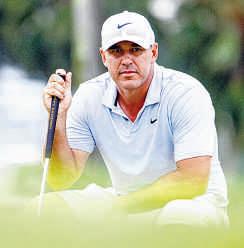
AP FILEPHOTO By CHARLES LABERGE
Brooks Koepka of Smash GC reads his putt on the 12th green during the second round of LIV Golf Singapore on May4 at Sentosa Golf ClubinSentosa, Singapore.
the Greater New OrleansSports Foundation andSugar Bowl rely on tolure Super Bowls and College Football Playoff games to thecity? Perhaps mostimportantly,why is the state paying $5 million to an organization that clearly doesn’tneed it?
Thejuice almost surely won’tbeworth the squeeze.
Stateofficials’ claim that the event will generate a$60 million economic impact for thearea is laughable. The 2024 Zurich Classic, which set records for attendance and TV ratings thanks to the presence of Rory McIlroy and Shane Lowry, generated a$59.9 million economic impact, according to an independent study.Tothink that LIV could approach such numbers in late June, when most sane New Orleanians are eitherensconced in the comfort of their air-conditioned homesorheaded out of town to the beach or mountains, is unrealistic.
While LIV hasseen notable increases in attendance and TV viewership at some of its events thisyear,the tour’spopularity palesincomparison to the established PGA Tour
Consider this: CBS averaged 1.63 million viewers for its final-round broadcast of this year’sZurichClassic,afigure that incorporates more than two hoursofnonlive golf after the network was forced to air areplayofthe 2024 Zurich Classic during that window until play resumed later in the evening because of weather At the same time, LIV Mexico averaged just 110,000 viewers on FS1.
Therecent LIV event in Dallas averaged 163,000 viewers across Fox and FS2. ThePGA Tour’s Rocket Classic in Detroit, meanwhile, attracted an audience of 2.79 million on CBSfor Sunday’sfinal round.
While LIV officials celebratedrecord on-site attendance at recent events in Nashville, Tennessee, andDallas, the three-day total of 40,000 was only about a third of what the Zurich Classic attracted (116,000)two years ago.
So,asyou can see, the juice isn’tworth theLIV squeeze. Holding apro golf tournamentinlate June in NewOrleans makes little sense. Paying millions to some of the wealthiest people in theworld to do it makes even less sense.
The only thing morenonsensical would be trying to put an NHLteam in New Orleans.
Email JeffDuncan at jduncan@theadvocate.com.


he was wildly productive at Kansas, and the NFLhas proven timeand againthat teams can findcapable running backs on Day 3of thedraft.Just in thelast three years, three Day 3picks (Kyren Williams, Bucky Irving and Tyler Allgeier) have topped 1,000 rushing yards in asingle season. Kamarawill turn 30 in July,and though he is coming off an excellentindividual2024 season, the Saintsshould hopethey can find someonetoease his burden this year
Worstcase
WhatifKamara’sbounce-back season was becausehewas especially well-suited for the wide zone schemethat KlintKubiakbrought in lastseason? Andwhatif his heavy workload from the last fewyears catches up to him? Whatifneither Miller nor Neal is ready or able to step into asomewhat featured role?Whatifdefenses load up on the runand theinexperienced quar-
WIMBLEDON
Continuedfrom page1C
particularly (at) thisage, still going strong, still trying to compete with the young players anddosome slides andsomesplitson thecourt, and push myself to the limit,” he said.
Navratilova, anine-time Wimbledon singles champion, amassed 120 singles victories. Eight-time championFederer reached 105 singles wins
Djokovic won the match Saturday,but it was his7-year-old daughter who really wowed Wimbledon.
Tara Djokovic’svictory dance brought a smile to dad’sface. Everybody else’s, too.
terback is not able to consistentlymake them pay forthat?
All of these are plausible outcomes for theSaintsin2025. The running back group could exceed expectations, and it also could crater NewOrleans can’tafford to put too much burden on its young quarterback, not only for this season’s resultsbut also to geta gauge of what they have at theposition in the future. The Saints are likely going to need acompetent running game to truly evaluate whatthey have at quarterback, and there is avery real scenarioinwhich they do not get that this season.
Prediction in 10 wordsorless Amore efficient Alvin Kamarashows he still has it.
Email Luke Johnson at ljohnson@theadvocate.com.
Djokovichad just clinched the victory andwas askedduringhis on-court interviewtoshedlight on the little dancehe’s been doing recently
He said it’s done to asongcalled“Pump It Up.”
“There’sasong with my kids —look, my daughter’sdoing it right now,” asmiling Djokovic said as he looked into the crowd.
“You wanttoshow it, Darling?”
TheTVcamera then panned to Tara, who then showed everyone how it’sdone: pump your fists down,thenleft, rightand overhead. The crowd roared.
“She’sthe master,” Djokovic said. “It’s alittle tradition we have rightnow.Hopefully we can keep going so we can keep pumping moreinWimbledon.”















STAFF PHOTO By SOPHIA GERMER Saints running backAlvin Kamaraholds the ball as he practices with teammates
ASSOCIATEDPRESS PHOTOByKIRSTy WIGGLESWORTH NovakDjokovic returns to Miomir Kecmanovic during athird-round Wimbledon match on SaturdayinLondon.
LIVING






Dan an AT RANDOM ny Heitm DannyHeitman
Zydeco with breakfast agreat way to starta weekend
My wife’sbirthday arrives each June,when small summer road trips seem like agood way to celebrate. Our destinations are often no more than acouple of hoursaway,which allows us to make other plans back at home.
Those short hops have connected us with different parts of Louisiana over the years, reminding us that this corner of the world isn’t justone place, but many For one birthday,when our kids were small, we traveled to abamboo nursery in Washington Parish. Light rainfell as we parked our van within athicket of towering canes and waited for the weathertobreak. We all felt, Ithink, as if we were resting within summer’sdeep, greenheart.
Acouple of years ago, Itoasted my wife’s birthdayatWest Feliciana Parish’sSt. Francisville Inn, alovely old Victorian house that’sbeen reimagined as alodging and restaurant. In thequiet creak of the floors, we could hear the past murmuring its little secrets.
For my wife’sbirthday last month, we rose early,packed the car with mugs of coffee, and drove to Breaux Bridge for zydeco breakfastatBuck &Johnny’s, arestaurant and performance venue that serves up eggs, biscuits, hot cakes and live zydeco music each Saturday.Folks often arrive early to wait in line for the doors to open at 8a.m. Eavesdropping on theother customers who gathered outside wasanentertainment in itself. One woman noted with pride that her mother’srecent confinement to awheelchair hadn’tstopped their social life.
“Wejust wheel Mama wherever we go,” she said, “andwe pass agood time.”
Another regular mentioned that not long ago,she had followed her zydeco breakfast with more dancing downthe road.
“It was 4inthe afternoon when Ilookedatmywatch,” she sighed. “I wondered where that Saturday had gone.”
Saturdays seem to floatby easily at Buck &Johnny’s, where we were handed acocktail menu as we took our seats. Youknow you’re in Louisiana, Ithought to myself, when a
ä See AT RANDOM, page 4D
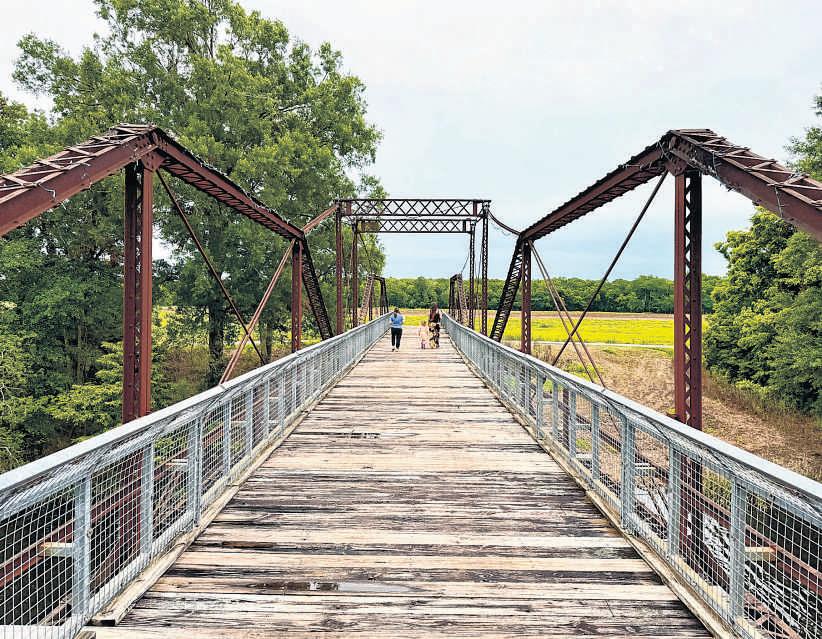
CROSSING TIME
AwalkoverLouisiana’s SartoOld Iron Bridge that connects past andpresent
BY ROBIN MILLER Staff writer
Brittany Bowman walks across the SartoOld Iron Bridge to workeach morning
The walk from her home to the Adam PonthieuGrocery Store and Big Bend Post Office Museum, whereshe works as the manager,takes about six minutes.

It’s the same bridge where she and her cousin spent childhood summers jumping an iron blockadetoplayonits rotting planks crossing Bayou des Glaises.
That was in the1990s,when only a sign stating “HistoricBridge” along La.1atMoreauville pointed drivers to the deteriorating structure thatonce stood as an Avoyelles Parish landmark at thehalfway point of the 40-plus-mile loop that is La. 451. The bridge has been there since 1916.
ä See BRIDGE, page 4D
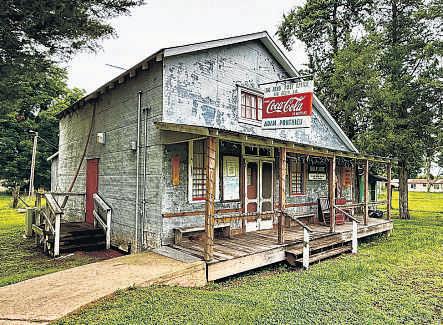
The Adam Ponthieu GroceryStore and Big Bend Post Office Museum stands across La.451 from the Sarto Old Iron BridgeinAvoyelleParish’sBig Bend community.The museumnot onlytells the storyofthe bridgebut also the historyofthe surrounding communities.
WhydoesCovington have world’slargest Ronald Reagan statue?
BYJULIA GUILBEAU Staff writer
At 9feet tall and 1,300 pounds, abronze statue of the 40th president of the United States has for years served as arecord holder of sorts, towering over those passing through the Covington’s Tammany TraceTrailhead.
Thelarger-than-life statue of Ronald Reagan, who stands with asmile and asalute, is reportedly the world’stallest —2 feettaller than those in the U.S. Capitol’s Rotunda and Budapest, Hungary
What’sReagan’sspecial connectiontothe northshore city?
There really isn’tone. The former Republican official and Hollywood star never visited Covington during his eight years as president, though he did make

several stops in New Orleans. Thememorial’screation instead starts with Patrick F. Taylor,anoil tycoon, Louisiana philanthropist and close friend of Reagan. Thepair’sfriendship dates back to when Reagan was still California’sgovernor and wassparked by their mutual love for cowboy boots, according to PatrickTaylor’swife, Phyllis Taylor AfterReagandied in 2004, Patrick Taylor set out to find a way to commemorate him in Louisiana, offering to pay for amonument in his honor.That
dream came true in 2008 when thebronze Reagan was officially placed in Covington.
“The donation of this beautiful statuecommemorates the deep friendship theTaylors had with President Reagan,” then-Mayor Candace Watkins saidinaTimesPicayune article, written the day thestatuewas officially erected. Taylor,however,never got to see his grand project finalized. He died three yearsbefore the memorial was complete. So whyCovington?
St.Tammany,like much of Louisiana, had flipped from its former Democratic leanings by 1980, transforming into aGOP stronghold whereReagan easily won in that year’selection.
ä See STATUE, page 4D
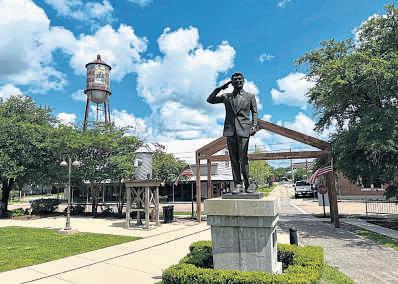
STAFFPHOTOSByROBIN MILLER
TheSarto Old Iron Bridgecrosses Bayoudes Glaises along La. 451 in Avoyelles Parish’sBig Bend community near Moreauville. The bridge wasbuilt in 1916 and servedasanescape route for community residents during the Great Flood of 1927. The bridgewas restored in 2011, and visitors are allowedtowalk across it.
STAFF PHOTO By JULIA GUILBEAU
Alargebronzestatue of RonaldReagan, titled ‘AnAmerican Hero,’ overlooks the Covington TammanyTrace Trailhead

‘Passing it on’
BY RIEN FERTEL
writer
“Passing It On: The Art of John T. Scott,” by Freddi Williams Evans and Anna Rita Scott, Louisiana Endowment for the Humanities, 120 pages
The multimedia New Orleans artist and teacher John T. Scott often ended class with his signature phrase. “Pass it on,” he’d tell his students: simultaneously a farewell salute, a summing up of the day’s lesson and a call to action. “I always find that if I pass my idea to somebody else and they develop it,” Scott said in a 1999 interview, “it comes back as an expanded idea, so I’m gaining.”

Scott’s life and career is intimately illuminated in “Passing It On,” by co-authors Freddi Williams Evans and Scott’s widow Anna Rita Scott, with photographs by Eric Waters, who gracefully documents the artist’s wildly divergent oeuvre. The handsome monograph is published by the Louisiana Endowment for the Humanities, which holds a significant collection of Scott’s works. (Disclaimer: I am a freelance contributor to LEH’s quarterly magazine, “64 Parishes.”)
Born in 1940 at Charity Hospital, Scott spent his first years on a farm along Old Gentilly Road before his family moved to the Lower 9th Ward. He likened growing up in Jim Crow New Orleans, with its segregated schools, churches and sidewalks, to “walking through a land mine always conscious of where not to step.”
After graduating from Booker T. Washington High School, he studied art at Xavier University of Louisiana, where he fell under the mentorship of Sister Mary Lurana, who encouraged Scott to try his hand at a variety of art forms — a practice he would continue throughout his career, during which he would become adept at painting, printmaking, collage, calligraphy, glassblowing and, most notably sculpture. His adventurous virtuosity earned him charges of dilettantism, but Scott remained unswayed, saying: “I have found that my voice can sing many notes.”
After graduating with a Master of Fine Arts from Michigan State University in 1965, he returned to Xavier, where he would teach for more than four decades. His early sculptures incorporated mixed media and found objects to address Blackness and racism across geographic and cultural boundaries. By the 1980s, the art world had taken note of a turn in Scott’s work: kinetic, playful wonders, both table topsized and monumental in scope, often painted in vivid, primary hues.
“Black people are not static,” he said of his artistic transformation. “My people move.”
After winning a MacArthur “Genius Grant” in 1992, Scott purchased and renovated a studio space in New Orleans East that allowed him to make sculpture on a grand scale. The New Orleans Museum of Art commissioned “Spirit Gates” (1994), an immense entryway constructed of aluminum in varying degrees of finished surfaces.
Full of fierce and foreboding right angles, the
gates evoke the stifling bars of prison doors or the wooden storm shutters seen on many New Orleans homes.
In a Times-Picayune interview marking the work’s unveiling, Scott recalled that when he made his first visit to the Delgado Museum, as it was then named, for a 1952 Leonardo da Vinci exhibition, all City Park amenities were off limits to Black residents (and would remain so until 1958).
Scott’s best known public sculpture would arrive in 2002. With “Spirit House,” the city’s most famous vernacular architecture becomes a soaring Gothic cathedral. From a distance, the sculpture resembles a New Orleans-style shotgun house hovering high above a grassy patch of Gentilly neutral ground. On closer inspection, the house, as well as the flying buttresses helping the structure float just out of reach, are composed of cutout silhouettes: jazz musicians, farm crops and animals, and enslaved laborers linked by a chain that runs along its interior walls.
Although “Spirit House,” designed in coordination with Scott’s former student Martin Payton, is not a kinetic sculpture, per se, it does move.
As the sun traces the arc of the sky, the silhouettes’ shadows migrate from west to east, retracing the forced migration of African bodies. The house’s aquamarine hue echoes the traditionally southern haint blue brightened by way of Heaven.
While toiling on “Spirit House,” Scott was diagnosed with pulmonary fibrosis, possibly due to toxic chemicals found in materials he had worked with over the years. Three years later, floodwaters unleashed by Hurricane Katrina and the failure of the federal levee system submerged his home and studio. He died, exiled in Houston, on Sept 1, 2007.
In a woodcut series titled “Blues Poem for the Urban Landscape,” executed in the years preceding the storm, Scott pictures New Orleans’ streets piled high with cultural and historical detritus — crushed cars, wrought iron and other architectural details as a second line joyfully, resolutely parades by The stark black-and-white imagery reads as a warning of the city’s destruction-filled future and a potential pathway out.
Today a dozen of Scott’s large-scale public sculptures dot the city
The Helis Foundation John Scott Center at LEH’s downtown headquarters preserves and promotes the artist’s legacy (the center currently remains closed due to structural concerns) And yet, Scott’s work is not as well known as his champions might wish.
Though “Passing It On” stands as a testament to his local significance, I couldn’t help but wish that its authors had grounded Scott’s career within wider regional, and perhaps national, circles. And I would have loved to hear from some of the countless students mentored by Scott, the longtime teacher
And yet, this book proves that Scott is still capable of passing on what it means to be a daring artist and thinker We all stand to gain by following his lead.
Rien Fertel is the author of four books, including, most recently, “Brown Pelican.”

Curtis Pride, MLB’s
first deaf player
in
decades, ‘felt the cheers’
BY ADAM DAIGLE Acadiana business editor
“I Felt the Cheers: The Remarkable Silent Life of Curtis Pride,” by Curtis Pride with Doug Ward, Kensington Books, 226 pages
It was just another late season Major League Baseball game in Montreal in 1993 when Expos rookie Curtis Pride delivered the first hit of his career
The fans, as is custom, stood and applauded the feat. Pride, after all, came off the bench to double in two runs in the eighth inning to cut the visiting team’s lead that night to one.
But on this night, the fans kept cheering. And they got loud.
By then, fans were aware of Pride, who was born deaf. He was three days removed from becoming the first deaf player to reach the majors in nearly 50 years. The Phillies then brought in a new pitcher, but the roar of the 45,000 that night in Montreal yes, Montreal — only grew Pride stood on second base and had no idea how loud it was. Third base coach Jerry Manuel came out and advised him to tip his helmet to acknowledge the crowd, so he did.
But they kept cheering.
“I still didn’t notice,” Pride said.
It wasn’t until an umpire advised him to smile that he realized the gravity of the situation.
The moment serves as a focal point in his recently released autobiography, “I Felt the Cheers: The Remarkable Silent Life of Curtis Pride.”
He describes in detail how that moment validated his years of hard work in the minor leagues, the odds he overcame being deaf and all the people who helped him along the way Pride might be most known for being a deaf baseball player, but there was so much more to his career than that game
While he was never an everyday player, he had several notable accomplishments that are chronicled in the book like the time he hit a pinch-hit home run in his first game with the Boston Red Sox or when he homered in his first game as a New York Yankee
Former professional baseball pitcher Greg Maddux credits Pride — who mastered lip-reading as a child — for the trend of pitchers and catchers covering their mouths during meetings on the mound to keep their conversations private.
Pride’s book is also a testament to the power of humans helping other humans.
He identifies those who played a significant role in his development, starting with his parents, his first little league coach and a minor league manager who was there that night in Montreal.
Pride, who spent years as head baseball coach at Gallaudet University after a 22-year pro career, spoke with the newspaper about his book.
The interview was conducted using a program that provides closed captioning. It has been edited for clarity
It’s been about 20 years since you retired from baseball. What led you to write a book at this point?
When I was playing professional baseball, I had a lot of people coming up to me asking if I had a book. It was interesting to them how I dealt with my deafness. Toward the end of my career, more people — people from the deaf community, teammates and coaches asked me.
So I thought it was a good time to share my life journey with the pub-

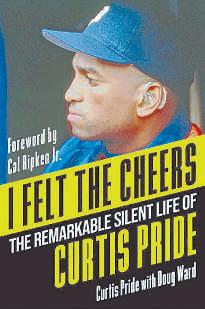
lic and hopefully inspire them. Take me back to that night in Montreal. That was before the internet, but now the video of it has taken on a life of its own. Do you still get people asking you about it? It was very emotional and very surreal. It’s something I will never, ever forget. I had a lot of people come up to me after the game. I would walk in downtown Montreal, and people would come up to me and say it was an experience they’ll never forget. To this day people still talk about how it made a huge impact on their lives.
As a hearing person, I was unaware that deaf people often deal with a misconception that they are not smart. You talk about dealing with that over your career Can you tell me more about that?
It’s a common misconception. William “Dummy” Hoy was the first deaf player in the major leagues, and he was called Dummy because people thought he was dumb just because he couldn’t hear I would have to constantly prove to people that just because I have a hearing loss doesn’t mean I’m not smart. I had a good GPA in high school and graduated from one of the top colleges in the country William & Mary You reference by name the people who were instrumental in your development, but the biggest I thought were your parents. How much impact did they have on your career?
My mom sacrificed her nursing career to raise me and make sure I had all the resources necessary to become a productive person in society
My dad has been a big advocate, always helping me make sure I knew what was going on. My dad wanted to sign me up for T-ball, but they wouldn’t let me play because I was deaf and Black.
My dad threatened to file a legal suit. My dad has been with me making sure I understand the rules of the game and there was no miscommunication between the coaches and me.
For years I considered you a baseball journeyman, someone who sought out teams to play for But now I think you were a journeyman because teams sought you out. How would you analyze your career?
It’s a tough business. To be able to come back from independent ball to the major leagues, that’s an incredible feat. When you go to the independent leagues, most people write you off, especially the age I was then.
I was looking ahead, doing my thing, staying positive and playing the game the right way at all times.
I’ve had coaches tell me, “Man, I love the way you play You play the game hard and the right way.” So I guess I set a good example
Email Adam Daigle at adaigle@ theadvocate.com.

Contributing
New book about John T. Scott details life of the daring artist
STAFF FILE PHOTO
New Orleans artist John T. Scott’s ‘Buddy Bolden’
TRAVEL
Hunt forthe rougarou,spotvenomoussnakesinTickfaw
BY CATHERINE S. COMEAUX
Contributing writer
Catherine S. Comeaux
and her family spent three summers exploring state, national and provincial parks —from Louisiana to Alaska, to Nova Scotia and all along the Mississippi River in between. This year, she turns her attention to our Louisiana state parksto discover the natural beauty of the South less than a day’sdrive from home.
Beware! Venomous snakes,alligators, threetoed amphiumasand rougarous inhabit the swamplands and riverbanks of Tickfaw State Park. Adventure needs alittle danger lurking on the edges, so don’tlet these minor threats stop you from exploring this 1,200-acrepark along theTickfaw River in Livingston Parish.
The Tickfaw River originates in Southwest Mississippi and flows 113 miles to Lake Maurepas, with severalcurvy miles passing through the state park.
The park’ssmall boat launch drops river-goers into Gum Bayou, which leads to the mainchannel. Paddlers can head up or downstream to enjoy the twists and turns that hold surprises around every bend, like old-growth cypresstrees and alligators sunning themselves on the sandbars. The paddle trail is an out-and-back trail. Heading upstream on the way out allows paddlers to experience more of the park and, if the current is swift, allows for anatural assist on the return to the boat launch.
Search forthe rougarou
The name Tickfaw comes from the Choctaw language, potentially derived from aphrase meaning “rest among the pines” or more likely,from aword meaning “place where wild animals shed their hair.”
The park has both relax-


ing pines andwild hairy animals. Rabbits and deer skitter along the piney forest trails, and evidence of therougarou has been reported. In fact, once amonth, the park hostsacompetitive search for this legendary half-human/half-wolfcreature known for its creepy howling andtransformative bite. Approximately 5miles of trails windthrough hardwoodforests and cypress-tupelo swampsthat were heavily pruned by HurricaneIda in 2021. This
TRAVEL TROUBLESHOOTER
By ChristopherElliott
loss of tree canopy has allowed for athicker growth of underbrush where native plant enthusiasts will be happy to see avariety of flora such as the purple, bellshaped flower of the swamp leatherflower (Clematis crispa), thetall stalksof rivercane (Arundinaria gigantea) and the wispy white flowers of the lizard’stail (Saururus cernuus). In May,the woods are covered in wild blackberries. Despitethe loss of trees due to hurricanes and earlier years of logging, thepark retains several

old-growth cypress trees, including one known as the Grandma Tree, estimated to be 400-800 years old.
Amultisensoryexperience
If explorations in the wilds of the park don’tturn up arougarou or provide thethrill of encountering alive snake among the blackberry vines, visitors can stop at the Nature Center for amulti-sensory experience with dangerous critters.
Large and small aquariumsprovide aclose-up look at avariety of snakes, turtles, fish, and even a thick,ferocious tiny-toed amphiuma.
Atouch table gives visitors hands-on opportunities, like being able to feel the inside of an alligator’s jaw,while the “Listen and Learn” kiosk helps visitors identifythe sounds made by less visible park animals like the upland chorus frog. Displays tell the story of the park’secosystems and the various peoples who have interacted with them over the years.
Camping andglamping
The park provides two separate campground loops with 30 RV sites on one and 20 tent sites on the other,including acentrally located comfort station. Occasional flooding renders several tent sites unreservable, and mostofthe sites are not well-shaded.
Aprimitive “group
camping” site knownas the Atakapa Scout Area is available fortent camping, though not readily found via the park’sonline reservation system.This partly shaded open camping area accommodates up to 40 people and features asand volleyball court, five covered picnic tables, an established fire ring surrounded by a semicircular bench and a nearby fishing pond.
The space is designated “primitive” since it’sa short hike to parking and restrooms, but it would be a funplace to camp forthose willing to rough it abit. Priority is given to scout and youth groups, but others interested in reserving the site should contact the park directly foravailability Tickfaw State Park is one of eight Louisiana state parks that at one time offered aglamping option featuring an elevated wall tent with abuilt-in restroom,purportedly managed by Tentrr,which filed for bankruptcy in early 2023. According to Park Manager Joel Davis, state parks have recently been given the go-ahead to remove the unusable eyesores that have been occupying prime campsites.
Davis is excited to see these dismantled so the park can regain use of these areas.
Visitors need to bring their own fancy accoutrements if they wantthe glamorous camping experience at Tickfaw State Park or,when making reservations, simply choose one of the 14 furnished, climatecontrolled cabins with screened porches or the “group camp” option, which is alarger cabin that sleeps up to 52 in dormitory-style accommodations. Whether staying foraday or afew nights, in atent or acabin, alone or with 51 of your close friends, Tickfaw State Park is agood place to explore the beauty of South Louisiana with ahint of danger lurking in the flora.
Know before yougo
n Canoes are available onsite for$25 per day 8a.m. to 2:30 p.m.and must be returned by 4p.m. n Kayaks are available on-site to rent from Merry Green Marvel. Call Steve at (608) 632-6325 fordetails.
n The small boat launch can handle flat-bottomed boats up to 14 feet with small outboard motors permitted. Amud motor like Gator Tail is recommended to navigate fluctuating water levels.
n Get your fishing license if you plan to fish. Atypical catch includes largemouth bass, bream,channel catfish
Airline’scompensationmissing forhorrendousflightdelay

Christopher Elliott

My wife and Iwere scheduled to flyfrom Heathrow to ChicagoO’Hare on American Airlines afew months ago.The flight was delayed by 14 hours While we waitedfor the flight,American Airlines provided ahotel room and meals, aswell as apamphlet explaining our right to collect $652 per person for the delay. When we returned home, we contacted American Airlines customer service,and it again confirmed we would receive compensation.After not hearing anything, we contacted the airline again, and arepresentativeclaimed to have issuedchecks
We never received them.The airlinehas stopped responding to ourinquiries. Can you help? —JosephMuskovich, Schaumburg,Illinois That’ssome delay you had. American Airlines did theright thing by providingyou with food andovernightaccommodations. But you should have also received your legal compensation American Airlines is obligated to pay you under EC Regulation 261/2004, aEuropean Union law that protectsair passengers’ rights. Under this regulation, passengers are entitled to compensation for delaysofthree hours or more, dependingonthe distance
of the flight. Your flight was from theU.K., wherethe rules are similar to those in therest of Europe. Fortunately,you received a promise in writing from American Airlines.(By theway,you did agreat job withkeeping apaper trail that shows you were owed themoney.) When you contacted American Airlines, an agent confirmed your request and said you would receive compensation.Then you followed up and theagent said thechecks were issued, but you never received them. The airline then stopped responding to your requests.
What’s going on? Unfortunately,the European consumer regulations have no provision for requiring atimely payout of compensation. So American Airlines could have theoretically waited as long as it wanted to before sending you thechecks. Iknow —that’sabig loophole, and it’sthe reason God madeconsumer advocates. How do you speed things up? Calling can be helpful, but sending abrief, polite email to one of theAmerican Airlines executive contacts might have done the trick.Ilist all of them on my con-
sumer advocacy site, Elliott.org. Icontacted American Airlines on your behalf.The airline investigated your case and found that it had madeamistake. The checks were issued, but they were never delivered. American Airlines canceled the old checks and reissued new ones. Youreceived the money afew weeks later
Christopher Elliott is the founder of Elliott Advocacy,anonprofit organization that helps consumers solve their problems. Email him at chris@elliott.org or get help by contacting him on his site.

















Love, guilt and the end of a long goodbye
BY BO BIENVENU
Contributing writer
Those of us who are or have been primary caregivers of loved ones with dementia are painfully aware of the term, “the long goodbye.” For years, we watch them slowly slip away while remaining physically present. Their memory loss causes them pain, frustration, agitation, fear, confusion and any number of other emotions associated with losing touch with everything and everyone they knew Watching that causes us to grieve in a way different from any grief I have ever experienced before. For me, there has been grief plus all the same emotions felt by my wife — pain, frustration, agitation, fear and confusion. I found that as my wife declined, my grief and pain intensified, but my frustration, agitation, fear and confusion declined. Hav-
ing accepted the inevitable, my focus became one of making sure I provided the maximum amount of comfort, compassion, understanding, calm and reassurance I could.
That made possible a very loving and caring relationship to the end and, along with the grace of God, resulted in her recognizing me about 95% of the time in her last three months. What a gift for both of us.
Although she was unresponsive, she took her last breath as my son and I each held one of her hands exactly what she would have wanted After years of pleading with me to take her home, she went home without me.
Then the grief changed.
Seven years of mentally preparing for that final moment left me totally unprepared for the overwhelming rush of grief and, to my surprise, guilt.
The grief is understandable. The guilt surprised me. I felt
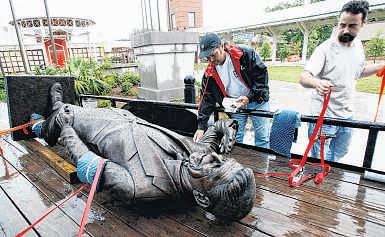
STATUE
Continued from page 1D
And in the decades after Reagan’s presidency, support for the GOP and Republican officials only grew, especially in Covington.
By 2003, then Covington state Rep. Michael Strain and St. Tammany Parish Council member Marty Dean had convinced the Louisiana Legislature to approve the naming of a stretch of U.S 190, from La. 25 through Covington to the parish line, as Ronald Reagan Highway That recognition stood out to Patrick Taylor when he was on the hunt for a place to memorialize his friend, Phyllis Taylor said.
“Patrick said, ‘Well, they’re going to do that, you already have some recognition for President Reagan, then why not have his monument there as well?’” she said But before he could formally choose Covington as the statue’s home, Patrick Taylor died from an illness in November 2004, halting the project for several years.
Phyllis Taylor who took over Taylor Oil and the family’s philanthropic foundation, was approached again years later by Covington officials who hoped to feature a bold tribute to Reagan at the city’s proposed trailhead She presented the plan to the Patrick F. Taylor Foundation board members, who agreed to
Danny Heitman, center, dances with his wife, Catherine, at Buck & Johnny’s, a Breaux Bridge venue that offers breakfast and zydeco music each Saturday.
PROVIDED PHOTO
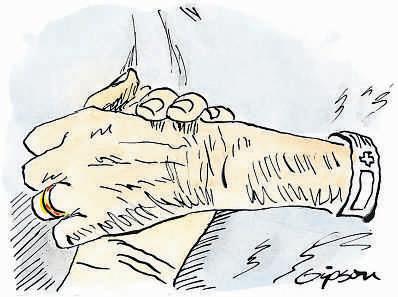
guilty for feeling relief that she was no longer suffering, even though, or more likely because, I knew that death was the only way to end her pain and suffering. I
BRIDGE
Continued from page 1D
“There were holes in the bridge when we were kids,” Bowman said. “And it was blocked off on either side.”
Today, the bridge has been restored and is open to foot traffic. Its story is told by historic markers placed along the highway by the Avoyelles Parish Police Jury, state of Louisiana and the Atchafalaya Basin Heritage Area.
But there was a time when the bridge stood alone, its story fading with the years.
The Big Bend
The community surrounding the Sarto Bridge is called Big Bend, named for a large curve in Bayou des Glaises.
felt guilty because I felt like I was wishing for her to die when all I really was wishing for was an end to her pain and suffering. When she was alive, even
though she was unresponsive, I felt like I could still do a little something to make her more comfortable and feel safer I could also continue to apologize for the times my behavior was not what it should have been.
After her last breath, I lost that ability and it really hit me hard. Every harsh word and behavioral misstep came back to haunt me. Even though they were unintentional and I had apologized many times and she had forgiven me and had forgotten, it haunted me then and it haunts me still.
The long goodbye is tough, but the last goodbye might be even tougher — Bienvenu lives in Prairieville.
Human Condition submissions of 600 words or fewer may be emailed to features@ theadvocate.com. Stories will be kept on file and publication is not guaranteed. There is no payment for Human Condition.
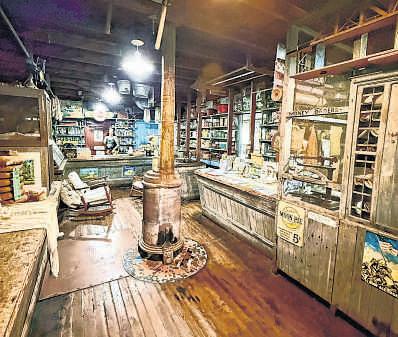
bankroll the statue’s creation.
A lasting tribute
The statue of the former president was sculpted by Bedico artist Patrick Miller and completed in March 2007 for $110,000. It was officially placed at the trailhead in June 2008.
These days, Reagan’s lookalike peers over a small amphitheater built at the trailhead, a conventional sight for most locals despite the city’s liminal connection to the past commander in chief.
Covington Mayor Mark Johnson said the statue still serves as a classic Americana symbol for the town’s residents.
“During Trailhead concerts, it always warms my heart when I see little boys climbing up the Reagan statue, then jumping off and tumbling on the ground,” he said in an email.
For Phyllis Taylor, the statue stands as a reminder of her husband’s desire to honor who he considered to be one of the American greats.
“One of the things that Patrick said in one of these many emails that I think is so fitting, and it also explains why he wanted to do this. He said, ‘Ronald Reagan’s unique ability to disagree without being disagreeable with Democrats, Republicans, critics and the media is sorely needed in our state at this time. We are all Americans, and he was the greatest of them all.’”
Email Julia Guilbeau at jguilbeau@theadvocate.com.
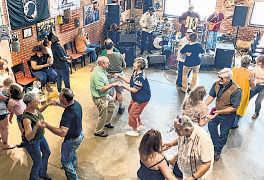
AT RANDOM
Continued from page 1D
waitress offers you an old-fashioned with your grits. As the designated driver, I opted for a tamer beverage, but the atmosphere was intoxicating enough. The featured band, Horace Trahan and the Ossun Express, drew a diverse crowd of young and old, everyone happy to share the floor I love the up-tempo spirit of zydeco, which always sounds like it’s poised to take flight.
We all waltzed in a lively circle, a carousel conjured from a few smiling souls who had decided to start their weekend with a spin around the room. My wife’s Apple watch had recorded 3,000 steps after a few minutes that had also included its share of two-steps and jitterbugs. We’d had a small workout and raised our spirits, too. I don’t usually dance at breakfast, but life would surely be better if I did.
Email Danny Heitman at danny@dannyheitman.com.
“Do you know why they call it Bayou des Glaises?” Bowman asked.
No.
“‘Glaises’ is French for glass, and when the water is still, it looks like glass,” she continued. “It reflects everything.”
That’s the story Bowman was told while growing up. Other accounts interpret the word’s meaning as clay, referencing the soil found along the bayou’s banks.
But Bowman’s translation is locally correct, because it’s the community’s, handed down from generation to generation.
The bayou once served as a boat route for transporting cargo to small communities. And the bridge? It served as the main connection from Sarto Lane on one side of the bayou to what is now La. 451 on the other
The bridge provided an easy route for farmers to nearby communities. It also served as an escape route.
Bowman grew up hearing stories about how area residents often had to evacuate when water overflowed from the river trinity of the Mississippi, Red and the Atchafalaya — and how the iron bridge was built high across Bayou des Glaises to circumvent floodwaters.
She remembers stories about the biggest levee break of them all — from back in 1927, when Bayou des Glaises bore the brunt of the trinity’s combined forces.
“From this point, you are standing 4 miles from the Atchafalaya River 5 miles from the Red River and 8 miles from the Mississippi River,” she said. “So, when it flooded in 1927, this location was in the wrong place at the right time.”
The water rose so quickly that it obliterated the community of Naples.
“Some workers from Italy settled there and named it for their home,” Bowman said. “It had a school and businesses, and it was just wiped completely out. It’s still underwater.”
Today, the stories of Naples and other lost communities are preserved just across the bridge.
Photos of the doomed community are displayed alongside those of other rural settlements in the Ponthieu Museum across from the bridge at 8554 La. 451, where Bowman readily shares their stories with visitors who find their way to this spot that is seemingly in the middle of nowhere.
The Police Jury finally closed the bridge in 1989, first blocking traffic with creosote poles, which were later replaced by iron barricades.
So, things were different in the days when Bowman and her cousin played on its rotted deck. Vegetation obscured the barricades, making the bridge the perfect place for unmonitored adventures — adventures neither girl
confessed to their moms.
The museum’s story
Bowman stands in the center of the bridge, gazing at the water She turns and walks to the museum, whose interior reflects its days as a general store. The former post office once occupied the screened room at the right of the entryway, where residents picked up their mail from the boxes lining the walls.
Meanwhile, shelves and counters alongside the museum’s main floor are filled with old tools, bolts of fabric and examples of goods once sold to rural residents. Most artifacts were donated by locals.
A side door leads to a gathering room, where visitors can watch a video about the history of Big Bend. This space also is where the museum hosts activities for local kids on weekends and during the summer including outings like cane pole fishing.
Bowman has a calendar of upcoming activities scheduled for locals to enjoy in the 98-year-old store named for its longtime owner and postmaster, Adam Ponthieu, who bought the business in 1946.
Ponthieu served as postmaster until 1994. He donated the store to the La Commission des Avoyelles in 1996, then headed by Carlos Mayeux. The agency later changed its name to the Avoyelles Parish Tourist Commission.
Ponthieu’s donation came after the Sarto Old Iron Bridge became the state’s first bridge to be placed on the National Register of Historic Places in 1989. Both the store and bridge were restored in 2011 through a collaboration between the commission and the Police Jury The jury later added a wooden observation deck on the levee for bridge and bayou viewing.
Finally the combination of the bridge and museum stands as the centerpiece of the Bayou de Glaises Cultural District, the only such district within the Louisiana Department of Culture, Recreation and Tourism encompassing a rural area instead of a municipality
“We started our own cultural district about 2018,” said Natalie Roblin, who co-founded the district with her mom, Aloysia Ducote. “It covers the area from the Atchafalaya bridge in Simmesport and goes through Hamburg, Moreauville and makes the Big Bend loop, which connects those communities.” Roblin and Ducote also formed a nonprofit attached to the cultural district for fundraising, grant applications and event planning.
“Over the last couple years, we’ve really become a close partner with this museum,” Roblin said. “It’s the
central tourism hub for this particular area. We’re doing our best to unite our resources to preserve the history of our community.”
The flood changed everything
Speaking of history, the store didn’t begin at its current location.
“You know, the museum isn’t the original store,” Bowman said. “The first store stood a couple of miles away It was destroyed by the flood. This store, where the museum is, was built in 1927 after the flood.”
The Great Flood left nothing but devastation in its path. Water rose quickly as people scrambled, with livestock and equipment in tow, to higher ground on the other side of the bridge.
Then came a second break.
“The levee broke on this side and flooded everything,” Bowman said. “When you look at how high the bridge was built over the bayou, you’ll get an idea of how high the water was. The water came up to the bottom of the bridge and stayed there.”
There was no Federal Emergency Management Agency and government assistance was minimal, if any
“People were told to go home and rebuild,” Bowman said. “So, that’s what they did.”
The store did its best to fill in the gaps for what the land couldn’t provide. Locals often paid for cornmeal, fabric and coffee with fresh eggs, produce, milk or other goods from their farms.
“I feel like we can tell the history of the flood the best because of its significance in this area,” Bowman said. “This is the area that was hit the hardest.” And with that in mind, Bowman is working with the cultural district to plan a 2027 centennial commemoration of the Great Flood.
“We wouldn’t call it a celebration,” she said.
Yet, in many ways, it is a celebration a celebration of the resilience of a rural community whose story is marked by a bridge that served its farmers saved the lives of many and was the setting for a few childhood adventures along the way
The Adam Ponthieu Grocery Store and Big Bend Post Office Museum, 8554 La. 451, Moreauville, is open from 7:30 a.m. to 3:30 p.m. Tuesday, Thursday and Friday, noon to 4:30 p.m. Sunday and by appointment on Monday and Saturday. The Sarto Old Iron Bridge is open during daylight hours seven days a week. Admission is free. For more information, call (318) 500-4036 or email bigbendmuseum1927@gmail.com.
Email Robin Miller at romiller@ theadvocate.com.
STAFF FILE PHOTO
Sculptor Patrick Miller, right, and Covington council President Trey Blackall untie a securely belted 1,300-pound Ronald Reagan sculpture after its transport from Ponchatoula in 2008.
STAFF PHOTO By ROBIN MILLER
The Adam Ponthieu Grocery Store and Big Bend Post Office Museum is set up to reflect its history as a general store for Avoyelles Parish’s Big Bend community
ARTS &CULTURE
Mississippiwatershed inspires surprising art
Colorunderwater, black-and-white images on land


To make the photographyexhibition “NicolasFloc’h: FleuvesOcéan, Mississippi Watershed,” Floc’h, aFrench photographer, drove 13,000 miles tracking the river system that touches more than 30 American states and two Canadian provinces. He made more than 2,500 photos depicting life on —and in —the Mississippi River andits tributaries.
About 500 black-and-white landscape images show natural riverside beauty as wellasplenty of industrial grunge, no surprise.
Another 2,000 color photos were made beneath the surfaceofthe water.Capturing thewater’sorange, green and blue interior life, the color images are acomplete surprise. The vivid gradations arecaused by varying densities of organicmatter —plants, little creatures, sediment —aswell as runoff of mineralsand other solids. Also afew fish.
In the exhibition, on view through Feb. 22, at the New Orleans Museum of Art, aselection of those images are presented side-by-side in atraditional gallery display in which Floc’h’s uniquely prismatic vision invites viewers to contemplate the effects of climate change,industrialization, and the flow of water past and through the inhabitants along ariver’sbanks.
Displayed apart from themain gallery images(in the only space in the museum large enough, aftermodification, to accommodate it), ahuge wall of 288 underwater color photographs makes avirtual mural out of the Mississippi’s final passage to the Gulf from Empire.
“It’sagood entryway intoa

lot of different questions,” said Brian Piper, NOMA’s Freeman Family Curator of Photographs, Prints and Drawings. “Especially for our audiences hereinNew Orleanswho live withthe river every day
“It’ssort of asurprise and aweinducing.You thinkofthe Mississippi as beingacertain color,but it’sactually got so many different levels that youcan read out of it.”
Theroute andmethod
Floc’hproduced the photos during a2022 residencyinthe United States sponsored by Villa Albertine (the French Institute for Culture and Education,a divisionof the U.S. French Embassy) in collaboration withthe Camargo Foundation andArtconnexion.
“He knewgenerally where he wasgoing to go based on afew things,” Piper said.“Part was to capture the wide scope of environments and the places that the Mississippiwatershed en-
compasses, andthatmeanscompletely rural places, wilderness a little bit. The rivermoves through suburban landscapes. There are places where theagriculture is completely industrialized,but there arealso urbanenvironments. He was really trying to get allofthatinto what we would call the edit.”
The photographer’sprocess for the underwater photos included an inflatable liferaft (heworked with an assistant) anda submersible camera fixedwitha wideangle lens. Camera depth was consistent at thedifferentlocations.
“It’ssimplerthanyou would think it would be,” Piper said. “Wetalkeda lotabout, ‘How are youcolor-balancing these things?’
And he said, ‘Because it’s natural light, you just balance it on that.’ They’re not souped-up in a computer. Ithink alot of people think they’re lookingatpaintings initially,orsomethingthat’sbeen digitally altered.Though he was
using digital equipment, they’re notcranked up in terms of saturation.”
Water findsits level
The gallery images are organized geographically north to south, from Minnesota’sLake Itasca to the Louisiana swamp. On the walls, the photos are not centered on an imaginary horizontal line, as is often the case in museums, but rather align along their bottom edges.
“Normally, throughout most of our galleries, we have acenter linethat the frames will be matched on,” Piper said. “But you’ll notice as you walk around, everything is justified on the bottom, which is part of his overall conceptual package, this idea that water will always find its level.”
Tall columns of similarly hued “Color of Water” photos break up thevisitors’ passage downriver Amap in the mainexhibit tracks themore than 220 locations
where Floc’h dipped or clicked his cameras.
“Inanumber of these (landscape) photographs, you can see weather patterns and water that’s being brought by atmospheric rivers into cloud formations,” Piper said.
“And then it’sgoing to pass through all of this land, and in some waycarry ahistory of the material from that, even all the way down (to NewOrleans). It’s part of Nicholas’ wayofshowing that connection. He would make the point that the water passes through us as well. We are part of the watershed even just walking around. There’ssomething very heavy about that, but also inspiring.”
Dave Walkerfocuses on behindthe-scenes coverage of the region’s many museumshere and at www.themuseumgoer com. Email Daveatdwalkertp@ gmail.com.
Musichistory is littered with lost albums
Anticipated projects neversee thelight of day
BY DAVID BAUDER Associated Press
NEW YORK
The idea that Bruce Springsteen wrote, recorded and ultimately shelved entire albumsof musicmay seem odd to the casual listener.Why put yourself through all that work for nothing?
Yet“lost albums” areembedded in music industry lore. Some were literally lost. Some remained unfinished or unreleased because of tragedy,shortsighted executives or creators who were perfectionist —orhad short attention spans. Often,the musiciseventually made public, like Springsteen is doing now, although out of context from the times in which it was originally made. So in honor of Springsteen’s83-song “Tracks II: The LostAlbums” boxset being released last week, The Associated Press has collected someexamples of albums that were meantto be but weren’t.
‘Smile,’ TheBeach Boys
Back in the news with the death of Brian Wilson, this album “invented the category of the lost masterpiece in popular music,” says Anthony DeCurtis, contributing editor at Rolling Stone. Some of the material that surfaced suggested Wilson, the Beach Boys’ chief writer,was well on his way: the majestic single “GoodVibrations,” the centerpiece “Heroes and Villains” and the reflective “Surf’s Up.”Wilson succumbed to internal competitive pressure worsened by mental illness and drug abuse while making it in 1966 and 1967, eventually aborting the project. He later finished it as asolo album backed by the Wondermints

an all-star squad of contributors including Eminem, 50 Cent, MaryJ.Blige, Busta Rhymes and Kendrick Lamar.“I’d describe it as the most advanced rap album musically and lyrically we’ll probably ever have achance to listento,” co-producer Scott StorchtoldMTV.But we never have. When he announced adifferent third album in 2015, Dre explained on his radio showwhathappened to “Detox”: “I didn’t like it. It wasn’tgood. I worked my assoff on it, and Idon’tthink Idid agood enough job.”
‘Black Gold,’ Jimi Hendrix
in 2004. The better-known songs were joined with some psychedelic-eracurios that displayed Wilson’smelodic senseand matchlessability as avocal arranger,along with lyrics that some fellow Beach Boysworried were too“out there.”
‘The Black Album,’Prince The mercurial Prince pulled back thisdisc,set for release in December1987, at the last minute. Some promo copies hadalready slipped out, and it was so widelybootleggedthat when Warner Bros. officially put it outin limitedrelease in 1994, the company billed it as “The Legendary Black Album.”Encased inanallblack sleeve, theproject was said to be Prince’snod to Black fans who mayhave felttheyhad lost him to apop audience. It’salmost nonstop funk, includingalascivious Cindy Crawford tribute and the workout “Superfunkycalifragisexy.” Themaestro’s instincts were well-placed, though. Comingafter “Sign O’ theTimes” —arguably his peak— this would have felt like aminor project.
‘Cigarettesand Valentines,’ GreenDay
Written and recorded in

Dr.Dre on what happened to ‘Detox’: ‘I didn’t likeit. It wasn’t good.’
2003, Green Day’s“Cigarettes andValentines” was actually lost; someoneapparently stole the master tapes. Feeling on acreative roll,the rock trio decided against recreating what they’d done and pressed on withnew material. Smart move. The result was “American Idiot,” the band’s best work. Perhaps the robbery was “just asign that we made acrappyrecord and we should makea betterone,” songwriterBillie Joe Armstrong told MTV Thetitle cutlater surfaced on a2010 livealbum.The rest was lost to time.
‘Detox,’ Dr.Dre
To say anticipation was high for Dr.Dre’sthirdalbum when he started recording in 2002 puts it mildly. The theme discabout ahitman, which Dre described as a“hip-hop musical,” had
Aseries of unfinished demos, “BlackGold” was ataste of whereguitar god Jimi Hendrixmight have gone creatively if he hadn’tdied at 27 in 1970. He was composing asong suiteabout an animated Black superhero, says TomMaxwell, whose podcast “Shelved”unearths stories behind lost music. Hendrix sent atape of his worktolongtimedrummer Mitch Mitchell for advice on fleshing it out.That music was set aside at Mitchell’s home and forgotten for two decades after Hendrix died To date, Hendrix’sestate has made only one of these recordings public,asongcalled “Suddenly November Morning.” Hendrix, after clearing his throat, slips in and out of falsetto while accompanying himself on an acousticguitar
‘A Story,’YokoOno
Writtenwhile Yoko Ono was separated from John Lennon during his infamous “lostweekend” in 1973-74, “A Story” had the potential of changing the musical narrative around her.Itwas a strongalbum —without the avant-garde stylings that madeOno achallenge for mainstream listeners —recorded with musicians who worked on Lennon’s“Walls &Bridges.” Maxwell calls it “an emancipation manifesto” that was set aside when
Ono reconciledwith Lennon. She’snever publicly explainedwhy,Maxwell says, althoughone song seems clearly about an affair she had while Lennon was away Someofthe material from “A Story”was included as part of the “Onobox” project that cameout in 1992, andthe album wasreleased separately in 1997. Ono also re-recorded some of its songs in 1980, andLennon was holding atapeofher composition “It Happened” when he was shot and killed. In it, she sings about an unspecified, seemingly traumatic event: “Ithappened at atime of my life whenI least expected.” That wasn’teven the most chilling premonition. Her song “O’Oh” ended with firecrackers that sound like gunshots. It wasleft off the 1997 release.
‘Chinese Democracy,’ Guns N’ Roses
Guns N’ Roses wasatthe topofthe hard rock world when they began recording anew album in 1994. It didn’tgowell. Inconclusive sessions slogged on for years, and all but singer AxlRoseleftthe group. Recording costs exceeded astaggering$13 million, by some accounts the most expensive rock album ever One witness told The New York Timesin2005: “What Axlwanted to do wasto makethe best record that had ever been made. It’san impossible task. Youcould go on indefinitely, which is what they’vedone.”When “Chinese Democracy” was finally released in 2008, the world yawned.
‘LoveMan,’ Marvin Gaye Not even adecadeafter the triumph of “What’sGoing On,” Marvin Gaye was floundering. His “Here, My Dear divorce album flopped, he struggled withdrugsand searched for relevance in the disco era. The single “Ego Tripping Out,” meant
to herald anew album,laid bare the problems: Over a melody cribbed fromDonna Summer’s“Hot Stuff,” the famously cool “Love Man” boasted like an insecure rapper. He scrappedthe album, repurposing some its material for the 1981 disc “In Our Lifetime,” aprocess so fraught he bitterlyleft his longtimelabel Motown. Gaye went to CBS, made a huge comeback with “Sexual Healing,” then was shot dead by his father in 1984.
‘Homegrown,’ Neil Young Neil Young rivals Prince in thevolumeofmaterial left in his vault, and he’s been systematically releasing much of it. The mostly acoustic “Homegrown” was recorded as 1974 bled into 1975, during Young’s breakup with actor Carrie Snodgress. Instead of releasingitin1975,heput out another heartbreak album, the well-regarded “Tonight’s theNight,”about losing friends to drug abuse. When Young finally dropped “Homegrown” in 2020, he wrote in his blog, “Sometimes life hurts. This is the one that got away.”
‘Streets of Philadelphia Sessions,’ Bruce Springsteen
Of the discs included in Springsteen’s “TracksII” set, this was reportedly the closest to being released, in the spring of 1995. After the success of the Oscarwinning song “Streets of Philadelphia,” Springsteen recorded an album in the same vein, with asynthesizerand West Coastrapinspired drum loops setting the musical motif. Strikingly contemporary for its time, Springsteenultimatelyfelt it was toosimilar to previous releases dominated by darkstories aboutrelationships.“Ialwaysput them away,” he said of his lost albums. “But Idon’t throw them away.”
Dave Walker
PROVIDED PHOTOCOURTESy OF NOMA
the Mississippi Watershed exhibit at NOMA
ASSOCIATED PRESS FILE PHOTOS
The BeachBoys, from left, Al Jardine, Carl Wilson, Brian Wilson and MikeLove, are inducted into the Rock ’n’ Roll HallofFamein1988.
DINING SCENE
Epic offshore fishingpartofa novice’s love language
The boat was slicing through choppy wavesmany miles out to sea when thecry went outand fingers pointed the captain toward a patch of blue water,boiling with grayfroth.



Ian McNulty WHAT’S COOKING
It was apogie ball, adense schoolofthe tiny fish. They had drawn the attention of tuna, which were now slashing thewater in amosh pit feeding frenzy.We rushed around each other on thedeck to get hooks in the water We werehours into this offshore fishing outing. All my hopes were pinned on catching tuna.Itwas not for the thrill of the chase alone; it also part of aromance of greatfood savored together
This was acharter fishing trip out of Venice earlier this year, part of an ongoing tradition pursued by agroup of friends who now periodically invite me along.
I’m no fisherman, and in fact, I’m allthumbs and tangled lines But thanks to the bonhomie embedded in these invitations, I’ve learned to appreciate apiece of Louisiana sportsman’sculture, one that resides offshore, largely out of view to all but its enthusiasts.
The first invite came twoyears ago, when this body of water was unquestionably called theGulf of Mexico. It was also when Ihad flabbergastingly found myself single, though with anew romance just opening.
We connectedfirst on food,including aspecific appreciation for fish in its finest condition, which is raw,whether sushi or sashimi, tartare or tiradito.
After that first fishing trip, my fridge, normally lightly stocked with condiments and wine, was packed with cuts of just-caught tunaand swordfish.
This was better than asheath of sonnets. Say it with flowers? No, Iwas saying it with crudo. Gifts of raw fish became part of our courtship andevolved into alove language. This has propelled every fishing outing since.
Making therun
The planning for these trips had become ritual long before Ijoined them.
Our group ships out with Paradise Outfitters, acharter company basedinVenice, run by Hunter Caballero, and equipped with40footopen-topped boats.
The adventure begins the day before. We leave New Orleans in the afternoon to stay overnight on ahouseboat by the marina, well-positioned for thedawn departure.
The 80-mile drive down La.23is part of the experience, as thecity recedesand the riverine realm takes over The road snakes along the Mississippi’scurves, and the levees lining each side draw closer as the land narrows. Over their edge, shipkeels aresometimes higher than passing cars. Dinner upon arrival will be poboys and fried snapper collars
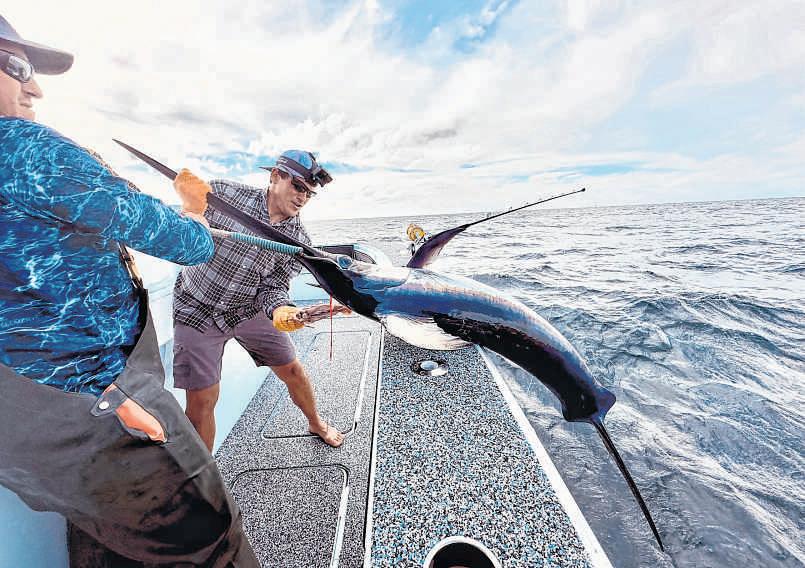
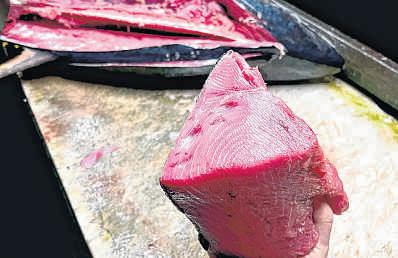
at asalty dockside tavern called Crawgators, crowded with those back from their own days on the water,all singed, exhausted and exultant.
In the morning,with dawn starting to paint the low horizon of surrounding marsh, the marina rumbles with areveille of many boat engines starting.
We step onto oursand motor toward theMississippi, passing cargoshipsand oil rig supply boats
Our captain picks achannel by theriver’sbird foot delta. The last trickles of what passes for land whittle down to reeds and jetty stone. The water changes from river brown to Gulf blue as distinctly as acurtain lifting. Now it’sgame on.
Theblocky shapes of oil rigs form on thehorizon like distant
castles, and “the run” begins. This phase of the trip constitutes most of it, variably zooming or pounding through waves en route to likely fishing grounds.
Through pesky banter around thehelm, I’ve learned that what appears to be trackless water hides aseabed terrain of wrecks and lumps, pipelines and other sweet spotsthat can draw fish.
The captain proceeds on informed hunches, recon from other boats or thehunting patterns of pelicans, diving on those pogie balls, guiding us in.
Reelingbyrigs
Andthen there are therigs themselves, which act like reefs where their legs extended through deep water.These structures draw afood chain of small fish, bigger fish, sport fish and us.
The juxtaposition of industry, nature andsport is extreme. Here is avast blue sea with land nowhere in sight, and massive engineered structures rising from thechurning expanses like space stations—boxy,clanging and humming with machinery, flaming flares andthe occasional helicopter landing like abee on a bloom
We bob andpitch beneath the rigs in our suddenly-very-small boat as Allman Brothers tunes jangle from the speakers. Supplies forthe day,deeply ritualized, will always include Pringles and thevery fine beef jerky from Bourgeois Meat Market in Thibodaux. Icechest beverages have been stocked with the care in provisioning of atransoceanic journey,because we must not run dry Around midday,Ibreak out my own new riffonthe tradition. Ibring specialty sandwiches. Tightly wrapped Central Grocery muffulettas and banh mi from the Vietnamese restaurant Pho Tau Bay survive the journey well, and they bring abit of NewOrleans out to the Gulf Itake enough to share with the captain and deckhand. Notexactly abribe, this is still acalculated move. Ineedtheir goodwill, or at least pity.I need their help to get afish on my hook, and Idesperately need fish to bring hometo fulfill my hunter-gatherer promise.
Catching on My friends have been fishing like this for years, somesince their youth. They have skills.
They even have those fishing shirts with all the vents and snaps. By comparison, my fish game is small. Still, Ihave followed instructions, learned abetter reeling technique, and not given up on afish even when Ithought my forearm would snap in half After alaconic linger without fish, one on the line gets the adrenaline pumping. The big fish fight until the end, and it can feel like trying to reel in abank safe. The soundtrack is achorus of encouragement and brotherly cajoling. Don’t give up. Don’t drop the reel. Don’tlet ashark bite it in half first. Get the fish in the boat. Finally,itgets close enough to discern. Doesithave the blade of acoveted swordfish (giving lean, velvety-textured flesh), or is it the quicksilver flash of ayellowfin tuna (so buttery rich and gleaming when sliced)?
Even before it’sover the gunwale, I’malready calculating crudo. Ifixmyeyes on the line. I keep reeling. Between the roaring engines, rolling waves, blue distances, hooks and knives and fish blood, Louisiana offshore fishing does ignite something in the id. Somedoitfor trophies, maybe to mount in their den. Someseek asize record, which gives bragging rights forever at the marina. Me? There’saday on the water, timewith friends outside of cellphone range, and fish that Iwill slice raw at homewith someone wholoves it as much as me.
Email Ian McNultyat imcnulty@theadvocate.com.






































































































































STAFFPHOTO By CHRIS GRANGER
Hunter Caballero, left, and Drew Bateman of Paradise Outfitters bringa swordfish aboard theircharter fishing boat in the Gulf.
STAFF PHOTO By IANMCNULTy
Athickcut of yellowfintuna is taken from just-caught fish back at the marina in Venice.



LOTSLINE ON THE

Three years after rising interest ratesand insurance premiumsiced the white-hot housing marketofthe pandemicera, real estate brokers across Louisiana —and much of the U.S. —are struggling to move agrowinginventoryofhouses that have been sittingfor months.
Doris Schutte, of Reve Realty,waters orchids as she prepares ahomefor showing in Metairie. Agents advise against shelling out big bucks for akitchen renovation or high-end amenity likeapool before listing ahouse, especially in the current climate. Simple upgrades and repairs, on theotherhand, go alongway

BY STEPHANIE RIEGEL Staff writer
VeteranRealtor Jerry Del Rio has been selling houses in Baton Rouge for more thanfourdecades. Over the years, she’sadvertisedon TV,partnered with nationalbrokeragesand earned top-performing agent awards.
This year is thetoughestshe’s ever had.
“I am doing as much marketing as Ipossibly can,” she said. “I’ve never worked harder.” Del Rio is not alone. Three years
after rising interestrates andinsurance premiumsiced the whitehothousing market of thepandemic era, real estate brokers across Louisiana —and much of theU.S —are struggling to move agrowing inventory of houses that have been sitting formonths. While there are pockets of strength, in south Louisiana, houses are spending more time on the market, fewer homes are selling, and pricesare falling or barely keeping up with inflation.During
ä See HOUSING, page 4E
CSRS chiefsaysnationalacquisition
TimBarfieldstaying on as presidentat engineering firm
BY STEPHANIE RIEGEL and TIMOTHY BOONE Staff writers
CSRS President TimBarfield
said he wasn’tplanningto sell the Baton Rouge-based design, engineering and program management firm he has run since 2016, when aDallas-area company came calling in 2022. But after initially declining theofferfrom WestwoodProfessional Services then exploring thepossibility and, even, working together on aproject, Barfield and the 10 other owners of CSRS decided earlier this
yearthatselling their31-year-old
firmtoWestwood would be best for their clients, employees and future growth.
The deal was finalized last week. Financial terms were not disclosed.
“I did not do this lightly,” said Barfield. “But this has alot of upside. Westwood is agrowing, national company and they are very interestedingrowing their presence in Louisiana.”
The sale will not mean the end of CSRSinBaton Rouge, where Barfield said he willremainas local presidentfor fiveyears and headupa division focused on program management and disaster recovery —two areas where Westwood does nothavea presence and CSRS has been strong. Butthe deal will mean other changes for the $40 million firm
and its roughly 175 employees. Some jobswill be lost or relocated to other offices. The CSRS name will change early next year.And othershiftsinroles andresponsibilities arestill being worked out. “The devil is in thedetails, and we’ll be going through all of that in thenext sixmonths,” Barfield said. “But they have been clear they areimpressed by ourfirm and want to take thebest of the best.” The sale of CSRSwillalso mean theend of local ownership in asouthLouisiana economy that has seen aconsistent departure of locally owned companies in recent decades. In June alone, two longtime New Orleans businesses, Canal
ä See CSRS, page 2E
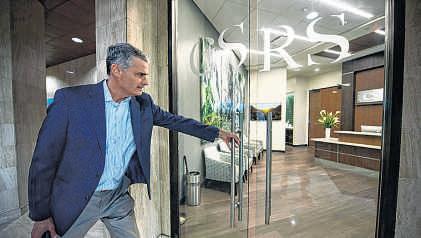
the leadershipofCSRS
nearly 10%. In recent
Barfield refocused someofCSRS’ efforts on its civilengineering business.
STAFFPHOTOSBySOPHIAGERMER
Oil Center building sells for $2.45million
An office building in the Oil Center has sold for $2.45 million. The 38,000-square-foot Travis Technology Center,110 Travis St was sold to alimitedliability company registered to John Douglas Hundley,records show
The seller was Robertson Real Estate Group of Lafayette, which bought it in 2019 for $3.3 million from an LLC registeredtolocal businesswoman Ruth Ann Menutis. Built in 1972, the two-story building has several office suites and some adjoining offices, according
Fool’sTake: Strong potential, with risks
Shares of all-digital bank
to the listing. It also has alarge mediaroom, downstairsand upstairs conference rooms and more than 100 parking spaces.
Average age of first-time homebuyer almost40
The average personiswaiting until they are almost 40 years old before making theirfirst home purchase, oneanalyst said. Longtime Lafayette real estate analyst BillBacque told Jan Swift on theDiscover Lafayette podcast that across thecountry the average first-timehomebuyer is 38 to 39 years old. The rising cost of
owning ahome coupled with the risingcost of insuranceare factors, he said.
“When Ibought my first house in 1973, Iwas 22 yearsold,” he said. “I can’tremember what thefirst housecost, but it was less than $10,000. It was alittle bitty house. It wasabout thesizeofanapartment.”
The average sale price of ahome in Lafayette Parish has risen significantlyinrecent years but has lost somesteam.Between 2018 to 2022, theaverageprice of ahome rose from $223,500 to $285,000, he said. Yetfrom 2022 to 2025, the av-
erage price has nudged upward 2.6%, reaching $292,200. In 2018,Bacque noted, homes priced below$150,000 made up 24% of sales but now make up 12.3%, he said. Homesover $300,000 havegrownfrom 16% of sales to 31%.
Kingresigns as director of Leadership Lafayette Katrena King will resign as executive director of the Leadership Institute of Acadiana this month, theagency announced.
King was hired in late 2021.
King said she will remain in La-
BUILDINGPERMITS
fayette but has accepted aposition that will allow her to work more nationally and internationally.She is agraduate of Leadership Lafayette Class XXXIV,the University of New Orleans and Southern University Law Center
“I am grateful to leave behind a legacy that lends itself to evolving as Lafayette continuestogrow,” King said. “The community connectionsand relationshipsthatI’ve seen built through LIAmake all of the difference, and I’msoproud to have been apart of that.”
Theagency’sboard will begin asearch forKing’s replacement, Chair Brandon Smith said.


Motley Fool
SoFi Technologies (Nasdaq: SOFI) have more than doubled over the past year.It’s attracting new members with its easy-to-use app and original marketing, which is reaching its target market of students and young professionals. With its strategy of crossselling and upselling, it gets customers to engage at ahigh rate and buy more products as they use the platform.
SoFi’sadjusted net revenue increased 33% year over year in the first quarter of 2025, its fastest growth in the past five quarters. And it added a record 800,000 new customers, a34% year-over-year increase, for atotal of 10.9 million.
SoFi started out as alender and has expanded into afull financial-services platform. It’s alow-cost, fee-based business, which helps its bottom line. But SoFi is young and largely unproven, and it’sstill mainly alending business, though it’s doing agreat job of diversifying; that leaves it vulnerable to changesininterestrates.
The stock isn’tcheap, either with arecent forward-looking price-to-earnings ratio of 57. But given its growth rate, that’snot wildly expensive. SoFi is just getting started, and it’shard to overestimate its long-term opportunities It envisions becoming aTop 10 bank,and if it can continue to generate new business and capture market share, that’sa distinct reality down the line. If you’re arisk-tolerant longterm investor,take acloser look at SoFi.
Fool’sSchool: Getting out of debt
One of the most powerful things you can do to improve your financial health is to get out of high-interest-rate debt —such as that from credit cards. (A mortgage loan with arelatively low interest rateis far less troublesome.)
The average credit card interest rate was recently 24.33%, per LendingTree.com. If you owe, say,$25,000 on your cards and you’re being charged 24% annually,you’re looking at owing another $6,000 per year for interest alone. That piles on to your existing debt, which can cost you more and more in interest and eventually spiral into afinancial catastrophe.
So how can you get out of debt? Here are some strategies:
n Begin by not adding more to your debt. Tryleaving your credit cards in adesk drawer —ortaping reminders on them to keep your spending in check. Youcan opt out of getting credit card offers in the mail by calling (888) 567-8688 or by visiting optoutprescreen. com.
n Call your credit card issuer(s) and try to negotiate alower interest rate. You might point out that you’ve been aloyal customer and that you could take your business elsewhere, perhaps to a balance-transfer card. Many people have gotten their rates lowered significantly just by asking.
n Consider moving your debt to areputable balance-transfer credit card. These typically charge you zero percent for an initial period, which might be ayear or even longer.(Youcan find some at fool.com/money.)
Once you do transfer the debt, work hard to pay it down before the interest rate reverts to normal.
n Spend lessinorder to free up funds to pay downdebt. Perhaps eat out at restaurants less often, cancel subscriptions you don’tuse much (like agym or certainstreaming services), and put offbig purchases. You might also earnmorebytaking on aside gig for awhile
n Pay off debts with the highest interest rates first to save yourselfthe most in interest.
Ask the Fool:Signs of promising stocks
What are the traits of the mostpromising stocks,and can they be found in a rising market? —M.E., Kittery, Maine
Traits to favorinclude a healthy balancesheet (less debt, morecash),profitability, growing revenue and earnings, alarge target market to tap, acompellingbusiness model and areasonableorlow valuation.
Read up oneach company to understand its growth prospects, competitive advantages, risksand challenges. Study its annual andquarterly reports, and look up news stories about it and its industry
The most promising stocks are oftenmoreattractively pricedinfallingmarkets, but they can still be good investments in rising ones. Still, pay closer attentiontothe company,its quality and its price than to the current trend in the market
How do I figure out the cost basis for astock I’m selling,for tax purposes?
K.S Caldwell, Idaho
Brokerages these days are generally required to collect andretaintax basis information on mosttransactions, so check your account for that info.
Here’show to do the math, if you need to: Imagine that you bought 100 shares of Buzzy’s BroccoliBeer(ticker: BRRRP) for $40each,and you paid a $10 trading commission. Your cost basisisthe purchase price ($4,000) plus the commission, or $4,010. Divide $4,010 by 100, andyou’ll geta costbasis per shareof$40.10. If you eventually sell the shares for$60 each, or $6,000 —again paying a$10 commission —subtract the commission to get net proceeds of $5,990, or $59.90 pershare
Your taxable capitalgainis the difference: $5,990minus $4,010, or $1,980 —$19.80 per share. Many brokerages now charge$0for trades, making the math easier
My Smartest Investment: Aprofitabledivorce
My smartest investment wasmy house. Over 40 years ago, Iwas newly divorced and raising two sons. My boss saidshe would move me to full-timeand double my salaryonly if Ipromised to buy my ex-husband out on the property we’dpurchased in 1971 for $24,000. Icalled him and he said,“Oh, you can have that old place!”Tenminutes later, he called me back and said,“Just give me $30,000 for the houseand property.” Iran to the bank and gota loan for $50,000 and gave him $30,000. With the other $20,000, Ibought new windows,doors and aroof. Lastmonth, areal estate agent offered me $1.2 million for theproperty Ideclined, as I’m now 83 and my older sonwants the place —it’snow 100 years old, built in 1925! Isaw my old bossrecently and told her Iwould not own ahouse if it had not been for her wise advice. —S.C., via email Congratulations!Real estate isn’talways agreat long-term investment, but it can be. And it’sgood to own the roof over your head. Divorce is not uncommon,somarried folks might want to think about how they’d get by on theirown,just in case
Do you haveasmartor regrettableinvestmentmove to sharewithus? Email it to tmfshare@fool.com.
Issued June 25 to July 1
Commercial alterations
RETAIL: 3142 Ambassador Caffery Parkway,description, install interior and exterior doorsand other work at WalmartSupercenter;applicant, CESO Inc.; contractor, Stuart&Company General Contractors; $120,000.
MEDICAL: 1211 CoolidgeSt.,description, renovation of fourth floor; applicant, MBSB Group; contractor The Lemoine Co.; $517,800.
MEDICAL: 4906 Ambassador Caffery Parkway,Suite G; description,addition and renovation to Lafayette Family EyeCareoffice; applicant, none listed; contractor, The Gen GroupConstruction; $155,000.
MEDICAL: 200 Corporate Blvd., description, renovation and buildout of first-floor office for SCP Health; applicant, none listed; contractor, C.M. Miciotto &Son;$1.8million.
Newcommercial
OFFICE: 117 DuhonRoad, Suite100 and 200; description, office for Scotty DoucetState Farm; applicant, Trahan Architecture+Planning; contractor, The Gen GroupConstruction; $1 million
Commercial demolition SCHOOL: 3000 W. Congress St de-
scription, none listed for Lafayette High School site; applicant and contractor, LloydD.Nabors Demolition; no value listed.
Newresidential
108 SOUNDVIEWWAY,YOUNGSVILLE: RLS Properties, $600,000.
110 SALT MEADOW LANE: PrestigiousHome Builders, $400,000.
407 LAST QUARTER DRIVE,YOUNGSVILLE: Francez Builders, $350,000.
101 STOVER ST YOUNGSVILLE: DSLD,$94,080. 135 RIDLEY LANE, YOUNGSVILLE: DSLD,$99,360.
201 EPINAL DRIVE: AM Design, no value listed.
224 TI’FRERE ROAD,CARENCRO: Heath Homes,novalue listed.
350 E. FARREL ROA: lots16-20, Annie Maria LLC, no value listed.
106 POPS PORCHLANE: Andries Builders, no value listed.
115 GIDEON ROAD,YOUNGSVILLE: Hammerhead Homes, no value listed
101 PEACOCKAVE.: BECC Enterprises, no value listed.
100 PARKSTEAD LANE: DSLD,no value listed. 102 PARKSTEAD LANE: DSLD,no value listed.
PARKSTEAD LANE: DSLD,no
LANE: DSLD,no
202 PARKSTEAD LANE: DSLD,no value listed.
203 PARKSTEAD LANE: DSLD,no value listed.
204 PARKSTEAD LANE: DSLD,no value listed.
205 PARKSTEAD LANE: DSLD,no value listed.
206 PARKSTEAD LANE:
Barge Co.and Gallo Mechanical, both announced sales to out-ofstate companies. Baton Rouge’s publicly traded equipment rental
firmH&E also sold last month in a $5.3 billion deal.
Barfieldsaid such market exits should be seen in apositive light andare part of thenatural evolution of the business cycle.
“This is whyit’simportant to have an entrepreneurial environment,” he said. “Businessesgrow and merge, and there needs to be other things thatcome in and grow and do new things.”
Attractive target
CSRS wasfounded in 1994, when civil engineering firm Rodi&Songi merged with architectsChenevert Soderberg to formafirm that could offermore holistic and diverseservices. Over theyears, it expanded into programmanagement,where it snagged major contracts overseeing work for the Recovery School District andOrleans Parish School System in New Orleanspost-HurricaneKatrina andthe GreenLight Program in Baton Rouge, among others.
Barfield, an attorney by training, joined the firm in 2016 after spending theearly yearsofhis career as president and chief operating officer of The Shaw Group under Jim Bernhardand, later,asa top executive in Gov.Bobby Jindal’s administration.
Under Barfield’sleadership, CSRS continued to expand, averaging annual revenue and employee growth of nearly 10%.In recent years,herefocused some of CSRS’ efforts on its civil engineering business.
He alsohelped landmore highprofile contracts for the firm, including project adviser for the redevelopment of theUniversity Lakes in Baton Rouge, civil engineering work for the Amazon fulfillmentcenter andhelping the Port of LakeCharleswith Hurricane Laura disaster recovery grants.
The breadth and depth of CSRS’ expertise madeitattractive to Westwood, thecompany’s CEO Bryan Powell said in astatement.
“Weare excited aboutthe positive impacts this acquisition will bring to ourpeople and clients,” Powell said in thestatement.
Privateequityowners
Westwood does many of the same thingsasCSRS but is much larger, with some 1,600 employees and officesin13states. Thecompany was foundedinMinnesota more than 50 years ago and specializes in anumber of sectors, including renewable energy,power delivery electric vehicle infrastructure,
commercial, residentialand public infrastructure projects. Westwood hasoffices fromCalifornia to Virginia,witha strong presence in markets such as the Midwest and Texas. But the company didn’thave apresence in Louisiana.
In 2024, Blackstone, the massive private equityfirm bought a majority stake in Westwood. The platform and financial resources that BlackstoneprovidestoWestwood and, now,CSRS will benefit local customers, Barfield said.
“The resources andopportunitiesare more than asum of the parts,”hesaid. About six weeks ago, Barfield
brought in thetop 30 people in CSRS leadership team to tell them there was astrong possibility of an acquisition. The senior managers took the newswell. Aweek before the deal was announced, CSRS employeeswerenotifiedand clients started getting contacted about the impending move. The plan is forCSRS to continue operatingasithas been through the end of the year “Our goal is for clients and employees to see things are largely the same as they have been,” Barfield said.
Email TimothyBoone at tboone@theadvocate.com.































TALKING BUSINESS
ASK THE EXPERTS
South La. company finds success building metal studs
BY ADAM DAIGLE Acadiana business editor
Q&A WITH MATEO ATWI
After he left Georgia Tech in 2019 with a degree in mechanical engineering, Mateo Atwi returned to New Iberia and started a business with his brother Tiago creating buildings out of shipping containers. They built some modules for a medical clinic in Church Point during the height of the COVID-19 pandemic. But getting the steel studs necessary for the project took 16 weeks.
That’s when they shifted.
The brothers, sons of a New Iberia physician, pivoted to manufacturing steel studs and found success. Now spread over four warehouses at the Port of Iberia, the business US Frame Factory, which they named to have a more global presence — will eventually be housed next spring in one 40,000-square-foot building currently under construction in Broussard.
“We had no experience with metal stud manufacturing prior to starting this business,” said Atwi, 26.
“We’re very much millennial, Zoomer types. We’re a very young business, and we thought to ourselves, ‘We can’t find prices for this stuff online.’ And if we wanted to buy it, we had to call somebody, email and go back and forth.”
The company, which makes studs out of large coils of steel and employs 32, has doubled its revenue nearly every year and hopes to get up to 80 employees once the new building is fully operational. In the meantime, the work will continue. Thanks to a significant web presence, the company has supplied projects in 25 states and has sent studs to build a four-story hotel in Hawaii, a nursing school

in the U.S Virgin Islands and a hospital in Guyana, Atwi said.
In this week’s edition of Talking Business, Atwi talks about the company’s growth leading up to the new location, how the business found its footing and his background.
This interview has been edited for clarity
How is the larger facility in Broussard going to help your business as it continues to grow?
Instead of charging headlong into unknown investments, we’ve always said, let’s take it one piece at a time. That’s why we leased more warehouses to increase our capacity, but we realize this is our next leap. With more room, we’ll be able to take on these bigger
projects. We could, in essence, build an entire hotel in pieces in that building and have it shipped out to the site and shave off 70% of the build time.
Tell me about your business concept. Where do you get your coils from?
We have vendors all across the U.S. Some in Indiana, Cleveland, some in Arkansas We’re blessed to have a pretty diverse supply chain. It’s such a developed industry the coil industry because they use it in automotives, appliances, HVAC and various industrial applications. The majority of lumber goes into construction. We can buy coils that may have been intended initially for automotive or some other industries and use them in this industry
How many companies are in this lane?
Do you have a lot of competition in what you’re doing?
This industry, compared to wood, is relatively new People have only started to build this way in the last four years, which is new for construction. When it first rose in popularity, it was through manufacturers selling through distribution channels. Now we are one of the few U.S. companies that sells direct like this. It’s a different distribution model, and it’s enabled because of the internet. It’s very easy for us to find the customers. You mentioned customer service is a big part of your business strategy Could you give me an example? We’ll help clients understand
how to reduce the weight of what they’re building and how to ultimately reduce their costs. That’s where we’ve seen enormous value. We’ve done a large multifamily project in Metairie, about 1.5 million pounds of steel, and we’re able to help those customers reduce their costs by 15%, which is significant We want to be a supply chain partner for them and not just a supplier
Let’s start back from the beginning Your parents are physicians. How did you get into the construction business?
I wanted to either build rocket ships or go into construction because I thought that it was an industry that needed innovation. I intentionally went into the modular prefab industry because, if you look at it, productivity has declined in the last 30 years. I worked for this other company that was pretty innovative doing shipping container buildings, but I didn’t feel like the shipping containers were going to unlock more affordable, durable housing. So we ultimately left them to come start a business at home with our family
What made you want to return to Iberia Parish to start this business?
This is an area with basically every kind of natural disaster you could face — termites, hurricanes, flooding. I think there’s a desperate need for resilient, affordable housing here. How much damage is there every time a hurricane comes through? It’s millions or billions of dollars, and it’s primarily construction-related. This is my problem with a lot of modular companies. Sure, you can make a good solution that’s expensive, but can you make a good solution that’s affordable? And I’ll be the first to admit we’re not there yet, but that is forefront of our mind: How can we actually make this affordable and durable?
Email Adam Daigle at adaigle@ theadvocate.com.



STAFF PHOTO By BRAD KEMP
Mateo Atwi, CEO and co-founder of US Frame Factory, stands next to
coil of steel used for manufacturing in
Iberia warehouse.
HOUSING
the
first five months of this year, houses in metro New Orleans spent more than twice as long on the market as they did during the same period in 2022, and a third fewer houses sold, according to data from the New Orleans Metropolitan Association of Realtors
Data from Baton Rouge and Lafayette tells a similar story
So how to deal with the slump?
Del Rio and other experienced brokers are advising sellers to do simple things to enhance their property’s curb appeal and make it stand out from the crowd
They’re also working with lenders and buyers to come up with creative ways of closing a deal, whether that means splitting the cost of a new fortified roof or helping first-time homebuyers through an owner-financing arrangement.
Above all, they’re advising sellers to be realistic about how they price their homes.
“The most important thing is precision pricing, even if that means selling at break-even or a loss,” said David Favet managing broker at Reve Realtors. “It doesn’t matter what you paid three years ago. It’s about pricing based on what things are selling for today.”
‘Prepare to take a loss’
That’s not the kind of advice real estate agents typically give.
Most Americans, nearly 70% by some estimates, have all of their wealth tied up in their homes. In recent years, growth in annual home prices fueled expectations among homeowners that they’d make a handsome return on their single greatest asset when it was time to sell.
Those days are gone for the time being, local brokers say.
“It is really hard,” said New Orleans broker Jiarra Rayford, of Rayford Realty. “But some clients need to prepare to take a loss.”
In 2024, prices were down in twothirds of the ZIP codes in metro New Orleans over the year before, continuing a slide that began in the second half of 2022 and picked up steam in 2023. In Baton Rouge and Lafayette last year prices were down in about half the ZIP codes.
During the first five months of this year, they’ve been more or

By
Doris Schutte, of Reve Realty, prepares a home for showing in Metairie. Local brokers say home sellers should ‘prepare to take a loss’ in the current market In 2024, prices were down in two-thirds of the ZIP codes in metro New Orleans over the year before, continuing a slide that began in the second half of 2022 and picked up steam in 2023. In Baton Rouge and Lafayette last year, prices were down in about half the ZIP codes
less flat.
“I spend a lot of time on the phone trying to make my sellers understand what kind of market we’re in,” said Brandi McKnight, an agent with ReMax Acadiana in Lafayette. “I know they’re very, very frustrated.”
Favret said modest price adjustments, coupled with inexpensive cosmetic touches can make a big difference. He recently advised a client in Chalmette to list their ranch-style starter home for $325,000, slightly less than they were seeking.
“They slightly underpriced the market and spent $1,000 on landscaping to make it look a little more charming,” he said. “It really helped They’re seeing a lot of action on it.”
Creative dealmaking
Some brokers are encouraging sellers to come up with new ways
of making deals work.
David Landry, who owns and operates David Landry Real Estate in Baton Rouge, said one thing he has seen homeowners do to help sell a house is offer owner financing. Under such an arrangement, the buyer makes a series of payments to the homeowner, who holds onto the deed until a pre-agreed sum is paid.
Such deals work well when the buyer has the wherewithal to make a large down payment, Landry said. He also encourages sellers to make sure that their house qualifies for Federal Housing Administration, rural development or U.S. Department of Veterans Affairs loans.
“If people can’t get governmentbacked loans, the only buyers will be investors making low-ball cash offers,” he said. Brokers are also telling sellers to work with buyers on the cost of
needed repairs or something more
significant, like a new roof.
“If a buyer wants a new roof, I encourage the seller to negotiate that into the deal,” said Scott Brannon, a broker with Compass Real Estate.
That said, he doesn’t advise sellers to put a new roof on their home, even a fortified roof that meets new, insurance-industry standards designed to lower premiums, in hopes of increasing its value on the market.
“It might make it more marketable initially,” he said. “But you’re not going to get the money back in the sale price.”
Simple things
Agents also advise against shelling out big bucks for a kitchen renovation or high-end amenity like a pool before listing a house, especially in the current climate.
“Never a pool or an outdoor
kitchen,” Favret said. “Those are terrible returns on your investment. You’ll never get it back.”
Simple upgrades and repairs, on the other hand, go a long way Agents said it’s important to make sure a house is pressure-washed, landscaped and doesn’t have any obvious deferred maintenance or needed repairs.
A fresh coat of paint to brighten a room and a new fixture or two can get buyers in the door
“Fix the dirty grout lines in the bath. Paint old cabinets and drop a new Home Depot vanity on top,” Brannon said. “You can do simple, inexpensive things to make things look newer, more polished.”
Timothy Boone and Adam Daigle contributed to the reporting of this story
Email Stephanie Riegel at stephanie.riegel@theadvocate. com.
Meet the Father-Son DuoKeeping Louisiana’sFishing HeritageAfloat
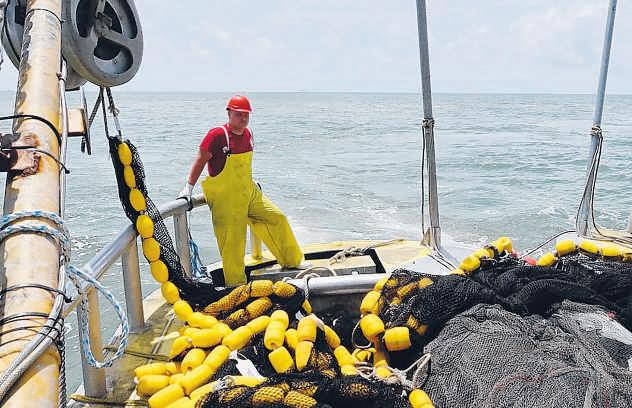
Thisarticle is brought to youbythe Louisiana CommercialFishing Coalition LLC
FormanyinLouisiana’s menhaden industry,fishing is afamily tradition passed down from generation to generation. To seethis tradition carried on today, look no further than the Damerons: fourthgeneration Ocean HarvestersCaptain Michael Dameron and his sonAndrew ForMichael, being the captain of the Ocean HarvestersFishing Vessel Oyster Bayou is the fulfillmentofa childhood dream.
“All Ieverwantedtobewas afish boat captain,”Michael says.“I graduatedhigh school on aSaturdaynight, steppedaboard aboatSundaymorning, and I’ve never looked back. Growing up in the menhadenfishing hub of Reedville, Virginia,“Everyone looked up to the fishermen,”Michaelrecalls.“My grandfather and my father were my heroes.” After starting out as acrewmember in Virginia,hemovedtoAbbeville, Louisiana in 1997 when amate’s jobwith his father came available. Therehemet his wife,
started afamily,and rose to captain the Oyster Bayou
Nowhis sonAndrew is carrying on the family legacyasafifth-generation fisherman.
“I’ve been on theseboats since Icould walk,”Michael says.“My son’sbeen on these boats since beforehecould walk.
Growing up hearing stories about the industry from his father and grandfather at the dinner table and riding along with his fatheronfishing boats when he wasyoung, Andrew always knewhewanted to become a fisherman too.
“I think Iwas the only kid in high school where Iwas going on aboatfor three months to spend the summer,” Andrew says.“I wasborn to fish.
Before joining the industryfulltime, however,

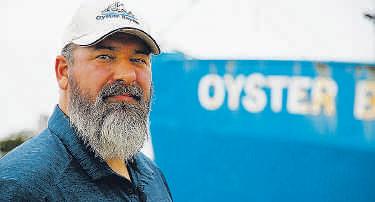
Michael pushed his sontofirstget acollege degree. The elder Dameron hoped adegree would giveAndrew moreflexibilityinhis lifechoices and potentially provide different career paths forhim in the industry
“Helovesthe industry, he lovesfishing, but he alsolovesdefending the industry,” Michael says.“One of thesedays, he could be in an office position, an executive position and Iwantedthatoption to be afforded to him.

Seeking away to further his education while continuing to do whatheloved, Andrew enrolled at the Texas A&MMaritime Academyin Galveston, Texas, whereheis currently working to complete his degree in maritime transportation
while alsoearning his captain’slicense
He’s even spenttime in between semesters gaining work experience on an Alaskan salmon vessel.
While Andrew wasskeptical of his father’s advice at first,heseeshis education and outside experience as assets to his futurefishing career
“Going to school wasone of the best decisions Ievermade,”hesays. “I’ve learned awhole lot and traveled awhole lot more than Ieverwould have done if Ihad just stayedinLouisiana.”
While manyofhis classmatesare hoping to work in the oil and gasorshipping industries following graduation, Andrew expects to carry on his family’s tradition in the menhaden industry.Heaspires to become amate on an Ocean Harvesters vessel and eventually work his wayupto captain, just likehis father
“It takes aspecial kind of persontobea fisherman,”hesays. “And youknow, Iwas raised forit.” Learn moreabout Ocean Harvestersand the menhaden fishery at menhaden.org.
STAFF
PHOTO
SOPHIA GERMER
CompanybehindBRbankexpands into northTexas
$83.6M deal adds nearly 40 branches, 400employees
BY STEPHANIE RIEGEL Staff writer
The parent company ofBaton Rouge-basedInvestarBankannounced Tuesday it will acquire Texas-based First National Bank, a dealthat will expand its footprint in the state and mark its entry into the rapidly growing Dallas market.
Under the terms of the deal, Investar Holding Corp. willpay $83.6 million in cash and stock for Wichita Falls Bancshares, First National Bank’sparent company
To helpfund the purchase, Investar raised $32.5 millionthrough thesaleofits Class APreferred stock.
Thedeal is the latest of several acquisitions forInvestarand its largest by far, according to President andCEO John D’Angelo.
“We’ve had amultistate strategy for anumberof years,” D’Angelo said. “But our previous (seven) acquisitionswere allmuch smaller.Weknew we’d come across abig deal like this. Thetimeisnow.”
star is the larger of the two.
Founded in 2006, Investarhas 29 branches and 329 employees in Louisiana, east Texas and Alabama.AsofMarch 31, it had $2.3 billion in depositsand $2.7billion in assets.

Thedeal will bring together two communitybanks with asimilar focus on personal banking and small-business loans, though Inve-
First National Bank, chartered in 1986, has seven branches in north Texas with $1.2 billionindeposits and $1.5 billion in assets.
Whencompleted, the deal will give Investar more than $4 billion in assets, $3.5 billion in deposits and 36 branches, 10 of which be in Texas.
“Morethan athird of ourtotal assets will be in Texas,”D’Angelo said.“Louisiana hasbeen wonder-
ful for us, but Texas is our fastestgrowing market.”
‘Optionality and flexibility’
Investar has humble roots that datetothe post-Hurricane Katrina boom year in Baton Rouge. It opened in asingle-wide trailer on Perkins Road and focusedona slow-growth strategy of acquiring small banks withassets of $500 million or less.
The seven banks it previously acquired all had assets of $250 million or less, D’Angelo said Tuesday.
In 2014, it went public in an offering that moved 3.3 million shares andgrossed $46 million. At the time, it had $674 millioninassets.
Though it hasgrownconsiderably since then, Investarisstill
relatively small. As of June 30, 2024, it was the 13th largest bank in Louisiana with less than2%of all deposits, according to the Federal Deposit Insurance Corp.
The acquisition of First National Bank will make Investar, itself, a moreattractive target foracquisition —a realityD’Angeloacknowledged.
“When you are running abank, everydayshouldbeabout building abank that has optionality and flexibility,” he said. “But we are not thinking about that right now
“Today,weare thinking about this merger and this partnership.”
Email Stephanie Riegel at stephanie.riegel@theadvocate. com.
Moving back home to save moneydoesn’t mean failure

Robert Frost had it rightin“The Death of the Hired Man” when he wrote that home is where “they have to take you in.” But here’swhat Frost didn’tmention: Sometimes going home is one of the smartest money moves you’ll ever make.

THE COLOR OF MONEy
Millions of young adults who have gone home to live with their parents find it boosts their financial well-being, no matter what the original motivation was. In 2023, 18% of adults ages 25 to 34 were living in their parents’home, according to aPew Research Center report.
This finding raises aprovocative question: Does livingwith your parents as ayoung adult indicate you’re afinancial failure?
Whenmythree adult children came home after college,my husband and Imade them adeal: No rent, but everydollar they would have spent on housing had to go into savings for their future. Iwrote acolumn about this arrangement.
Cue the typical criticism. “She claims they are savingfor
retirement, good grief,”one critic posted ona parentingforum. “She has lostall credibility.Ican’ttake herseriously.”
Another piled on:“It seems opposite to heradvicefor raising independent children.”
Butother parentssaw the logic: “She’slettingthem live at home to save. She says when she sees they aren’t doing that appropriately,she will start to charge rent. Sounds like averysmartset up to me.”
Exactly right.
Our two daughters pooled their savings andboughtahouse together lastyear —something that would havebeen difficult if they were paying rent, which can be as much as somepeople’smonthly mortgage payments.And our son is using hisrent-free time to go back to school to takesome accountingcourses.
Livingwith your parents doesn’t mean you’ve failed to launch. In fact, it can help you build some financial momentum before you jump outonyour own.
This strategy isn’tnew,which is why I’m reviving apast Color of Money Book Club selection, “Boomerang Nation: HowtoSurvive LivingWith Your Parents …the Second Time Around” by
Elina Furman— aguide that has proved even more prescient than Irealized when Ifirst chose it Furman has personal experience on this issue. After college, she moved in with her mother and older sister,and there she stayed for all of her 20s.
“Withnojob and no desire to learn the art of making mocha lattes at the local Starbucks, I moved back to my family home,” Furman wrote. “Withall the goal postsofadulthood —housing, economic independence, employment, completion of education —getting harder and harder to achieve, it’snot surprising that so manyofusare choosing toturn back instead of run ahead.”
When Iinterviewed herin 2005, Furman saidshe wrote the book to help those moving back home eradicate the notion that there’ssomething wrongwith them. The book is part therapy,part basic financial planning. Furman addresses just about every issue that can come up with going back home(or never leaving) —depression, guilt,dating, having to live in your old bedroom or the basement,being treated like a child again, acting like you’re a child.
She effectively uses personal testimonies and lists to get her pointsacross. For example, there’s“The Last Supper: Top10 Things YouShould Do Before Boomeranging.”
Furman wrote it might be time to boomeranghomeif:
n Youwake up in asweat from nightmares of credit-card and school-loan hell at least once a week.
n Youhave big goals forthe future (buying ahouse, saving for retirement, attending graduate school, starting asmallbusiness), but you have no idea how you will accomplish these things living on your own
n You’ve been hit by aseries of harsh life events andneed timeto regroup.
With humor and lots of common sense, Furman helps those who are living at homenavigate this trickyterritory.For instance, how do you deal with the touchy (pun intended) subject of telling adate you live at home?
“You can point to all the boomeranger statistics you want,” she wrote. “You can talk about the high unemployment rate and the failing economy until you turn blue in the face. But no matter what you say,it’stough to get out
those five little words —‘Ilive with my parents’ —when your sex lifeisonthe line.”
Iparticularly like the “KaChing! Minding Your Money” section. One of the top reasons people movehome is to save fora homeorgraduate school or to pay downdebt. But that often doesn’t happen. Without the responsibility of paying rent or utilities or other household expenses, many boomerangers have morediscretionary incomethan they’re used to and, as aresult, go hog wild spending when they should be saving.
Furman aptly lays out somebasic strategies to help people avoid wasting the opportunity
“Once you makethe decision to return to the nest, it’simportant to makegood use of your time there. After all, isn’tthis relatively financially stress-free period the best timetodeal with your money issues?”
Whatever the reason you moved back home, “Boomerang Nation” provides somehonest and humorous advice on dealing with the challenges of going homeagain. Email Michelle Singletary at michelle.singletary@washpost. com.

Beyond isn’taplace —it’samindset. Andit’sabeliefthathas poweredusfor over80years
We areJones Walker LLP,a firmdrivenbyanentrepreneurial spirit,adeepsenseofcommunity, and afierce determination to deliverexceptional serviceand valuefor our clients.
Since1937, our firmhas been committed to workingwithcommunity leaders to developbusiness opportunitiesacrossthe state. We aresteadfast in continuing ourdedicationtogobeyondinadvising clientsand supportinginitiatives andorganizations that make Louisiana abetterplace to live andwork
William H. Hines,ManagingPartner bhines@joneswalker.com
|TEXAS
D’Angelo
Michelle Singletary
Gallagherhas Louisiana industries covered.

Gallagher is oneofthe largest insurance brokerage, risk managementand consulting firms in theworld. With roots in Louisianadatingback decades,we’vegrown to become the leaderinthe stateaswell.
Leading theway in Louisiana. Gallagher serves awealthofindustrieshere, including:
Globalexperience.
As aglobal provider, Gallagher focuses heavily on data analytics and forecasting and benchmarking services,while offering thought leadership on such criticaltopics as cyber risk,social inflation and AI.Ifitaffects claimsand premiums, we areonit.
Louisianaexpertise
Gallagher enteredthe market with our first office in BatonRouge in 1991. Startingwith $5 million in revenue, we’veexpandedexponentially:
Acommitmentbeyond business. Ourteam is passionateabout taking part in opportunities to makeanimpact. From supporting local charities to hurricane relief efforts, we believe in giving back to the communities across Louisiana whereweliveand work.





REDISCOVER long-lostpassions
Creativity canboost health,Louisiana doctorssay
BY SHANTELLGOMEZ Contributing writer
Creativity and healthare more connected than many realize. Whenengaging in creative activities, like painting, singing, writing, dancing or problemsolving, energy flows. People canbecome more present, connected and physically energized
Licensed therapist and creative consultant CarolineHelmdidn’t discover her creative voice until shewas 28. Following Hurricane Katrina,after evacuating to Boulder,Colorado, she signed up for avoice lesson andwroteasong Ayear later,she startedabandwith five women.
“I was one of those peoplewho thought creativity wasn’t forme,”Helm said “Now Iknow everyone hasitinthem. Youdon’thave to be a‘creative type’ to create something.And youdon’t have to be goodatittobenefitfrom it.” Helm, aLafayette native, now uses creative expression as atool in therapy, helping people reconnect with playfulness, emotional flexibility and long-lost passions.
She sees how creativeactscan reduce stress, regulate the nervous system and evensupport physical well-being
“When clients come in, they’re often stuck in loops —relationship drama, work stress, family tension,” she said. “But as they beginexploring what makes them feel alive, you start to see ashift.”
That shift is more than anecdotal.A Drexel University study found that engaging in creativesessions can significantly reduce cortisol levels— thehormone linked to stress. Additional 2021
FIVE WAYS TO HELP FINDFLOW
Finding flow —that immersive, focused statewhere time slips away —can turna creative endeavorinto adeeply satisfying experience.
Psychologist MihalyCsikszentmihalyi, whocoinedthe term,described flow as thesecret to happiness: astate of complete absorption in an activity that challengesand energizes you.
Here are five research-backed ways to help youget there:
1. Find the sweet spot.
Accordingtothe book “Flow: The PsychologyofOptimal Experience, flow happens when the difficultyofatask intersects with your abilities —ifthe task is too easy,you getbored. If it’stoo hard most people getanxious.The sweet spot is just beyond your currentskill level, so that youcan be stretched but not overwhelmed.
2. Set specificgoalsfor your session. Attaining flow comeseasier when youknowexactly what you’re tryingto accomplish, according to “Handbook of Positive Psychology.”Cleargoalsgive your brain atarget, helping to reduce decisionfatigue and keep motivation high throughoutthe task.
research citedbythe National Institutes of Health connects consistent creative practice with increased happiness, better problem-solving, and reduced symp-
3. Pause distractions.
To reach the flow state, youhaveto concentrate —which is tricky to do if your phone, watchorcomputerisdinging multiple times aminute. Reducing external interruptions (likephone alerts) helps.
4. Multitasking is not flow’s friend. Multitasking is task switching.Flow requires deep concentration. Flowfeels good to the brain —multitasking,not so much. Multitasking prevents this by forcing your brain to constantly readjusttonew tasks.The cognitive load of constantly switchingbetween tasks canleadto mental fatigue and stress, making it even harder to concentrate and achieve flow according to the American Psychological Association.
5. Meditate. Practice mindfulness. Akey aspect of flow is being fully engaged in the present moment Meditation trains the mind to focus, managedistractions and regulate emotions —all crucialcomponentsof flow.Meditating increases the likelihood of achievinga flow state, according to research.
toms of anxiety and depression. Creativity can also support physical
Stay healthy outside forhot La. festivals
BY MARGARETDeLANEY Staff writer
Anationalheat dome brought brutal heat and summer weather acrossthe United States.But as the summer continues, it just gets hotter —aphenomenon Louisianans know well.
But asocial summer outside is notout of the question. Preparingtospend aday outside at the Louisiana Cajun-Zydeco Festival in NewOrleans or the Shrimpand Petroleum Festival in Morgan City can be daunting, but these tips can help to stay healthy
Dr.Jeffrey Kuo,the system medicaldirector of emergency management at Ochsner Health andleaderofhealthinitiatives for big events like the Super Bowl andJazzFest, said heat-related illnessesare common at these festivals.
“Ifnot managed appropriately, and if people are not prepared,” Kuo said. “This is can ultimately result in very severe or significant medical conditions or issues.” Kuo’sadvice: pre-hydrate. Before heading outside, even for short days in thesun, hydrating with waterand electrolytes is key to sustaining health throughout the day
“Everyone needs to be really vigilant about it,” Kuosaid. “Make sure that not only do you stay hydrated during the event, but you also pre-hydrate. Make sure that your tank is filledupbeforeyou even show up.”
WhenOchsnerHealth is available at events like the Junior Golf Association or FestivalInternational, Kuo’steams providewater stations and basic medical needs at medical tents. But patronsshould still bring their own water bottles.
“People need to monitor their own symptoms so that they recognize when they start to get weak, they’re starting to get dizzy, they’re getting lightheaded,that theyreally do need to seek medical attention,” Kuosaid. If planning forafestival, consider packing abag withthese items to monitor health while enjoying


















STAFF PHOTO By JILL PICKETT
cool
PHOTO PROVIDED By SHANTELL GOMEZ
Community membersjoin Basin Artsindowntown Lafayette for the annual WindowWanderings event celebrating creativity and movement.
HEALTH MAKER
La. doctor uses chess for brain injuries in athletes
BY MARGARET DeLANEY Staff writer
Dr Gregory Ward, a physician in Baton Rouge, works daily to restore and enhance the functional abilities of individuals who have experienced brain injuries His work involves various treatments, diagnosis and management of different conditions like brain and muscle injuries, neurological disorders and chronic pain to help patients improve their quality of life.

On April 24, Ward was invited by the NFL Players Association and the NFL Commissioner to discuss an innovative approach to brain recovery and rehabilitation. During the session, Ward explained how chess analysis can play a pivotal role in aiding athletes’ recovery journeys especially in the brain.
“It’s a totally different approach that we came up with. I thought chess would be a very nonboring but educational way to enhance recovery of brain injury,” Ward said. “That’s how I came up with the concept.”
The benefits of chess — its power to enhance strategic thinking and boost memory could potentially help athletes better understand and manage brain injuries, paving the way for improved recovery outcomes.
The recent surge in the game of chess inspired Ward to step into filmmaking, with Dr Ken Mask of Ken Mask Studios, to create several projects highlighting its impact. Ward collaborated on a
film, “Scandalous Moves,” about chess prodigy Paul Morphy It was followed by two documentaries: “Building Minds with Chess” and “Chess: Networking Over Boards.” Both documentaries were featured at the Cannes Film Festival in 2023 and 2024. Ward continues to explore the game-changing approach further in an upcoming lecture titled “Checkmating Brain Injury: Harnessing Chess for Neuro-Recovery and Rehabilitation” in August at the next NFL Players Association in Washington, D.C.
“Together, let’s champion the future of brain health in sports!” Ward said Tell me about how you found chess, how you fell in love with it.
I was a brain injury kid.
I had a bad accident when I was around 5 years old I remember going to my first day of class. I was little agitated, but I will always remember my mom kept me focused on certain things. For the first eight years in my schooling, I never studied spelling. When I heard a word, I just knew how to spell it. It was so funky. The brain is so fascinating. I started playing chess around the age of 10. My uncle, he was a chess player, and I was self taught Initially, when my mom bought me the chess set, I learned the moves by reading books.
My uncle transformed that book knowledge into actual use. He taught me different moves and the strategy of chess and how the pieces move across the
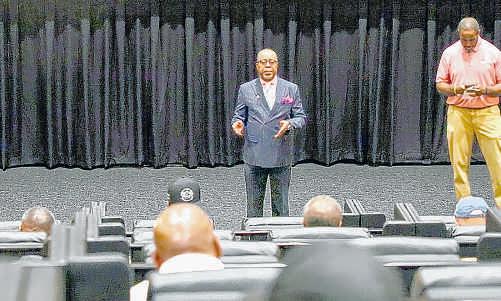
board.
Chess requires not only cognitive processing, but also spatial reasoning and concentration. It helps you anticipate the next move, or help anticipate what the other person’s next move might be. That’s almost like having two attorneys going after each other, and they’re trying to figure out who’s got the best argument
Some people say you learn a lot about a person playing golf, but I think you learn just as much about a person with chess. I consider chess like mental golf. I still play chess, but I slowed down once I went to college. It helped me with attention, concentration and memory, which was helpful when I was in medical school.
How can chess impact brain health in athletes?
Chess could potentially help us better understand
how to manage brain injuries, from improving recovery to also improving recovery outcomes. It could also increase confidence and enthusiasm when a patient is recovering and learning to trust the mind.
The science behind it has a lot to do with what I would call quantitative biology — that involves the use of mathematical tools to study biological systems. Understanding quantitative biology can provide insights on understanding brain injuries and recovery processes.
When you combine the strategic thinking and memory-enhancing benefits of chess and the analytical power of quantitative biology, individuals can have a more personalized and more effective brain injury recovery program.
The use of chess for health is evolving. I don’t
Nutritionists: You likely don’t need
BY MARIA CHENG AP medical writer
The human body needs protein. Proteins carry out countless functions inside cells and they are vital for the growth, repair and maintenance of muscles, bones and skin. And with food companies rolling out high-protein versions of a huge range of foods, including milkshakes and granola bars and even pancakes and popcorn — you might be tempted to think you need to add more to your diet.
But nutritionists say that if you are getting enough food, you are probably getting enough protein.
“Adding protein to foods is very beneficial — for the profits of that food,” said Federica Amati, nutrition
Continued from page 1X
health. The National Endowment for the Arts reports that participation in the arts can enhance immune system functioning, improve heart rate variability and support better cognitive performance, particularly in older adults.
Dance, music and visual arts have been shown to promote resilience and strengthen social connection, which improves overall well-being.
“Even if you’re terrible at it, when you’re creating, your body responds,” Helm said. “Your breath slows, your heart rate settles. It’s a reset.”
According to neuroscience research, engaging in creative activities activates the default mode network, a set of brain regions associated with self-reflection, memory and imagination. This activation can support emotional regulation and resilience.
Helm knows firsthand the emotional power of creativity. She avoided certain feelings for years until songwriting gave her a safe
lead at Imperial College London and head nutritionist at the health science company ZOE. “It is not based on health, it is not backed by science.”
The amount of protein you need depends on your age, weight and personal nutritional needs and it is especially important for children and older adults to make sure they eat protein-rich foods. Here’s what to know about how much protein you need and how to ensure you’re getting it from the best sources.
Protein is a macronutrient, or a basic kind of food like fat or carbohydrates that your body needs to function There are thousands of proteins, assembled from smaller molecules called amino acids — most of which can
be made by the body
“Because protein is so important, our body has adapted really well to making sure that it can reassemble and change the building blocks of these amino acids to make sure we have what we need, as long as we’re eating adequate amounts of food,” Amati said.
Still, the body can’t make all the amino acids, so some must come from food.
The World Health Organization recommends that healthy adults get about 0.4 grams of protein per pound of body weight. That’s roughly 60 grams for men and 50 grams for women per day, based on body weights of 165 pounds for men and 143 pounds for women.
In most rich countries, the average adult gets far
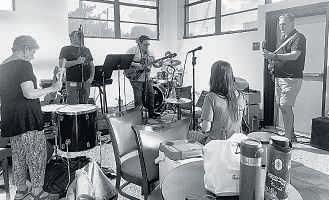
space to explore them.
“There were things I couldn’t talk about But I could sing about them,” she said.
Helm wrote an original musical imagining what happened to little orphan Annie as an adult It started as a creative impulse but the process became deeply therapeutic.
“Following that creative pull allowed me to explore old traumas and turn them into something liberating,” she said. “The healing didn’t stop with me. The actors and audience felt it, too.”
The National Endowment for the Arts reports that cre-
ative engagement supports both mental and physical health — enhancing immune function, improving heart rate variability, and boosting cognition, especially in older adults. Artistic participation also helps people process trauma, reframe difficult experiences, and build resilience. Multiple studies show that incorporating art and music into care settings can reduce pain, lower blood pressure, and shorten hospital stays inspiring some hospitals to incorporate the arts into practice.
Baton Rouge General’s Arts in Medicine program
think anybody right now, at any rehab center across the country, has involved chess for patients at this scope.
My quest is to include chess in brain injury programs.
Here’s how chess can impact the brain:
n Number one, playing chess can have a positive feedback on concussions.
Athletes in contact sports like football, rugby hockey they’re at a higher risk for these brain injuries.
When you implement a brain recovery program that includes chess, it can help with spatial training. Chess is a tactile game — it requires players to think and anticipate moves, but also physically pick up the pieces.
n Number two, when there’s cognitive training, individuals, especially for athletes like sports and golf and gymnastics, rely heavily on cognitive skills,
decision-making and focus and memory Chess can hone in on these skills and can enhance their abilities on the field (or on the mat).
n Number three, team sports involves quick decisions and coordination among different teammates. Training the brain with chess with players on the board, can help athletes in soccer basketball, volleyball, football and more. If you start training athletes, for example a football player after a head injury looking at Xs and Os, they can’t tell the difference between an X and an O. But if you put chess in their brain rehab program, putting chess pieces together that can only enhance their ability to recover and understand different plays and strategies.
How can chess help mental health?
We also talk about mental health as a major component in chess. Chess is good to reduce stress. The pressure of competition can take a toll on athletes. I think can help them manage stress effectively, and not only that, but also become better losers. Chess is known to be humbling. You learn to concede very early in the world of chess, and it’s a very formal loss. You shake hands and you walk away It’s not like when you get into a rumble in football, you want to beat up on the next guy We can all develop formalities from chess that you can incorporate in all different types of sports. We’re lacking a lot of class in our world today We could use some formality, and grace and patience.
foods with added protein
more, Amati said. Protein deficiencies are mostly seen in malnourished people on subsistence diet in poorer countries, she said.
Bridget Benelam, a nutritionist with the British Nutrition Foundation, said it was important to get protein from different foods, like dairy, fish, beans, nuts, vegetables and meat. She said studies suggest vegetarians and vegans have lower protein intake than meat and fish eaters, but that their average protein levels are still OK.
Having some protein at every meal is also a likely a good idea. “It appears to be better for preserving muscle function if you have some protein throughout the day rather than just having it all in one meal,”
uses evidence-based art and music activities as medicine to treat, heal and inspire patients.
The program began in 2012, and has since helped more than 115,000 patients, family members and hospital staff especially patients experiencing depression or anxiety — or for those not responding well to traditional medicine.
Kick-starting creativity
Not everyone needs to write a musical or start a band.
Helm encourages simple, low-pressure activities: doodling during phone calls, dancing in the kitchen or jotting down thoughts in a notebook. These small acts
Benelam said. Plant-based sources of protein include foods such as beans, lentils, peas, nuts, seeds, tofu, tempeh and meat substitutes. Fish, meat, poultry eggs and dairy foods such as milk and yogurt are also good sources of protein. Amati said that proteins from animal-based sources may be easier for the body to break down compared to plant-based proteins, which tend to have more fiber
“If you eat a piece of beef, you’re getting protein and things like zinc and iron, but you’re also getting more saturated fat,” she said. In comparison, Amati said eating protein-rich foods like chickpeas or beans also provides the body with fiber, something that’s lacking in most of our diets.
of creativity can reduce stress and invite emotional release.
Neuroscientist and danc-
er Dr Julia F. Christensen, author of “The Pathway to Flow,” compares learning an art form to learning a language Once a person internalizes its structure, she says, creativity allows the chance to “dance away from the here and now into a different reality that calms the mind and invigorates the body.”
That immersive state, often called “flow,” is more than a feel-good moment. According to Christensen, “There is evidence suggesting that regularly experiencing flow may be related to good health outcomes and
“Unless you have a specific health issue that requires you to have more protein, most people in countries like the U.S. and the U.K. do not need more,” said Benelam of the British Nutrition Foundation.
Amati, of Imperial College London, said people should scrutinize the ingredient list of protein-enriched products to make sure they aren’t loaded with sugar and fat.
For people trying to build more muscle, she recommended a more direct solution: exercise.
“If you’re worried about your body composition and muscle strength, you have to lift (heavier) weights and give your body a challenge,” Amati said. “Eating a protein bar is not going to help.”
protect against burnout and depressive symptoms. A creative practice linked to flow boosts creativity productivity, and even our ability to learn.” Flow states allow the brain and body to reset, and they can carry benefits long after the moment is over
“Tell your inner critic to take a hike,” Helm said, laughing. “Start creating anyway.”
In a culture that prizes productivity over play, creativity may feel frivolous. However, experts and therapists like Helm argue the opposite: creativity is essential.
Louisiana culture editor Jan Risher contributed to this piece.
WE WANT TO HEAR FROM YOU
The Louisiana Health section is focused on providing in-depth, personal accounts of health in the state.This section looks at medical innovations, health discoveries, state and national health statistics and reexamining tried and true methods on ways to live well.
Health editions will also profile people who are advancing health for the state of Louisiana.
Do you have a health story? We want to hear from you.
Email margaret.delaney@ theadvocate.com to submit health questions, stories and more.
Ward
PHOTO PROVIDED By SHANTELL GOMEZ
Participants at the annual Good Time Rock Retreat at Cité des Arts come together to learn, play and connect through music in a supportive, community-minded setting
PHOTO PROVIDED By DR. GREGORy WARD
On April 24 Dr Gregory Ward was invited by the NFL Players Association and the NFL commissioner to discuss an innovative approach to brain recovery and rehabilitation.
EatFit Live Fit
Sweetspot: Cut sugar with these naturalplant-based sweeteners


SAdded nu

prepar occurringsugarslikelactoseinyogurtor fructoseinapples.TheAmericanHeart Associationsuggestscappingaddedsugars at25gramsperdayforwomenand38 gramsformen.Ipreferaneventighter upperlimitof20gramsdailyforallofus. Artificialvs.plant-based Foryears,themostwidelyavailable sugarsubstituteswereartificial sweeteners—thepink(saccharin),blue (aspartame)andyellow(sucralose) packetsyouseenexttothesugarata
•Erythritolbehavesmostliketable sugarinthemixingbowl.Granular, confectionersandbrown-style
ofsweetness,erythritolforvolume, structureandsnap,andallulosefor moistureandshine.
MollyKimball,RD,CSSD,isaregistereddietitian withOchsnerHealthandfounderofOchsner’sEatFit nonprofitinitiative.Formorewellnesscontent,tuneinto Molly’spodcast,FUELEDWellness+Nutrition,andfollow @MollykimballRDand@EatFitOchsneronsocialmedia. Emailnutrition@ochsner.orgtoconnectwithMollyor scheduleaconsultwithherteam.
Sweetenerstrategies Dialbacksweetnessfirst.Tastefoodand drinksbeforesweetening.Thentryjusthalf ofyourusualsweetenerandgivetaste budsachancetoacclimate. Matchthetooltothetask.Steviaormonk fruitworkwellforbeverageslikecoffeeand tea,whileerythritolandalluloseperform nicelyinbakedgoods.
Blendfortexture.Two-thirdserythritol+ one-thirdallulosemakescookiesthatare bothcrispandchewy.
Study: Natural disasters may shape babies’ brains
BY EMMA COURT Bloomberg News (TNS)
NEW YORK Climate disasters are known for damaging homes, disrupting power and displacing residents. But even after the lights come back on and people return to their homes, their effects can linger including in the brains of children born afterward, a new study suggests. Climate stressors, and the effect they have on pregnant people, appear to affect the brain development of their babies, according to the study published in PLOS One this month, which relied on brain imaging conducted years after 2012’s Superstorm Sandy hit the New York City metropolitan area.
The study evaluated a sample of 34 children, 11 whose parents were pregnant during Superstorm Sandy By the time of assessment, the kids were roughly 8 years old. Those who had been exposed to Sandy in utero had a significant enlargement in a part
of the brain known as the basal ganglia. Parts of the basal ganglia were as much as 6% larger than in unexposed children, a change that could have negative implications for the children’s behavior. The parents living through the disruptions from a storm that displaced more than 23,000 people and suspended electric services in the area for days to weeks may have affected their offspring’s neurodevelopment, the researchers say The findings signal how new generations of children may be marked by climate crises that occur before they were born, and speak to a need to better evaluate and educate pregnant people about climate risks, the researchers say. They contribute to a growing consensus about pregnant people’s vulnerability to climate change, with extreme heat, air pollution and natural disasters posing risks like preterm births.
“This is something which people who are going to get pregnant should know and
be prepared,” says Yoko Nomura, an author of the PLOS One research and a professor at Queens College at the City University of New York. “Society as a whole has to have a strategy to protect those pregnant people.” Climate stress and the brain
Non-climate-related stress can affect pregnancies and influence fetal brain development. But studies typically haven’t examined how natural disasters may work in the same way Project Ice Storm, a project examining the aftermath of a devastating 1998 storm in Canada, found that stress had an effect on everything from kids’ temperament to their IQ.
Superstorm Sandy, which hit New York and New Jersey in October 2012, devastated coastal areas, leading to around 120 deaths and billions in damages. Queens College, in Flushing, New York, served as a shelter Nomura, who was already on the faculty there at the time, observed how distressed
storm evacuees in the oncampus gym were. Many of them were pregnant, and facing stressors like losing power and being displaced from their homes. That inspired Nomura to look into how the experience might affect their unborn babies.
While the team hasn’t yet determined how the changes they observed in the basal ganglia may affect participating children in the dayto-day, that part of the brain is involved in functions including emotional regulation Other studies have linked the basal ganglia to conditions like depression and autism.
“We do think that those changes we’re seeing could lead to negative outcomes for the children’s behavior,” says Donato DeIngeniis, the study’s lead author and a doctoral student in clinical neuropsychology at the CUNY Graduate Center
For a subset of seven children whose parents had been exposed to Sandy and separately, over the course of their parent’s pregnan-

cy extreme heat, the brain differences were more pronounced. Researchers observed that one portion of the basal ganglia was enlarged while another was reduced. “That might mean one area is impaired, which might lead the other to have to work harder to compensate,” DeIngeniis says, which is common in the brain in instances of brain damage or injury
The cohort of children examined in the study is small, reflecting the cost of brain imaging and the fact that the study’s recruitment was interrupted by the COVID-19 crisis. Even after recruitment resumed in 2021, participants were reluctant to visit for in-person imaging.
Burcin Ikiz, chair of the Neuro Climate Working Group, part of Columbia University’s Global Consortium on Climate and Health Education, calls the study “small but mighty.”
It’s increasingly important to understand how different climate stressors may together affect human health,
Continued from page 1X
the time outside in the sun:
n Sunscreen the best sunscreen, according to the Academy of American Dermatology, has broad-spectrum (UVA and UVB) protection, an SPF of 30 or higher and is water resistant
n Sunglasses to protect the eyes from strong UV rays
n A hat for extra coverage,
n Electrolytes to promote hydration
n A refillable water bottle
n A fan, either battery-powered or hand-held will do
n Hydrating snacks, like watermelon or apples.
“Seek shelter,” Kuo said. “Find shade so that you’re not exposed to the sun all day long.” Spending time in the sun can be enjoyable, but too much exposure to UV radiation can lead to serious health
she says. For instance, children in New Delhi are experiencing both air pollution and extreme heat. “And this is one of the first studies — that’s why it’s a trailblazing study — that looks at these joint things,” she says. But she added that additional work still needs to be done to address limitations of the study such as the small sample size, and to examine the effect of heat more in depth While the researchers used statistical methods to ensure the accuracy of their findings, it’s still possible that other factors could explain the differences seen in the kids’ brains, like genetic variability or socioeconomic status. The research team is now in the process of conducting a similar, larger study with around 80 participants so far But rather than wait to release those results, Nomura says they felt it was important to release earlier findings more quickly to raise awareness among the public.
risks, including sunburn, skin cancer, premature aging and eye damage. Children are especially at risk, making sun safety essential for everyone. Sun safety is easy and effective, according to Acadian Ambulance. Take these simple steps and enjoy the outdoors without the risk:
n Wear long sleeves, pants, a widebrimmed hat and sunglasses offer essential protection
STAFF FILE
PHOTO By BRAD KEMP
youngsters play in the water during the SWLA Juneteenth Music Festival & Stone Soul Picnic at Heymann Park on June 21 in Lafayette.
BROUGH TT OY OU BY
Molly Kimball RD,CSSD


CheyenneA. | OrthopedicPatient
OchsnerLafayetteGeneralUrgentCareoffersmorethanjust treatmentforcutsandcolds.Withorthopediccareinourlineup, patientscanreceiveX-raysandtreatmentforsprains,strainsand fractures—allwithouttheERwait.Whetherit’saweekendwarrior mishaporaweekdayworkoutinjury,OchsnerLafayetteGeneral UrgentCareisheretohelpyoustayactiveandstrong.
Visitochsner.org/lafurgentcaretofindalocationnearyou.

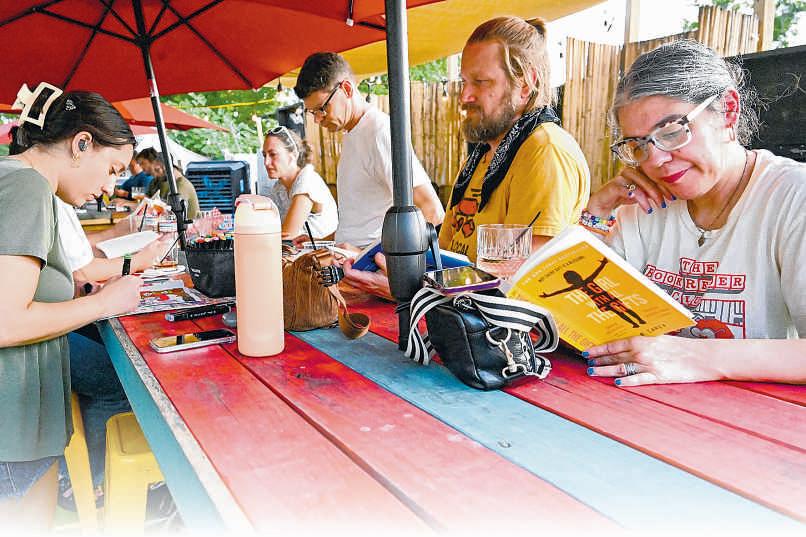


JanRisher LONG STORy SHORT
Patronsgather around to enjoy each others’ company.
An INTROVERT’S
party
Book club invitesliterarylovers to gather andreadindependently
BY COURTNEYBELL
Contributing writer
Thisclubtells members “Shh
…” atmonthly meetings,creates “bookish community” across Louisiana.
Thisbook club invites Louisiana literary lovers to “be alone together”astheyreadindependentlyfor a silent hour in cities acrossthe state. On the third Wednesdayofevery month, around 50 members of the Baton Rouge community gather to read, drink and ignore each other.
TheSilent Book Club in Baton Rouge offers introverted bookworms apage-turning paradise, inviting them to congregate and read in silence. The club does not have dues, attendance obligations or required reading. In fact, its only requirement is an hourofsilence once amonth.
“It’sjust anice community camaraderiewhere peoplecan go and be together.Alone,” said Joanna Walker,who startedthe club last year.
Members chatted with friends as tables filled before the club’s April 16 meeting. Butonce the clock struck 7p.m., attendees hushed. For the next hour,the onlyaudible noises from the Pelican to Marspatiowere flipping pages, clinking ice in eclectic glasses and fans blowing on acool Louisiana night.
Once thehourwas over,attendees resumed speaking to friends, introduced themselves to those around them or simply left. Oftentimes, Walker said members linger to so-
cialize,chatting with fellow book lovers about what they are reading.
“It kind of fosters this environment where you’re notforced to talk to people, but it just happens organically,” Walker said.“But there’sbeen manytimes that I’ve gone there and spoken to no one but the bartender.”
Walker startedthe unorthodox club last February to give residents relief from thehassles of required readings and uninteresting book selections. She teamed up withPelicantoMars andRed Stick Reads, alocal bookshop, to put on the monthly event. The partners were astonished at the club’sinitial turnout last year and have had steadily growing attendance since Silent Book Club began in San Francisco in 2012 after two friends becamefrustrated with the assigned readings traditional book clubs required.Since then, the organizationhas grownto1,700chapters in over 50 countries. There are sixregistered Silent Book Clubs in Louisiana,including chapters in Lake Charles,Lafayette, New Orleans,Denham Springs and two chapters in Baton Rouge.
“Baton Rouge,we’re notthat cool,” said Lara Harrison, the moderator of Red StickReads’ Taylor Swift book club. “Wedon’tdostuff like this. We’re known for our festivals, we’re known forour Mardi Gras, but this is like agood safe spaceofjusthanging out, drinking and Imean, you can talk; it’sjust a silenthourofjustreading.”
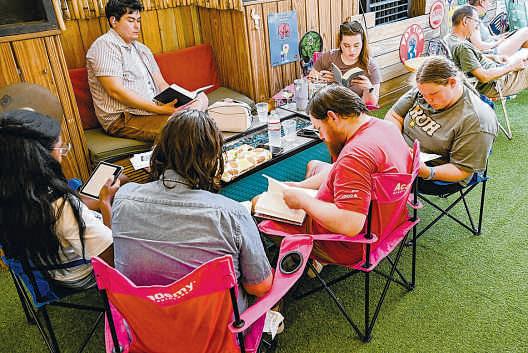
For some, the club marks anew kind of community wherereaders can share differing viewpoints in an approachable way.Katrina Stokes,the director of the EastBaton Rouge Public Library,enjoyed the group’sdeparture from traditionalbook clubs, finding it freeing to choose her own reading material while still being able to share her thoughts with others.
Stokes said the popularity of silent book clubs follows asimilar trend she saw followingthe COVID-19pandemic, when an influx of people used library resources, such as meetingrooms,and attended library programs for forms of humanconnection. She sees the high attendance of theseclubs,particularly by youngergenerations, as an exampleofpeoplelooking forcommunity in aunique way
“I really think it is very muchin humannaturetoseek out and form connections with other people …” Stokes said. “We’re all coming together for asharedpurpose, even though what we’re specifically doingmight be alittle bit different or maybe we’redoing somethingthat matchesour own interest. But then we get to turn around and share those with otherpeople.”
Sitting at apicnic table situated on fakegrass on the Pelican to Mars patio, Red Stick Reads co-owner Tere Hyfield alternated between surveyingthe club’s attendance and reading ayoung adult book. Hyfield said she was skeptically optimistic when Walkerfirstapproachedher about co-hosting the club.
Despite herinitial hesitation, Hyfieldsaid the Silent Book Club hasbecome herfavoriteclub the store offers because it brings so many Baton Rouge readers together.
“I feel, at the end of theday,readerslikethis. Like to talk to other readersand be like, ‘What are you reading?’”Hyfieldsaid. “Wewant to connect, and not just online. Ifeel like there’sahuge bookish communityinBaton Rouge, but Ijust feel like we’re separated. Thisisjust alittle place to get us together.
Below are upcoming Silent Book Club meetings across the state. Readers interested in attending a meetingcan find the chapter closest to thematsilentbook.club.
Baton Rouge: 6:30 p.m.Wednesday, July16atPelican to Mars
Baton Rouge: 10 a.m.to12p.m Thursday,July 26 at La Madeleine Perkins Rowe Denham Springs:6:30 p.m Wednesday,July 16 at Cavalier House Books New Orleans: 1p.m.to3 p.m. July 13th at Mojo on Magazine.
Having ayoung-adult daughter move to Coloradocomes with certainperks, particularlywhen youlive in Louisiana andsummer comes ’round. In earlyJune,my husband went to Denvertohelp ourdaughter,Piper, move across towntoher own teeny-tiny apartment near downtown.She moved thesame weekshe finishedthe first year of hertwo-yearstint withTeach forAmerica. She teaches 11th grademath in a charter school on theoutskirts of Colorado’scapital Iplannedmytriptosee herfor afew weeks later.I always feel better once I’ve spent time in theplaces wheremypeople live WhenI’m faraway,I like to be able to envisionthemliving their livesand doing theirthings.Piper was game to letmeplanthe bulk of ouractivitiesfor theweek, though sheraised an eyebrow when Iexcitedly toldher about thetwo tickets Ibought foran eventcalledPub Choir Yes, Ihad purchased thetickets before Imentioned them to her, but howcould someonenot be excited aboutPub Choir?I believed shewould rise to theoccasion. And, even through some initial reluctance, shedid. PubChoir started in Brisbane, Australia.Ona Tuesday night in Denver, Piperand Ijoined548 of ournewest friends at Denver’s BluebirdTheater,where we learned athree-part harmony version of Cher’s“Believe.” No auditions. No sheet music Just acome-as-you-are invitation to sing together.The whole thing was encouraging anduplifting beyond allexpectations. Transcendent,even, in theway music can be

AstridJorgensen is themastermind of PubChoir,whichjust completed itsAmerican tour. Aformer high school music teacher,she combinesmusical smarts witha wickedsense of humorand ahilariousslide deck to teach apopularsonginthreepart harmonytoamassive crowd in about90minutes.
Once we (andImean all550 of us)had learned thesong, we sang it,full volume,full hearts,asJorgensen’s videocrew filmedit. The eventwould’ve been fun on itsown, but Jorgensenadds asecret sauce. She’s an ace teacher, stand-up comedianfunny,selfdeprecating anda surprisingly great dancer.She starts thenight withthree rules:
n Be nice.
n Be quietwhennecessary. n No phones— be present. Remarkably,folks seemed to followthem.
Jorgensen’s voicedoesn’t go lowenough to teach thebass part, so sheuses an auto-tune mic to lead those lines. It makes hervoice sound low, somewhat creepyand ridiculous allatonce. She switches back andforth between mics allevening —the voicechange neverstopsbeing funny She hasdevised agraphic, intuitive wayfor nonmusicians
STAFFPHOTO By JANRISHER
Jan Risher and her daughter Piper Naudin, 23, waitinlinetoenter the Bluebird Theater forPub Choir
STAFF PHOTOSBy JAVIER GALLEGOS
Patrons at Pelican to Mars read silently during a recurring silent reading session
Lafayette’s greenspace protection squad
Reach spans from the horse farm to Moncus Park
BY LAUREN CHERAMIE Staff writer
Abbie Judice Acosta is the conservation director at Moncus Park in Lafayette, which includes 100 acres of diverse landscape, including 20 acres of bottomland hardwood forest. Though an arborist by training, Acosta also guides environmental education and conservation initiatives along with tree care at the park. She is an Acadiana Master Naturalist with a Master of Forestry from the University of Georgia with previous work as a planner for the Lafayette Consolidated Government and as a project associate for sustainable communities at the Lafayette Economic Development Authority
In terms of biodiversity in the park, are there any species or projects that you’re particularly focused on right now?
This past year, we’re focused on trails. Before that, we took a good look at our habitat for birds. There are ones that are declining slowly because of the human impact. We have done habitat restoration for those populations like purple martins — we’re really excited about how many we’ve brought to the site.
We get to work with Audubon Delta to band the birds, track their migration patterns and nesting rates Not only do we provide a habitat, but we’re part of something bigger That really pushes us forward in terms of conservation.
Have you had to implement any innovative solutions for the conservation in the park, being in an urban setting?
We’re very young, but we’re trying to make an impact and showcase what can be done with nature-based solutions. We’re not going to stop Lafayette from flooding, but we can show how to hold storm water and filter more storm water to help us be more resilient.
I also think of the urban heat island effect. We’re not New York, but it is a known fact that it’s hotter in the city So the more trees we preserve and plant the more we’re reducing temperatures in this immediate area and creating better air quality
Stormwater also comes to mind with our location at the base of the watershed Just down the street from us is the Vermilion River at River Pointe. Although we are not going to gobble up all the water that could flood the city, we are incredibly impactful and showing ways that you can use green spaces to hold more water, to filter more water

Q&A WITH ABBIE ACOSTA CONSERVATION DIRECTOR FOR MONCUS PARK
to make better landscapes. We use native plants a lot to showcase some of the super powers of nature.
What initiative are you most proud of as the conservation director?
I’m so proud of us for our Louisiana irises. We’re continuing to identify the cultivars that we have. There are five original Louisiana irises, and there is a large group of people who take the time and effort to create these beautiful hybrids out of the originals.
If you get a really good one, you can register it as a cultivar, so we have this collection of donated cultivars from the Society for Louisiana Irises that represents people’s hard work in making these beautiful, named cultivars. We got a handful of them identified, and we have around 300 named cultivars.
Preserving our heritage oaks is one of the reasons this property was preserved, and I love that we celebrate them the way we do. I’m personally proud of our trail network and the work we’re doing to make it accessible and friendly but also enhancing the habitat.
The Cajun and Creole communities have such a deep connection to the land and water Does that play a part in your conservation efforts in Acadiana?
I like to take a step back when we talk about the history of the park. We often get stuck on how cool it was that we’re connected to UL, and then there was this community campaign to save the horse farm. Now we’re a park conservancy, and we’re supported by the community But I think the beauty of our history and connection to this place goes back even further.
One of our conservation sites is a Cajun prairie, which is what this space would have looked like centuries ago. We have habitats

@theadvocate.com with details on the


that people can learn about. Being so close to the river, we would have been in the area where some Native American tribes would be using this land as part of their territory.
I like to connect all the way to the beginning. Fast forward a little bit, you’ve got the Acadian culture, the rich heritage between Vermillion River and Johnston Street. This would have been one of our early settlers’ properties. This little shotgun house of land We are super tied to the heritage of this site.
Of course, UL comes next, and we get the horse farm. We’re here today trying to look to the future of what else can we be to really reflect the diversity of this area
RISHER
Continued from page 1y
to follow along and encourages anyone who is confused to find the many music teachers in the audience who are surely happy to help them. Her goal is clear: for people to have an all-in, community experience, losing themselves in song. She talks a lot about the altos being in service to everyone else and works hard to give everyone in the room a chance to shine. Though reluctant initially, Piper said if Pub Choir comes back she’ll be there with bells on and take all her friends. She


appreciated the judgmentfree, all-in-it-together magic of making music alongside encouraging strangers as much as I did. She also said Jorgensen taught her a lot about teaching that she plans to incorporate into her math classes next year. Speaking of school, the next morning, Piper wanted me to see the garden she and another teacher are working to build as sponsors of the Garden Club. With their students, they are turning a dry patch of arid ground into something full of beauty and bounty They donate most of the produce to families in need who pick up weekly hauls through spring, summer and fall. Piper took particular pride in showing me the many plants that she had started from seed in her apartment. Denver’s growing season is much shorter than Louisiana’s. With the help of some grants they have been able to hire some of the students to help tend the garden through summer She was particularly proud of one nearly baseball bat-size green onion that was growing tall and strong. I said, “Well, that one is a bit past its prime, isn’t it?”
She said, “Mom, we’re not growing this one to harvest as a green onion. We’re growing this one for seeds
for next year.” I do love a metaphor, and that giant green onion felt like one I couldn’t ignore. Like those voices rising together at Pub Choir, the school garden is another act of belief: in growth, in community in what’s possible when people show up, pitch in, follow the instructions and have a little hope. I came to Denver to see where my daughter now lives, but I was happy to get a glimpse of the life she’s growing. Watching her plant all kinds of seeds musical, literal and otherwise — filled me with hope.
Email Jan Risher at jan. risher@theadvocate.com.
HOW YOU CAN HELP: VOLUNTEER OPPORTUNITIES
Louisiana Inspired highlights volunteer opportunities
Acadiana The Southern Mutual Help Association, 3602 Old Jeanerette Road, New Iberia, helps people develop
in
on agricultural and pervasively poor communities,
and people of color For volunteer opportunities, visit southernmutualhelp.org
STAFF PHOTOS By LESLIE WESTBROOK
Abbie Acosta, conservation director for Moncus Park, talks about one of several hiking trails at the park in Lafayette.
Park guests attempt to make a catch at the fully stocked pond in Moncus Park.
Piper Naudin, 23, washes freshly picked radishes at the school garden at KIPP Northeast Denver Leadership Academy
Naudin is the Garden Club co-sponsor with Courtnie Vickery. Both teach 11th grade math
STAFF PHOTO By
JAN RISHER
A purple martin flies into a grouping of bird houses at Moncus Park
Irises bloom near the pond at Moncus Park
A flock of mallard ducks gathers at a large rain puddle in Moncus Park.
SweetSpotfindscalling,brand in Louisiana
BY JOYHOLDEN Staff writer
Name, image and likeness deals for children are happening in Baton Rouge, but not the kind most people think of.
Instead of fast food and attorneys, SweetSpot, an accessible sporting goods company,has chosen five exceptional athletes to be their brand ambassadors fromMiracle League of Louisiana, anoncompetitive baseball league for children with physicalor developmental disabilities. SweetSpotchose Miracle League of Louisiana players Kaidence Brady,Molly Boulden, Jack and Parker Connison and Drew Moscona as their inaugural Players with Purpose ambassadors for the 2024-2025 seasons. Each received asuite of SweetSpot products and monetary sponsorshipsto help fund their individual athletic journeys.
Theprogramcelebrates inclusivity and determination by supporting young athletes of all abilities.
“The spotlighting of athletes that aren’tused to getting things like that is extremely special,” said Dustin Polito, co-executive director of Miracle League of Louisiana. “It’ssomething that they can help promote, which makes them feel special and feel like they’re apart of something that’s greater than whatthey’re used to being apart of.”
As apart of Players with Purpose, SweetSpot also partnered with the schools of the ambassadors—Red Stick C.A.R.E.S., St. Lillian Academy and St. Michael
theArchangel High School —and donated products specifically tailored to the needs of their students.
Red Stick C.A.R.E.S. offersprograms to improve the community’sbehavioral, mental andsocial health through human connection. St.Lillian Academy is anonprofit, K-12 school for children with communication andlearning challenges that serves kids ages five through 21.St. Michael the Archangel HighSchool is a collegepreparatory Catholic high school that offers a SWORD program for studentswith diverse abilities to accessacademics and extracurricular activities. To ensurethe donations best serve each school, SweetSpot conducted interviews with teachersto understand the unique needs of their students. Based on the feedback, the donations included customized product packagesdesigned to enhance accessibility and promote inclusive play.
SweetSpotCEO Joe Lawrence then personally delivered the products to each school, assistedwith assembling the equipment and joined students in playsessions. He said that daywas oneofhis proudest moments of the company.
“The donations from SweetSpotare such afun addition to our school,” said Mimi Guercio, the director of advancement at St. LillianAcademy.“The equipment is used daily by our students of all ages andgrades. It can be hard to find sports equipment that’sinclusive and suitable for ourvariety of kids,

but SweetSpot’sequipment hasprovidedaccessibilityand joytoour students each andevery day.
Thebackbone
Lake Charles native Lawrence takesplay seriously After selling hiscompany, Marucci, Lawrence was semiretired from the businessworld until Dave Soderquist, the original cofounder of SweetSpot,approached him with anew business ventureinspired by backyard play Lawrencesaid SweetSpot was the right thing for himatthisphase in his life. He and his partners relaunched SweetSpot in February of 2024.Although thecompanyisheadquar-

tered in Baton Rouge, they have distribution offices on the East andWest Coast.
Making sporting equipment accessiblefor children and people of differing abilities fulfills a passion of his, he said.His mother raised him around the United Way, and during high school, he spent alot of time with hishead coach’sspecial education students at Barbe High School
He saysthatthe ethosof SweetSpot is building confidence in children no matter their ability.SweetSpot’s products, which include pickleball paddles,golf clubs, flag football kits, footballs, baseball bats and
balls,are built for different skill sets, not just theelite athlete.
“It’sour job to make sure that families can get our products,get introduced to asport, and then take it on field,” Lawrence said, “and that they continue to have confidence and have fun. That is the backbone of what we do.”
One way SweetSpot has broughtthatconfidence andfun to thecommunity is through their relationship with Miracle League of Louisiana, which evolved fromthe Players with Purpose program to afull sponsorshipofthe spring season.
“We’ve seen adirect impact with our Mira-

cle League kids in how SweetSpot can help transform not only the way they feel about themselves,” Polito said, “but alsogives them something that they can utilize outside of Miracle League games to go homeand practice in their backyard.”
Notonly is the actual equipment accessible formultiple abilities, but theprice pointisalsoattainable.Lawrence says that SweetSpot wants their sportsand gaming equipmenttobeavailable forevery family,to encourage play forplay’s sake.
Email Joy Holdenatjoy holden@theadvocate.com.



























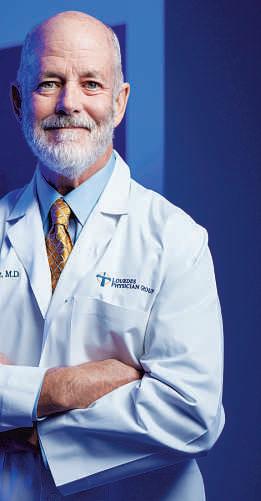









PROVIDED PHOTO
2024-2025Players withPurpose fromleft to right: Drew Moscona with hismother Erika Moscona, Molly Boulden, Kaidence Brady, Jack and Parker Connison.
Joseph Brierre,MD Hematology and Oncology
FAITH & VALUES
Gay, millennial priest on a mission
Reverend aims to pull the Episcopal Church out of ‘free fall’
BY KATHRYN POST Contributing writer
On a drizzly Sunday in June, the scent of smoke wafted into the sanctuary of Christ Episcopal Church in Shaker Heights, Ohio, as a handful of parishioners prepared a post-service cookout on charcoal grills. The aroma added an immersive effect to the sermon of the Rev Charles Graves IV who was preaching about the Holy Spirit’s arrival on Pentecost via flames, wind and in multiple languages.
“We continue to have to learn new languages of our communities as they change,” said Graves, waving his hands expressively as he spoke “We continue to have to learn new languages of generations as they change, and God continues to grow and shape and mold us and change us day by day.” His invitation to change wasn’t just for the approximately 60 parishioners in the pews, but for the broader Episcopal Church. Between 2013 and 2023, the historic denomination saw a 23% drop in membership, from just over 2 million to under 1.6 million.
Despite the numerical decline of many progressive mainline churches, Graves, 35, is part of a younger, more diverse generation of Episcopal priests optimistic about the denomination’s future — as long as it continues to evolve
“We’re at that moment where we know that what we’ve been doing for however long doesn’t work anymore, and that we have to try something new,” Graves told RNS in an interview in his church office. “Often, that inspires a willingness to change that you have the opportunity to lean into.”
Graves — a Black, gay, married priest who became rector of Christ Episcopal Church in September 2024 — has already been cautiously stoking that change on local and national levels, pushing the church to be more inclusive and accessible. Described as both “gentle” and “prophetic” by colleagues, this month, Graves was invited to preach during the Pride Sunday Holy Eucharist in D.C.’s Washington National Cathedral on June 1. He encouraged the hundreds in attendance and thousands watching online to “keep fighting
for the freedom of trans folks and nonbinary folks and so many in our communities under the yoke of oppression.”
But Graves’ passion is serving at the grassroots level, he said. For him, church looks like collecting diapers for immigrant families, speaking out with interfaith clergy against a local book burning incident and launching a community garden. Above all, it’s about fostering active, reciprocal relationships among church members and within the suburban Cleveland neighborhood.
Graves attributes his relational approach to ministry to his childhood in a thriving Black Episcopal congregation in Baltimore, Maryland. When his family joined St. James Episcopal Church in 1993, the parish was led by a dynamic priest named Michael Curry, who would later lead the denomination between 2015 and 2024.
“I didn’t know that the Episcopal Church wasn’t mostly Black, or that not every priest preached like Michael Curry,” said Graves, whose family has been in the Episcopal Church for seven generations.
Graves said the church was ahead of its time, welcoming same-sex couples without a second thought.
Despite his positive experience in the church, Graves was convinced his future was in politics, even after enrolling at Yale Divinity School in 2012. By the time he graduated, though, his priestly calling was clear In 2019, he took a campus ministry position serving students at three universities in the Houston area.
When the University of Houston shuttered its LGBTQ+ center in 2023, Graves teamed up with other LGBTQ+-affirming ministry leaders to revive programs that had been eliminated. His efforts to promote LGBTQ+ inclusion also emerged on a national scale within the Episcopal Church. He co-founded the LGBTQ+ Caucus, a group that proposes church policy changes related to LGBTQ+ inclusion. In 2022, the group helped pass 25 proposals, including mandating LGBTQ+ inclusion training for Episcopal Church employees and volunteers and establishing a denominational position focused on women’s and LGBTQ+ initiatives.
Graves has also been a member of the Episcopal Church’s Executive Council, an elected body that helps oversee denominational efforts,

since 2019.
For years, Graves was content fulfilling his ministerial calling outside a traditional parish setting, he explained. Then, last June, he visited Christ Episcopal Church in Shaker Heights
The church sits on a busy thoroughfare in a Cleveland suburb known for its early racial integration efforts. Martin Luther King Jr visited the church in the 1960s, and today it’s known for being “on the progressive edge of theology,” as one parishioner put it. Vestry member Paige Plumlee-Watson joined the parish with her wife in fall 2019 and told RNS its LGBTQinclusive reputation was a major draw
Since she joined, though, the church has been in a period of transition triggered by the COVID-19 pandemic and the longtime rector’s retirement. The neighborhood around the church, too, has been changing — a new housing development went up next to the church, and across the street a trendy market hall was built as part of a mixed-use development of restaurants, shops and upscale apartments.
The congregation’s response to those changes convinced Graves to take the job.
“They didn’t say, how do we get
more people to come to church?
How do we stop the church from shrinking? All that kind of desperation talk,” Graves said. “What they asked was, how do we engage more deeply with our community?
And that’s a very different question.”
Key to engaging with community, Graves said, is technology
After becoming rector last fall, one of his first tasks was to improve the quality of the church service livestream, noting anyone under 40 would “interrogate” the church’s website and social media.
Still, like many small parishes, Christ Episcopal Church has been dealing with financial constraints and staffing changes. Graves says in some ways, his church is a microcosm of the denomination, which is facing smaller budgets, restructuring staff and emphasizing local ministry These changes don’t need to be discouraging, according to Graves. In fact, he sees Christ Episcopal Church as part of an energetic movement within the denomination led by young clergy eager for the church to adapt.
The Rev. Zack Nyein, senior associate rector at St. Bart’s, a historic church in Midtown Manhattan, is also giving input as Christ Episcopal Church considers next
steps. He leads a Thursday evening worship community called Imagine Worship aimed at reaching “seekers and unchurched folks,” Nyein said. The service features a relaxed atmosphere and a blend of new and traditional music, and it often concludes with a shared meal. Its open doors and ambient lighting encourage passersby to stop in.
“Creating some of those soft spaces in person and online for folks to just come and see has been really crucial,” Nyein said. “I think in this moment, we can’t just put up the sign and say, ‘Come at 10 o’clock on Sunday’ and expect people to flock to us like they might have in times past.”
It’s models like these that make Graves hopeful about what’s to come — both for his parish and the denomination. He knows there’s no one-size-fits-all prototype for a thriving congregation, but as long as churches are willing to take risks informed by their relationships with the local community, he thinks there’s reason to believe the Episcopal Church will survive long past his own retirement.
“We’re not despondent about the future of the church,” Graves said. “We’re all leading the church toward a very different future.”
Rise of shared electric cargo bikes changing cities
BY AINA DE LAPPARENT ALVAREZ
Contributing writer
Editor’s note: This story, created by Aina de Lapparent Alvarez for Reasons to be Cheerful, is part of Solutions Story Tracker Louisiana Inspired features solutions journalism stories that provide tangible evidence that positive change is happening in other places and in our own communities solutions that can be adopted around the world
Last December, Tim Reardon zipped through the busy holiday traffic of his Boston neighborhood of Jamaica Plain, transporting gallons of eggs, milk and heavy cream for his yearly Christmas eggnog extravaganza, all on just two wheels. Reardon, an avid cyclist who doesn’t own a car, can be spotted once a month transporting goods like Christmas trees and rugs — sometimes along with his daughter — in the yellow front cargo compartment of a rented electric bike. For Reardon, biking turns these mundane errands into thrilling adventures.
“It’s a form of freedom,” he says “What moves me is my feet and this little motor that’s in there I’m not inside a box and I’m not trapped in with everybody else.”
Reardon rents bikes from CargoB, which launched in spring of 2024 with a small fleet in the Boston area. It’s one of a growing collection of on-demand cargo bike shares across the country Especially in dense urban areas, cargo bikes make transportation faster and more accessible, making it easier to avoid rush hour and save money by reducing car use. These bikes usually have electrical assistance, making hauling heavy loads easier In the U.S., cargo bikes, especially electric ones, are in their infancy but their popularity is on the rise.
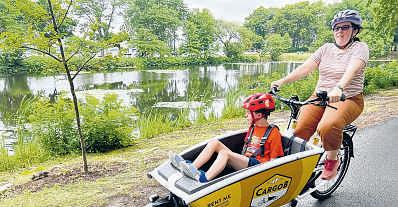
Price is a key factor Renting an electric cargo bike from Bostonbased CargoB is about $10 to $12 cheaper per hour than renting a car CargoB charges by the minute, so Reardon only pays for what he needs.
But buying a cargo e-bike is another story. The cargo space makes such bikes a practical choice for families, but the $6,999 price tag is a barrier for many. Jimmy Lizama, a long-time bike advocate, has never owned a car Lizama is the founder of the Los Angeles nonprofit Re:Ciclos. Re:Ciclos works to increase access to cargo bicycle technology and empowerment of youth in Black and brown communities. He used to be against e-bikes. But as his son — Lizama’s usual cargo — grew bigger, the hills of Los Angeles proved impossible to climb without a motor Having experienced the difference, Lizama admits that e-bikes make biking more feasible in the city
“We’re going from the idea that you are self-contained in a box that is air-conditioned, that goes 35 miles, 60 miles an hour, and to compete with that consciousness is very very very difficult,” Lizama says. “We have to do anything we
can right now to create bridges for folks to understand that mobility can be a lot more responsible, fun, easy and healthy.”
To help achieve that, Re:Ciclos builds cargo and regular bikes, takes on interns and is working on partnering with the city’s transportation agency by repairing bicycles abandoned on their system and redistributing them to people in need. While Lizama wants to encourage human locomotion over electric bikes, Re:Ciclos does make electric bikes. He encourages those wanting e-bikes to consider cargo as “potentially the best technology to replace cars especially in the sprawl of Los Angeles.”
However, being a grassroots organization can make funding hard to come by Right now, Re:Ciclos is only working on two bikes, versus a previous high of 50 per year E-bike lending is also complicated due to Re:Ciclos’ focus on recycling, Lizama notes.
Back in Boston, CargoB co-founder and CEO Dorothy “Dot” Fennell chose the for-profit start-up model for its cargo e-bikes.
Fennell, who previously worked in city transportation planning, says having a professional front
with an app, insurance and the resources to maintain the bikes helps attract new customers, partner businesses and cities. She and cofounder Zack DeClerck also go to every Open Streets event in Boston.
“It becomes kind of a spectacle and I’m happy to be the carnival barker bringing you in [on] this wacky thing,” Fennell says. “And if I got that hook, you’re like, ‘Oh wait a minute, I can take [a cargo bike] out to the grocery store or I can take it down to the park.”
That approach is working, according to Fennell. CargoB is generating revenue and has 700 subscribers, a quarter of whom are regulars. People are also asking for bikes in more locations.
However, there’s a long road ahead. For one thing, Fennell and DeClerck have not yet been able to take paychecks. And looking at the future of cargo e-bike shares more broadly, Fennell isn’t sure they could be successful in less dense parts of the country CargoB focuses on “short-distance trips in cities, because that’s where you have all these different land uses in one place,” Fennell says. “The best way to make them all mesh together is having a vehicle that’s right-sized to move in between all these places.”
Right now, they have seven cargo e-bikes, with 10 to 15 more that will launch by the end of 2025. Fennell dreams of building out CargoB across the Northeast and the Midwest
Another critical expansion need is beyond the most common cyclists: “MAMILs,” an acronym for “middle-aged men in Lycra.” Boston Bike Mayor Vivian Ortiz is especially invested in making biking more inclusive, and she thinks cargo bikes could help. Ortiz lives in the Mattapan neighborhood, which is 72% Black. Mat-
tapan is an underserved neighborhood with more speeding, unreliable buses, higher crash rates and more pollution than the average neighborhood, according to a 2021 report by Boston Planning & Development Agency
When she went on a ride with Fennell, Ortiz was surprised at the number of people who stopped them and asked about the cargo bike. It was a far more enthusiastic response than what she usually gets when asking her neighbors to go ride with her
But she points out that Mattapan will need a lot of infrastructure and safety measures put into place before cargo bikes are a reasonable option. Ortiz says she is “confident but never comfortable” riding some of the avenues. There are also cultural barriers. Whenever Fennell, who is White, and Ortiz, who is Black, bike together, they are not quite seen the same way, Ortiz says: “They would look at her and say ‘Oh, she’s riding her bike for her health and for the planet.’ And I’m riding my bicycle because I’m poor.”
Right now the city is planning to build a bus lane and a bike lane along a congested neighborhood avenue. There has been some pushback from residents, though. Ortiz said they argue, “Black people don’t bike. Why are you doing this in our neighborhood?” Ortiz hopes to change this perception. She is busy laying the foundations for bikes, cargo or otherwise, to flourish in her neighborhood. She tells her neighbors that buses and bikes should be prioritized over cars, and she has spotted where the first CargoB e-bike could be parked.
She also asks everyone, be they a cab driver or a child: “Do you bike?”
PROVIDED PHOTO By AMANDA KOEHN
The Rev. Charles Graves IV, left, speaks with parishioners at Christ Episcopal Church on June 8 in Shaker Heights, Ohio.
PHOTO PROVIDED By CARGOB
The cargo space makes cargo e-bikes a practical choice for families.
SUNDAY, JUlY 6, 2025




CURTIS / by Ray Billingsley
SLYLOCK FOX / by Bob Weber Jr



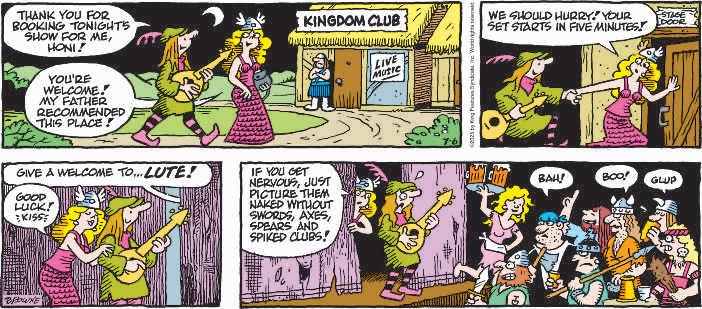


GET FUZZY / by Darby Conley
HAGAR THE HORRIBLE / by Chris Browne




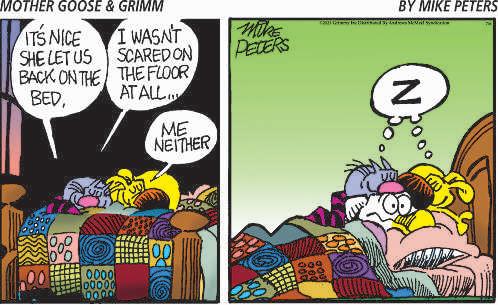

MOTHER GOOSE AND GRIMM / by Mike Peters
ZIGGY / by Tom Wilson
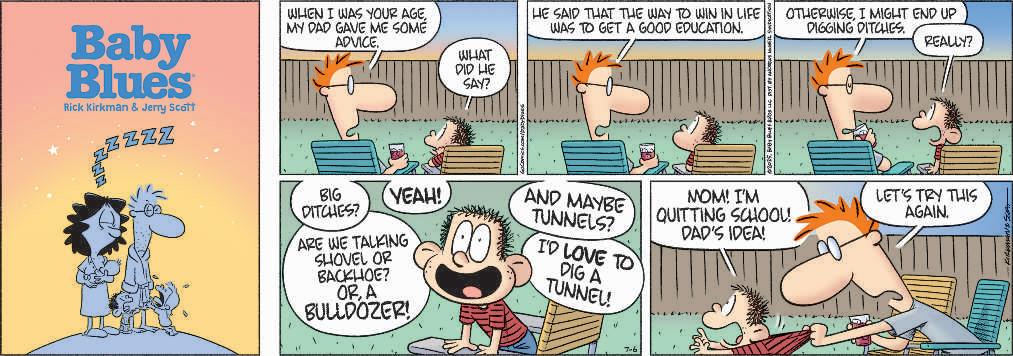





ZITS / by Jerry Scott and Jim Borgman
SALLY FORTH / by Francesco Marciuliano & Jim Keefe






PEARLS BEFORE SWINE /byStephan Pastis


directions: Make a 2- to 7-letter word from the letters in each row Add points of each word, using scoring directions at right. Finally, 7-letter words get 50-point bonus. “Blanks” used as any letter have no point value All the words are in the Official SCRABBLE® Players Dictionary, 5th Edition.
word game
instructions: 1. Words must be of four or more letters. 2. Words that acquire four letters by the addition of “s,” such as “bats” or “dies,” are not allowed. 3. Additional words made by adding a “d” or an “s” may not be used. 4. Proper nouns, slang words, or vulgar or sexually explicit words are not allowed.
todAY's Word — MirAcLe: MEER-uhcul: An extraordinary event manifesting divine intervention.
Average mark 38 words Time limit 60 minutes
Can you find 54 or more words in MIRACLE?


ken ken
instructions: 1 -Each rowand each column must contain thenumbers 1through4 (easy) or 1through6 (challenging) without repeating 2 -The numbers within the heavily outlinedboxes, called cages, must combine using thegiven operation (inany order)toproduce the target numbersinthe top-left corners. 3 -Freebies: Fillinthe single-boxcages withthe numberinthe top-left corner
instructions: Sudoku is anumber-placing puzzle based on a 9x9 gridwith several given numbers. The object is to placethe numbers 1to 9in theempty squares so that each row,each column and each 3x3 boxcontains the same number only once. The difficultylevel of the Conceptis Sudoku increases from Monday to Sunday
directions: Complete thegridso that numbers 1–132 connect horizontally, vertically or diagonally

Sudoku
Which game?
North did not know how many spades to bid at his second turn, so he made a cue bid to see if he could learn anything more from his partner South felt his two kings, opposite North’s strong bidding, warranted a game bid and he made the good bid of three no-trump North, with his flat hand, saw no reason to disturb that contract and passed. Nice bidding.
South won the opening club lead in hand with the 10 and led a low spade. West played the king and South won with dummy’s ace The jack of spades from dummy was won by West with the queen, and West cashed the ace of clubs and continued with the queen to South’s king. That set up West’s long clubs, but West had no entry to enjoy them.
Edited by Rich Norris and Joyce Nichols Lewis
super Quiz
SUBJECT: MOVIE QUOTES
Provide the missing word. The source is provided. (e.g., “There’s no place like ___.” “The Wizard of Oz.” Answer: Home.)
FRESHMAN LEVEL
1. “I’m the king of the ____!” “Titanic” Answer________ 2. “Life is like a box of ” “Forrest Gump” Answer________ 3. “Show me the ____!” “Jerry Maguire” Answer________ 4. “I feel the need, the need for ____!” “Top Gun”

Tannah Hirsch welcomes readers’ responses sent in care of this newspaper or to Tribune Content Agency inc., 2225 Kenmore Ave., Suite 114, Buffalo, Ny 14207. E-mail responses may be sent to gorenbridge@ aol.com. © 2025 Tribune Content Agency
South knew that West had no entry so he could afford to play a heart to dummy’s 10. When that forced the king from East, South claimed 10 tricks Note that a four-spade contract by North-South would have failed, probably by two tricks after a heart lead. Declarer could hold it to down one, but he would have to give up his reasonable chance to make it by taking the heart finesse.
CANCER (June 21-July 22) Give yourself credit for being unique and having insight into what works for you. It’s time to please yourself and let others do their own thing. Nothing ventured, nothing gained.
LEO (July 23-Aug. 22) Refuse to let your emotions interfere with rationality Social and domestic matters will lead to controversy Let your choices take others by surprise. Gain momentum and lead the way VIRGO (Aug. 23-Sept 22) Participate, and your actions will set you up for plenty of options. You
must choose what you can afford and where to make the most significant impact. Be open to suggestions. LIBRA (Sept. 23-Oct. 23) Emotions are high; ignoring what requires attention will lead to unnecessary setbacks. Make physical changes to your domestic environment to satisfy your needs and appease anyone within your sphere.
SCORPIO (Oct. 24-Nov. 22) Be careful not to overextend yourself financially or physically Being too generous with your time will lead resentment. Put your needs first and pace yourself.
SAGITTARIUS (Nov. 23-Dec. 21) Emotional situations will bring you closer to a loved one. Commit to something that will improve your life. Sharing ideas and expenses with someone special will help you achieve your goals.
CAPRICORN (Dec. 22-Jan 19) Pay attention to what’s going on in your community A change of scenery will lead to playful action and a change of heart. An investment will pay off.
AQUARIUS (Jan. 20-Feb. 19) Changing your attitude, helping others and being part of the solution will stir up emotions. Personal and
physical upgrades to your surroundings will be rewarding. PISCES (Feb. 20-March 20) Expand your interests and friendships. What you say will impact others, but your actions will drive home the validity of your aspirations. Don’t hesitate; act now ARIES (March 21-April 19) The time you spend on home and domestic matters will pay off. Participating in an event or cause with loved ones will bring you closer together
The horoscope, an entertainment feature, is not based on scientific fact. © 2025 by NEA, inc., dist. By Andrews McMeel Syndication
TAURUS (April 20-May 20) You are overdue for a change. It’s essential to stretch your mind and let your creativity take the lead. Attend an event or engage in an activity that motivates you to try something new GEMINI (May 21-June 20) Pay attention to detail. Observe how others respond. Recognize when someone is trying to scam you. Protect your money, your identity and your reputation. Stick close to home and to the people you trust.
goren Bridge
Answers to puzzles
1. World. 2. Chocolates. 3. Money.4.Speed. 5. Paris. 6. Boat. 7. Johnny.8.Sorry.9.Back 10. Communicate.11. Truth. 12.Problem. 13. Baseball. 14.Mother.15. Alone.
SCORING: 24 to 30 points —congratulations, doctor; 18 to 23 points—honorsgraduate; 13 to 17 points —you’replenty smart, but no grind; 5to12points —you really shouldhit the booksharder;1point to 4points —enroll in remedial courses immediately; 0points who reads thequestions to you?
Cryptoquote Answer
We're all just walking each otherhome.— Ram Dass
word GAme Answer super

sudoKu Answer jumble Answer

Crossword Answers
sCrAbble Answers

wuzzles Answers
Ken Ken Answers hidAtoAnswers



jeFF mACnelly’sshoe/ by Gary Brookins &Susie MacNelly

